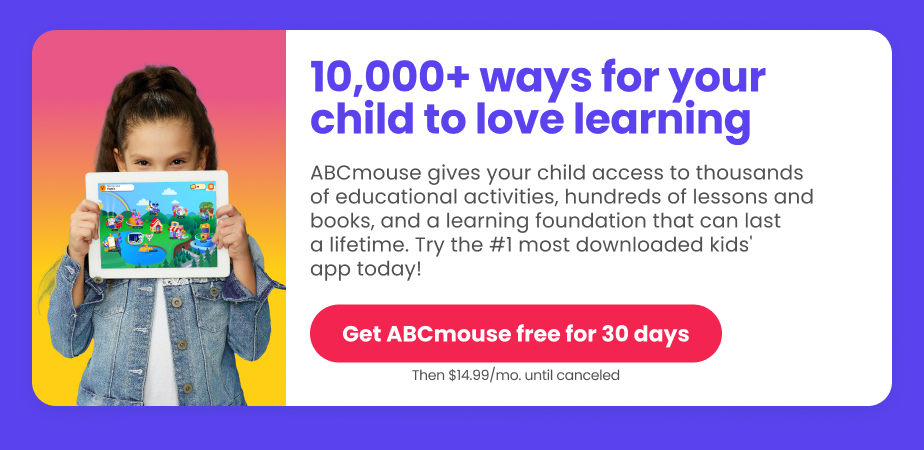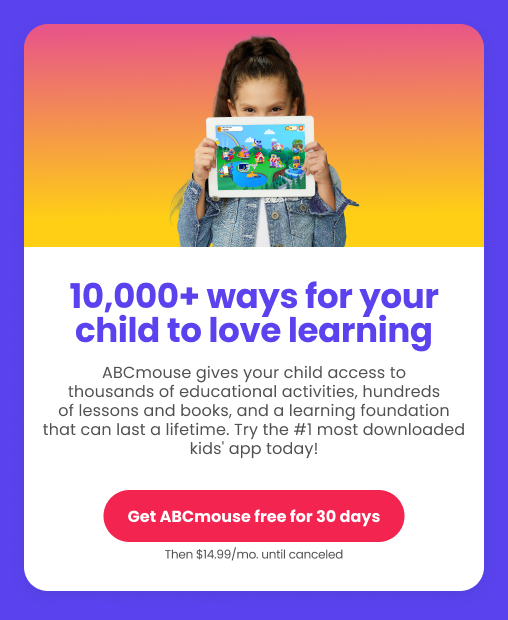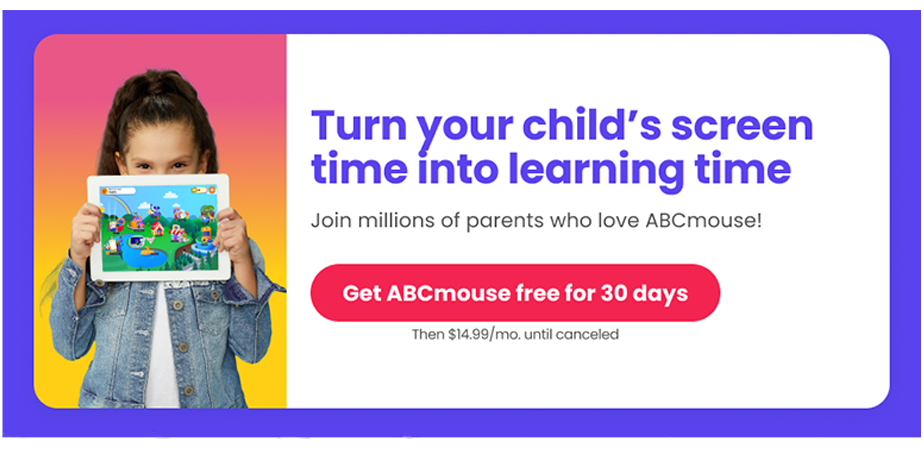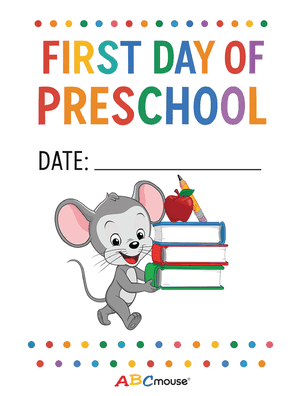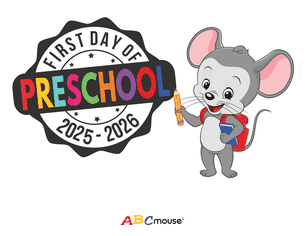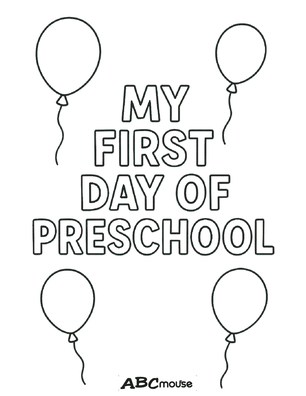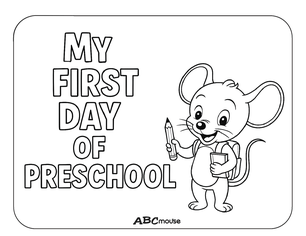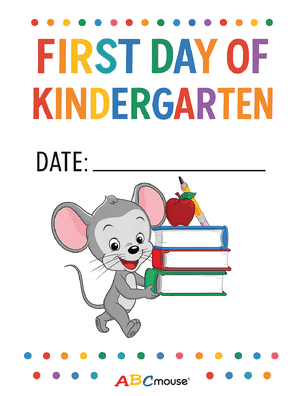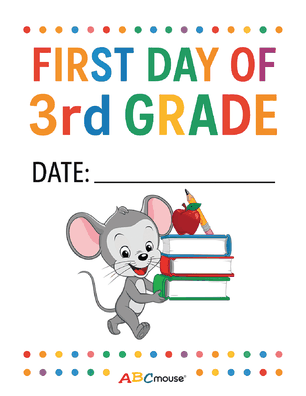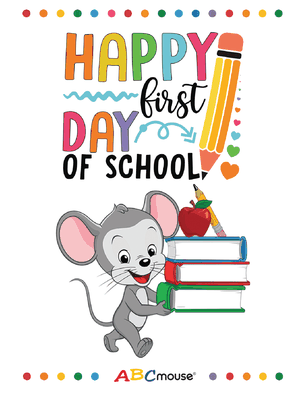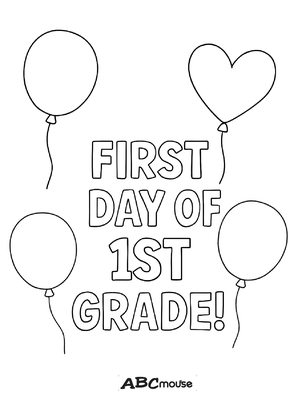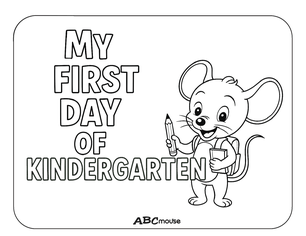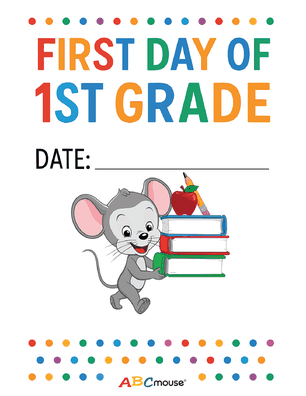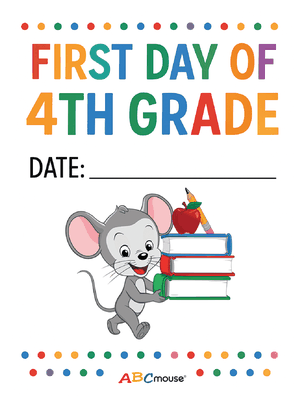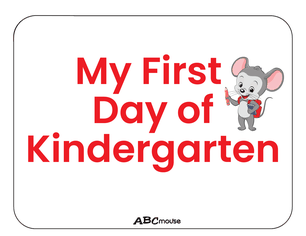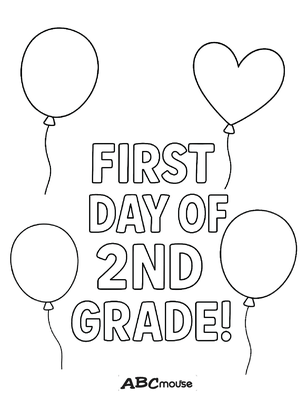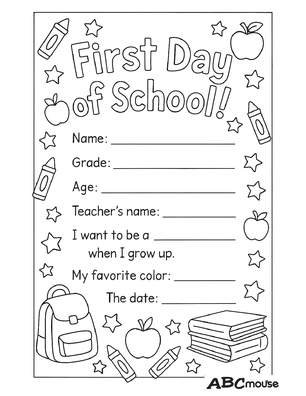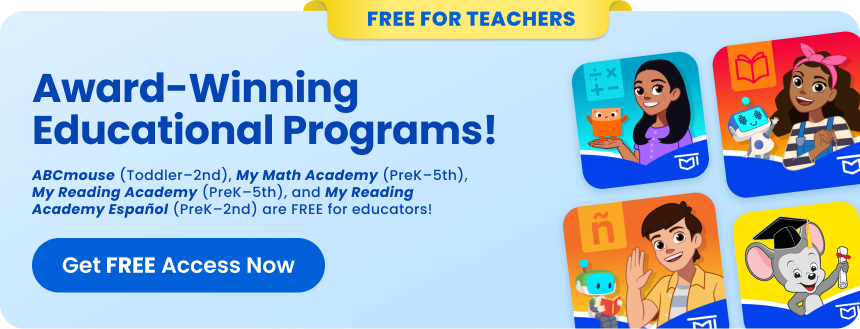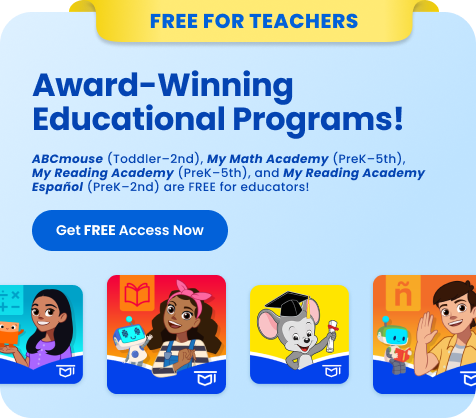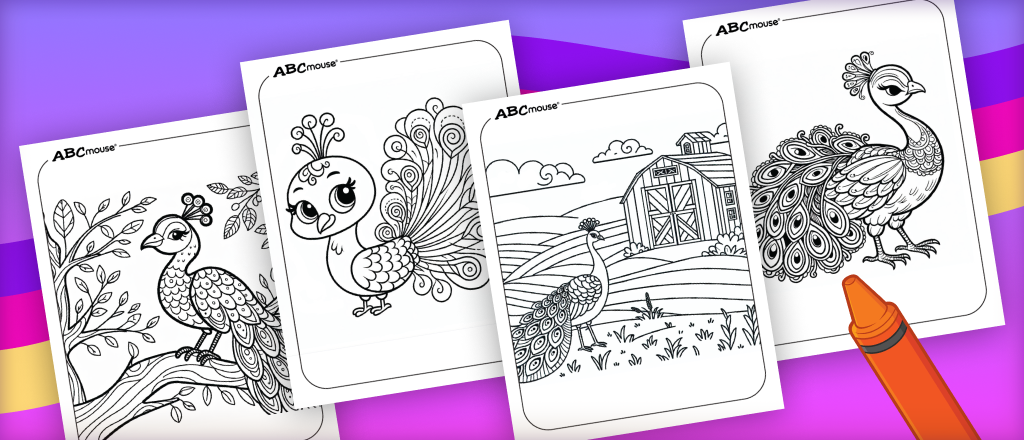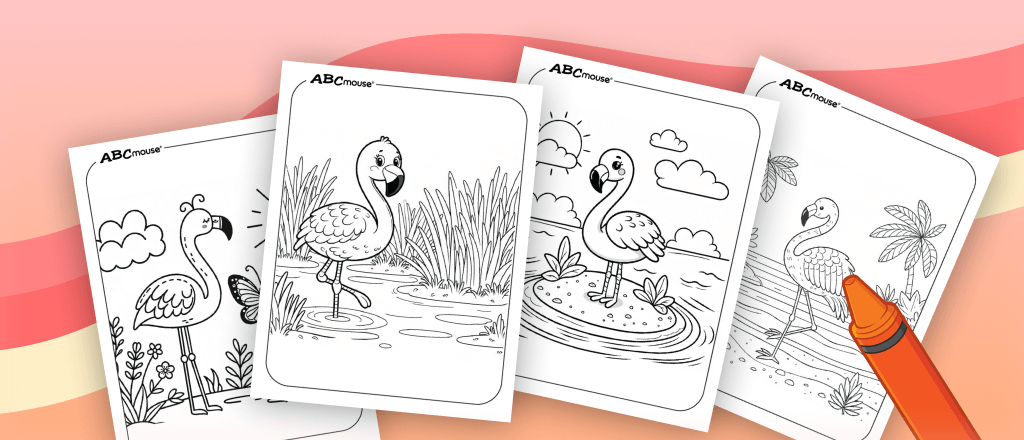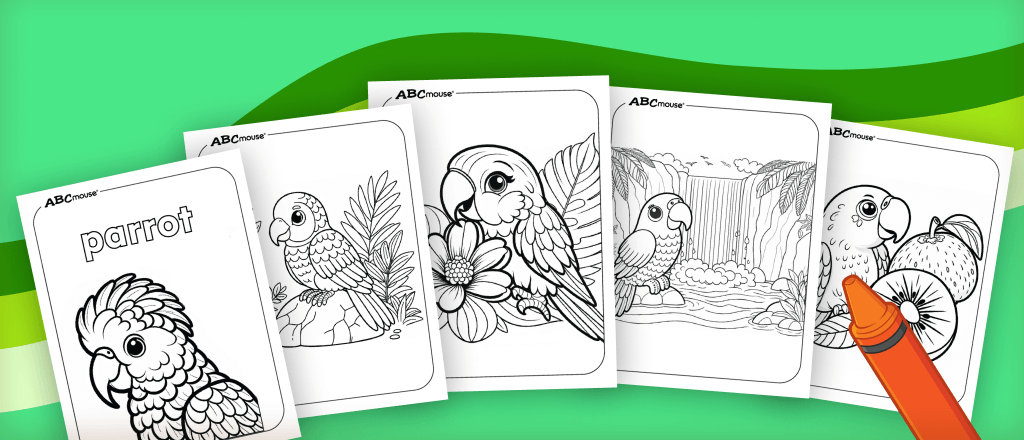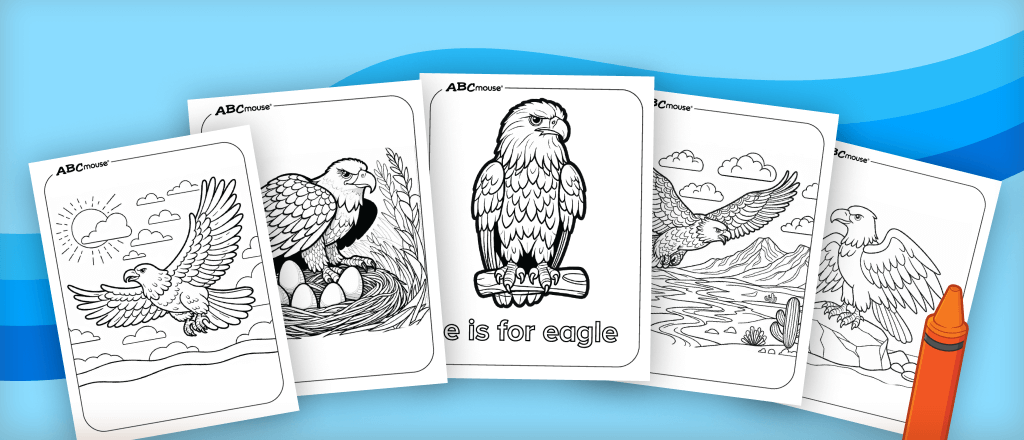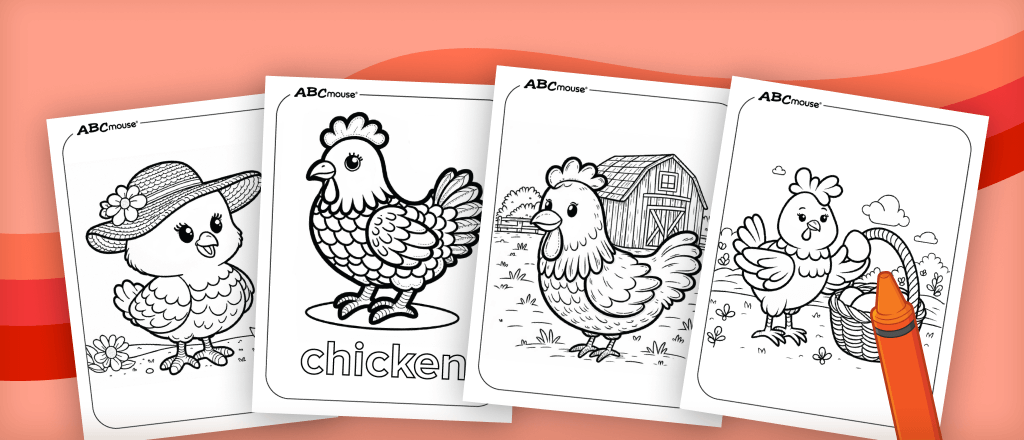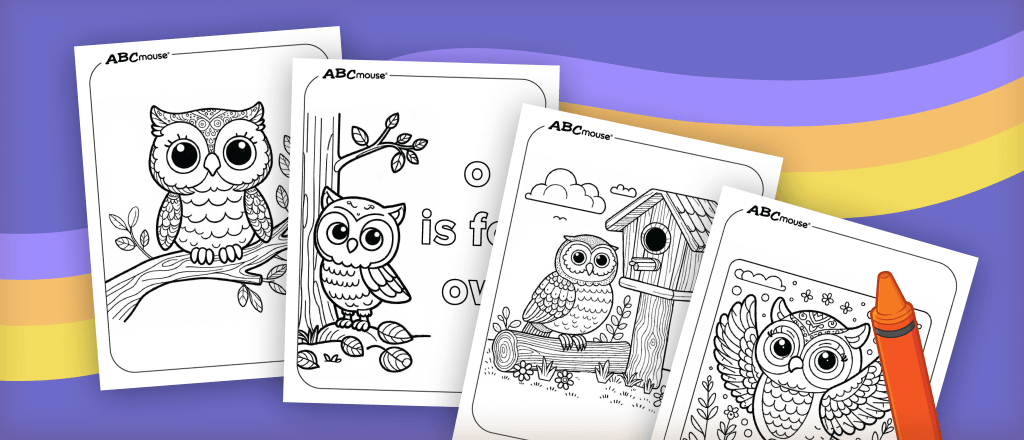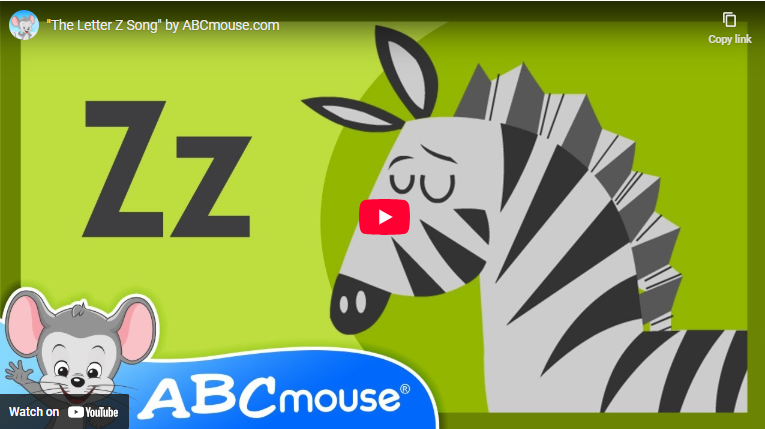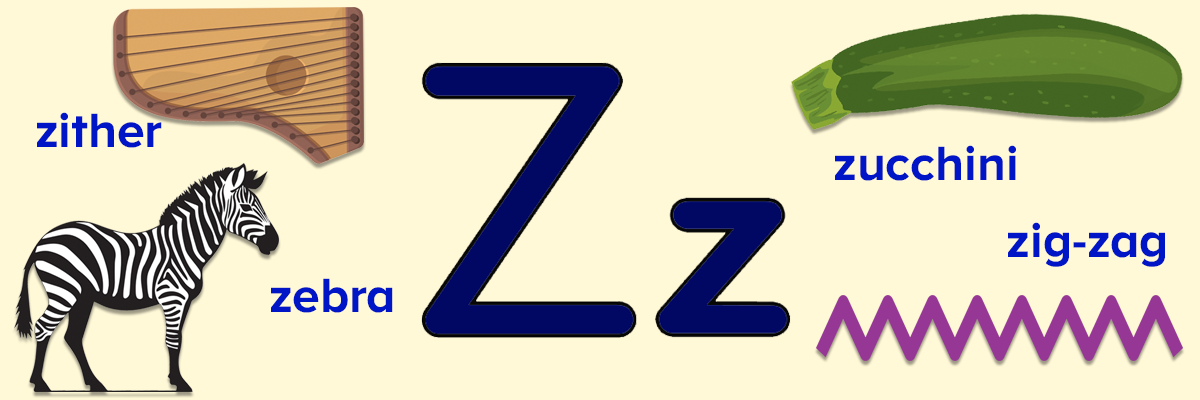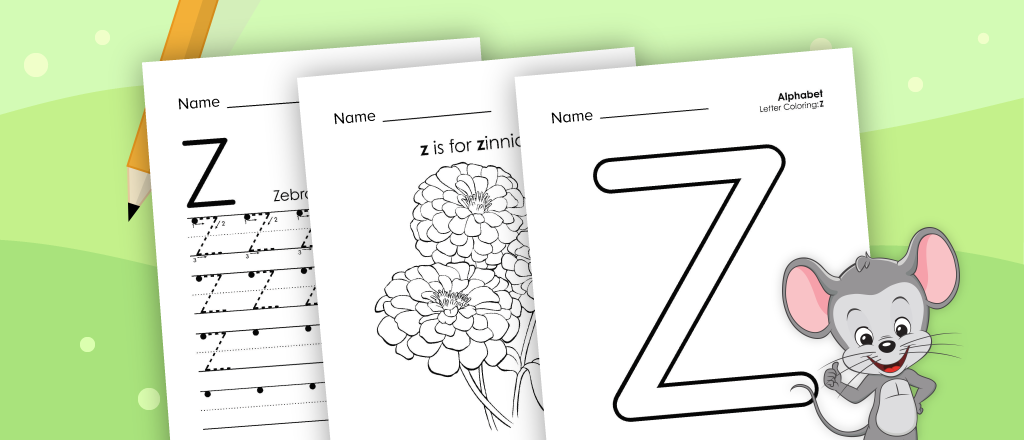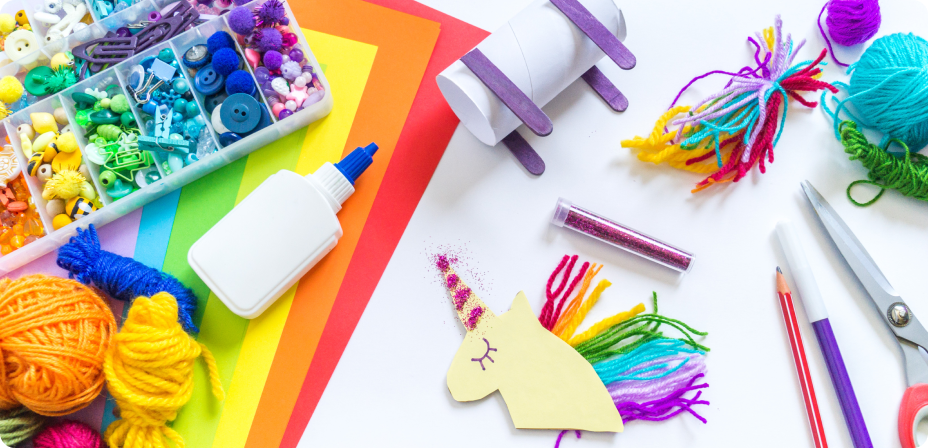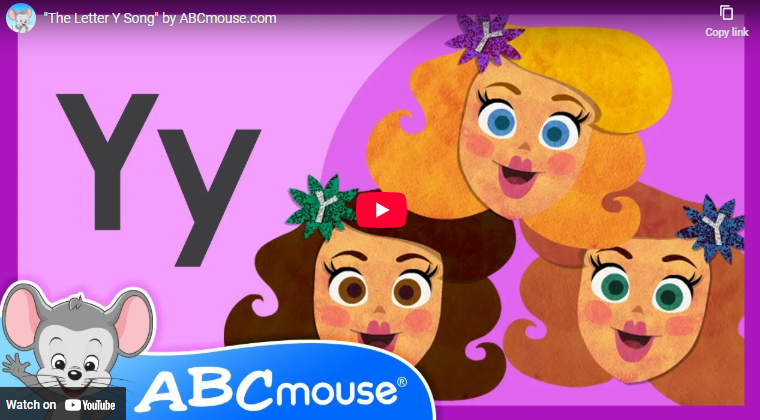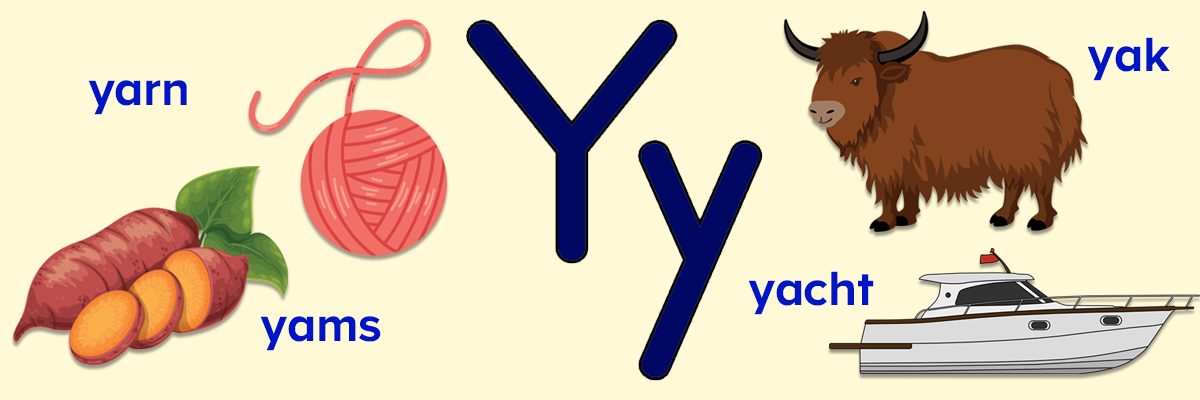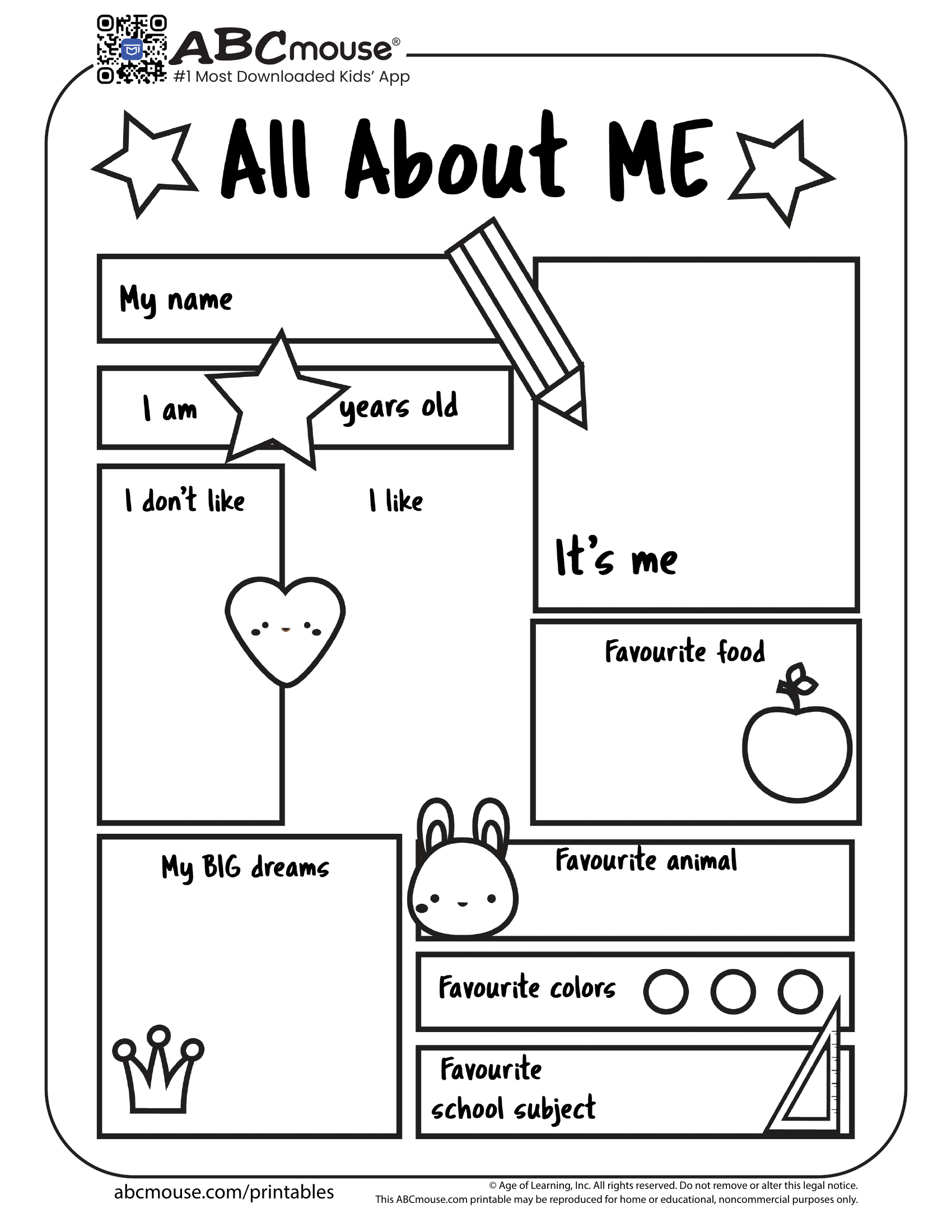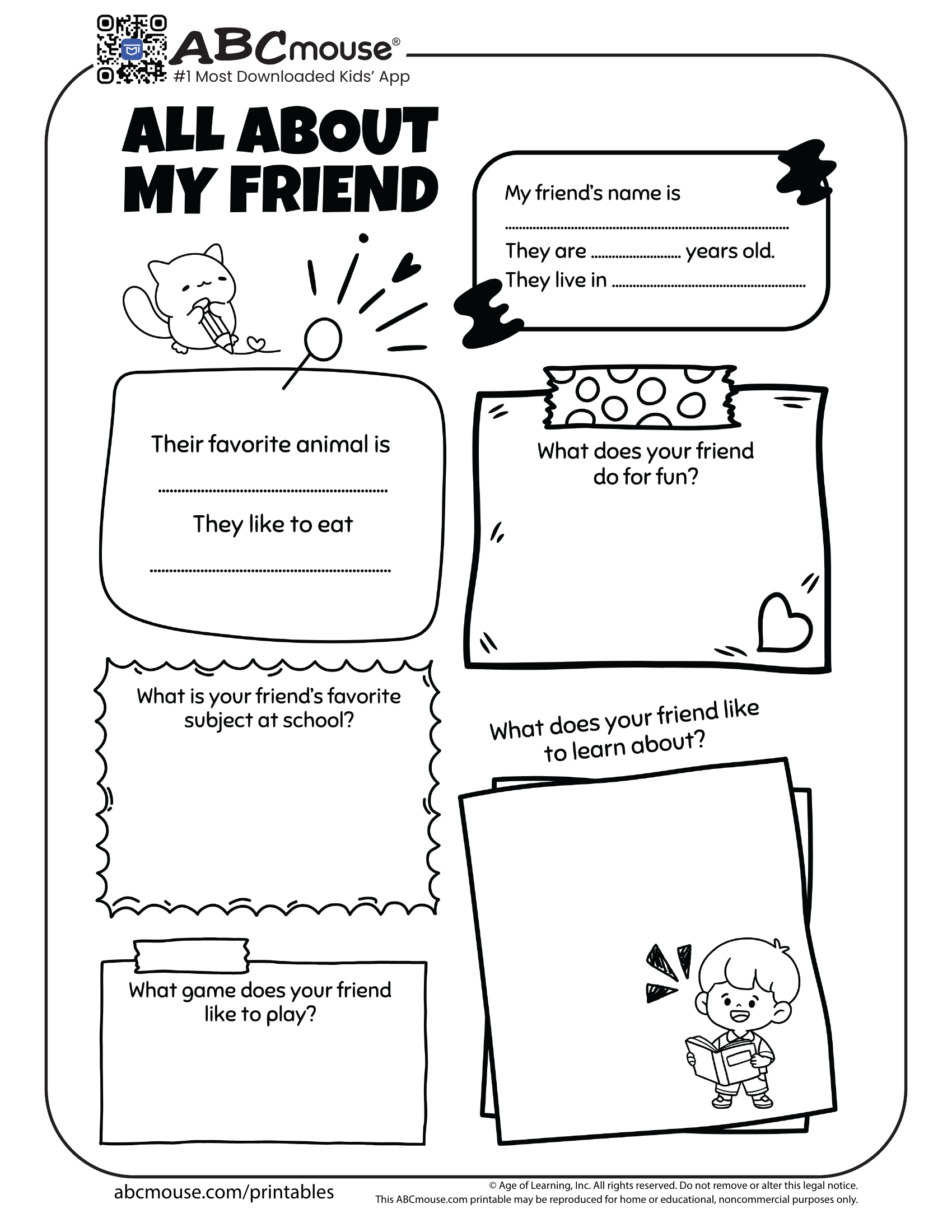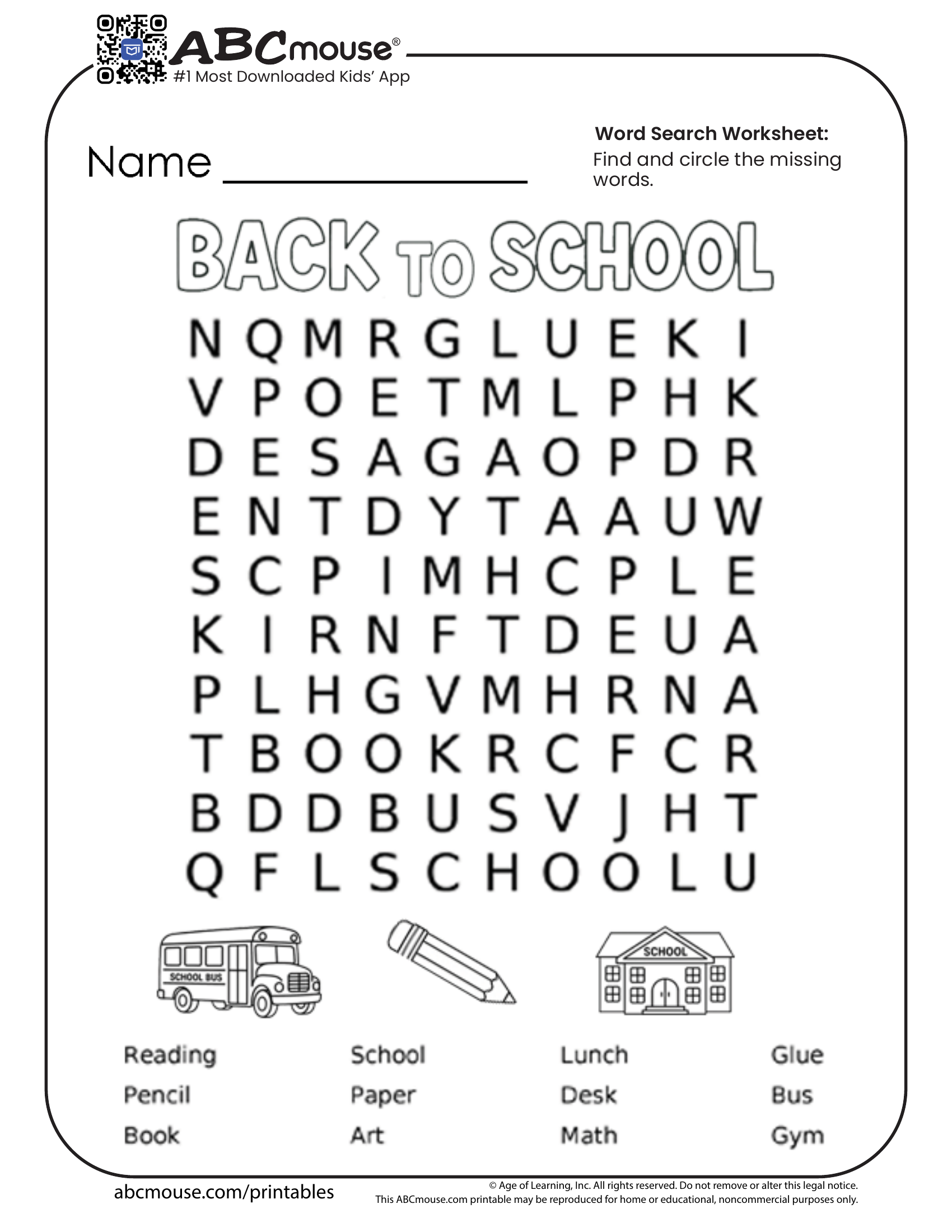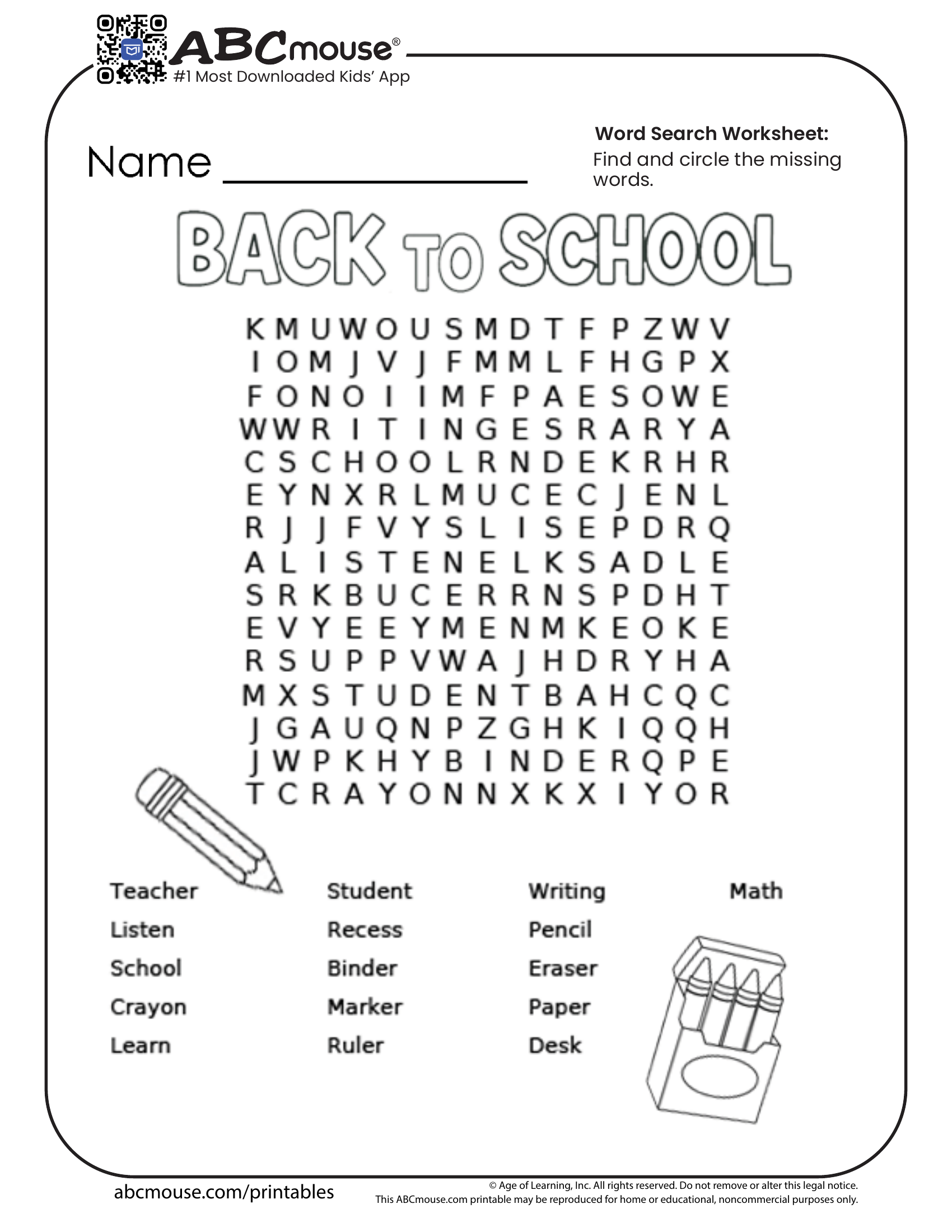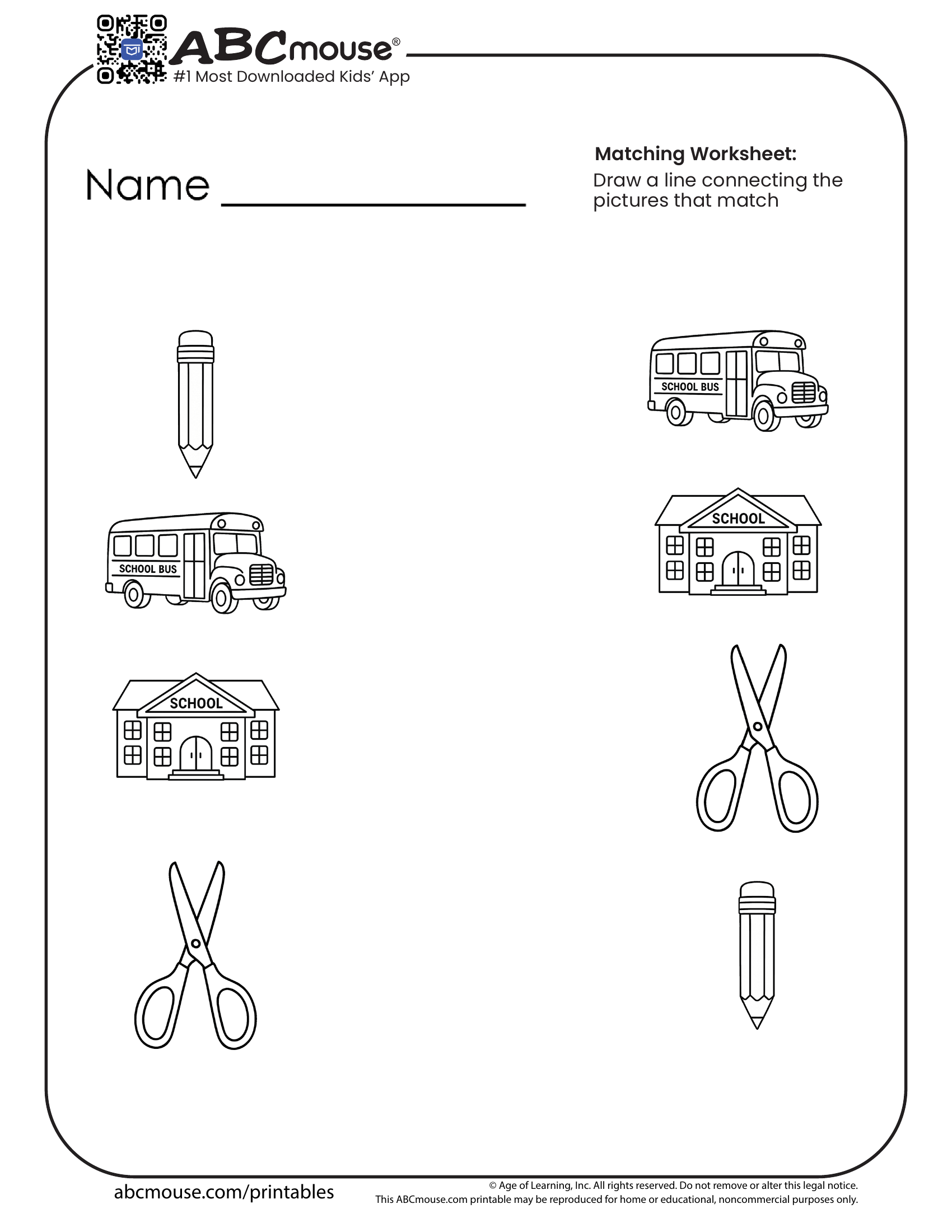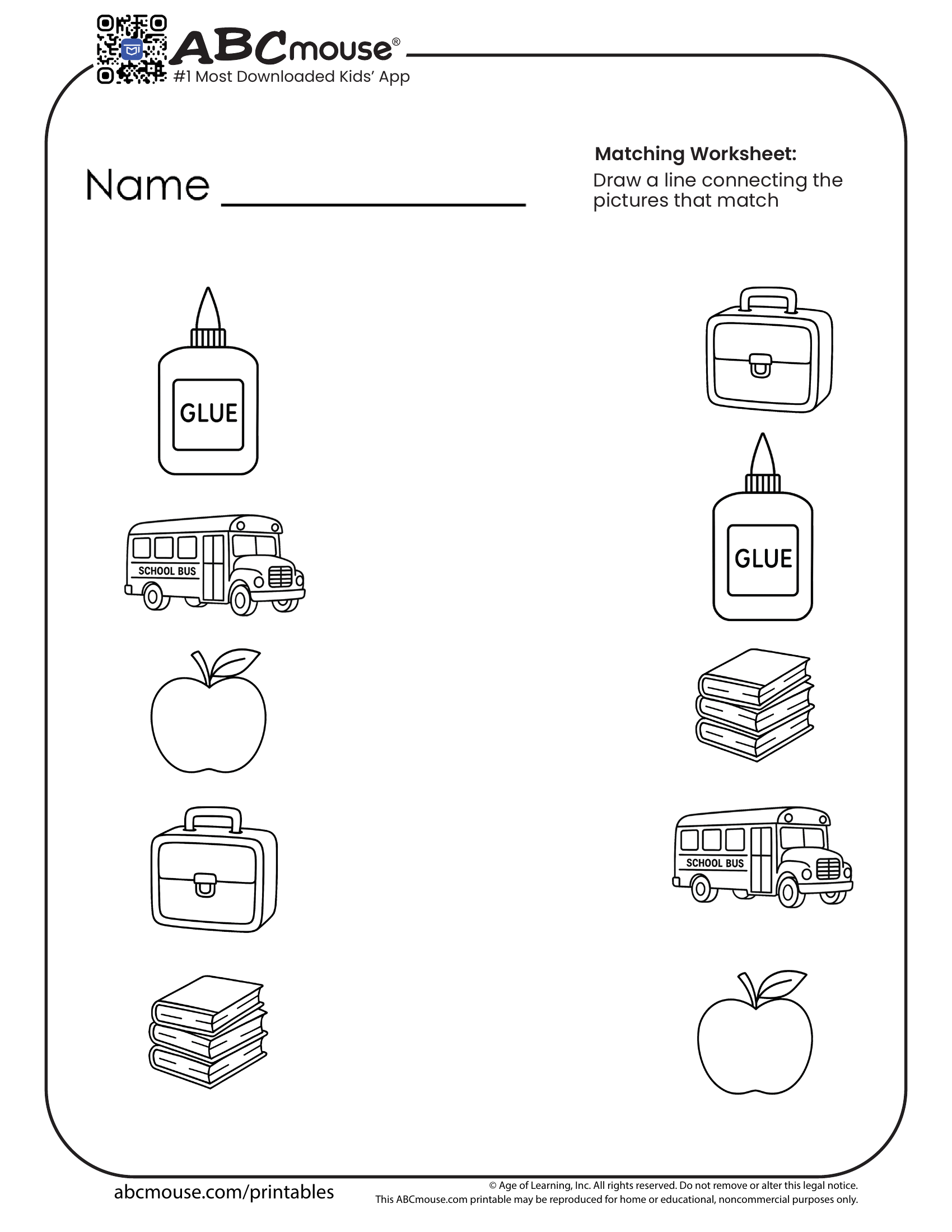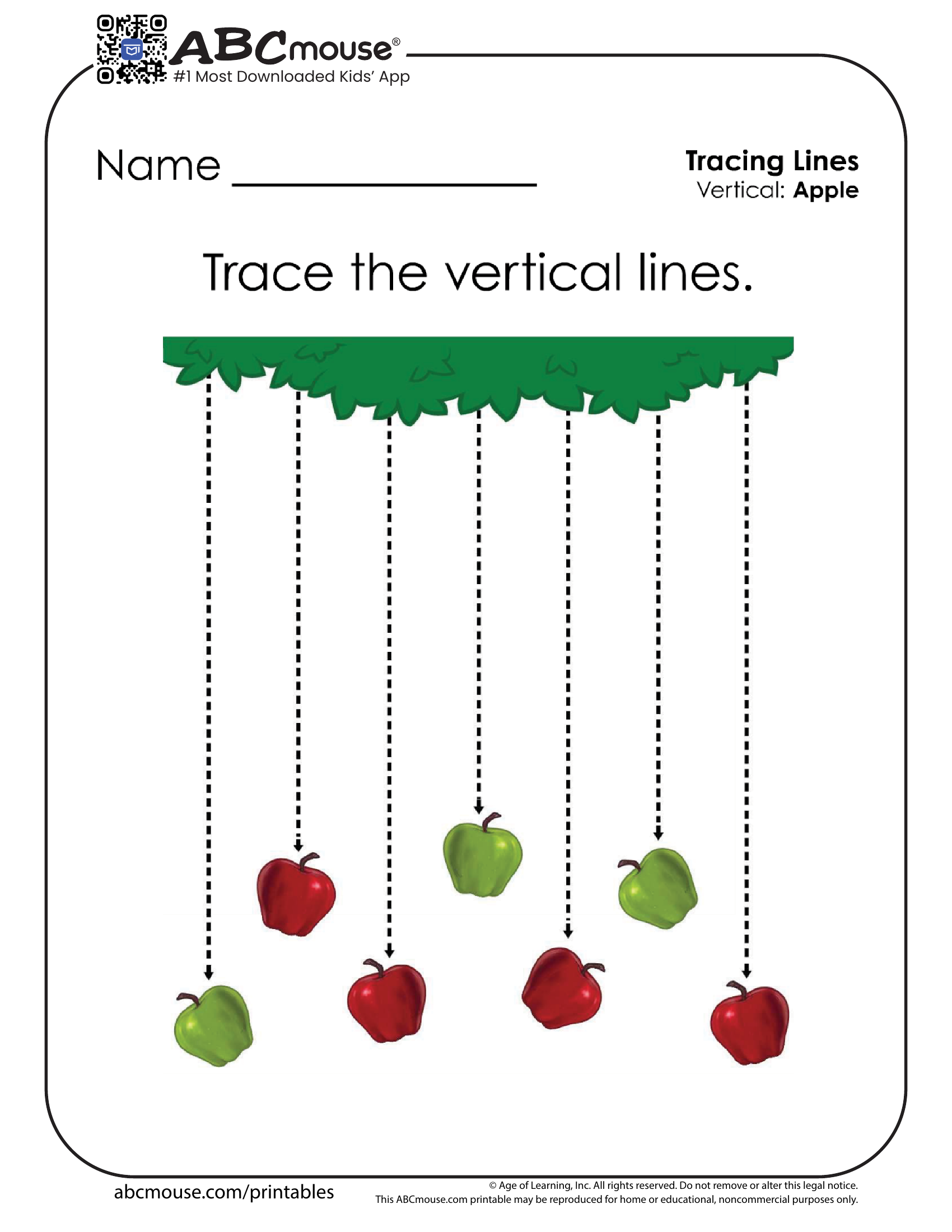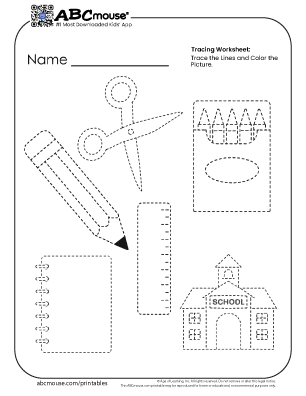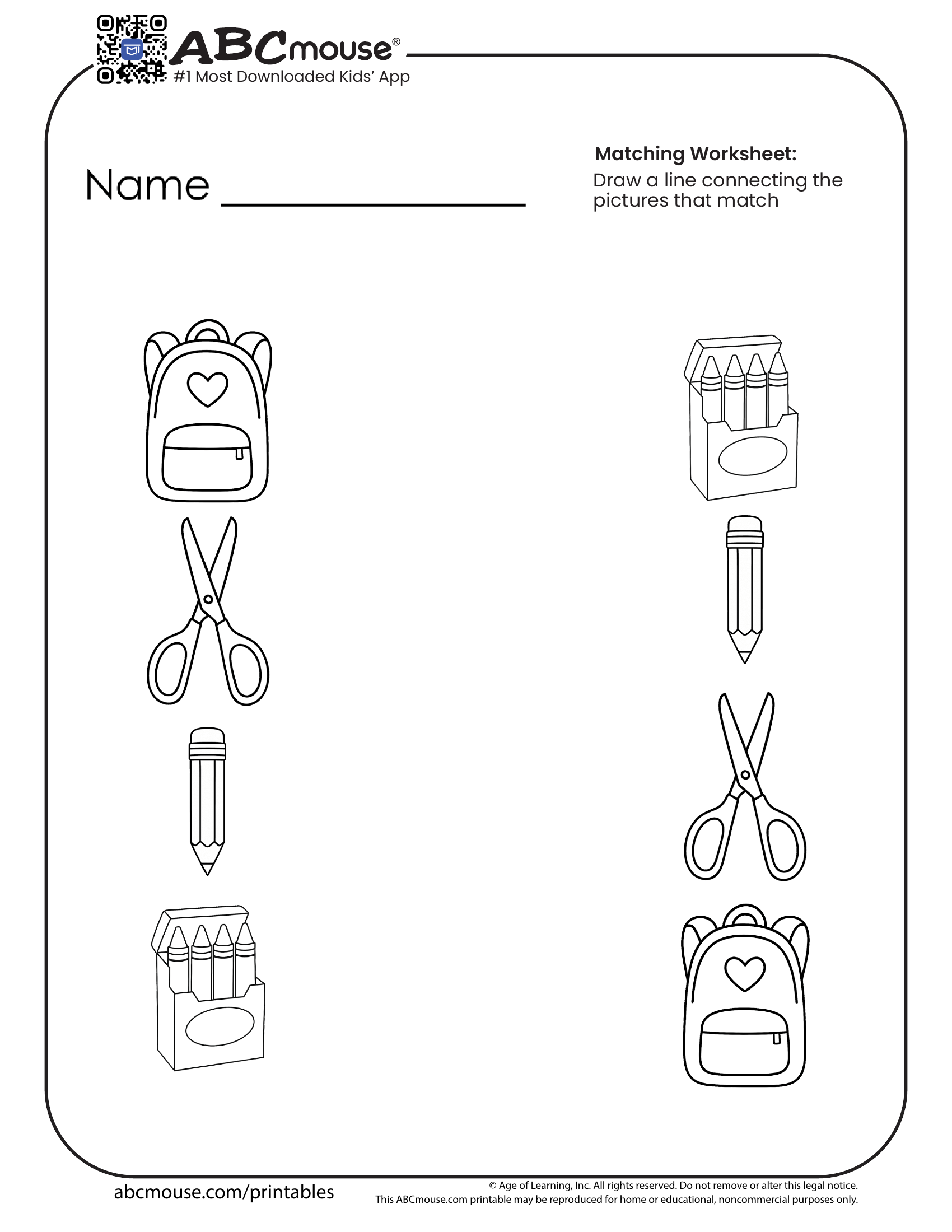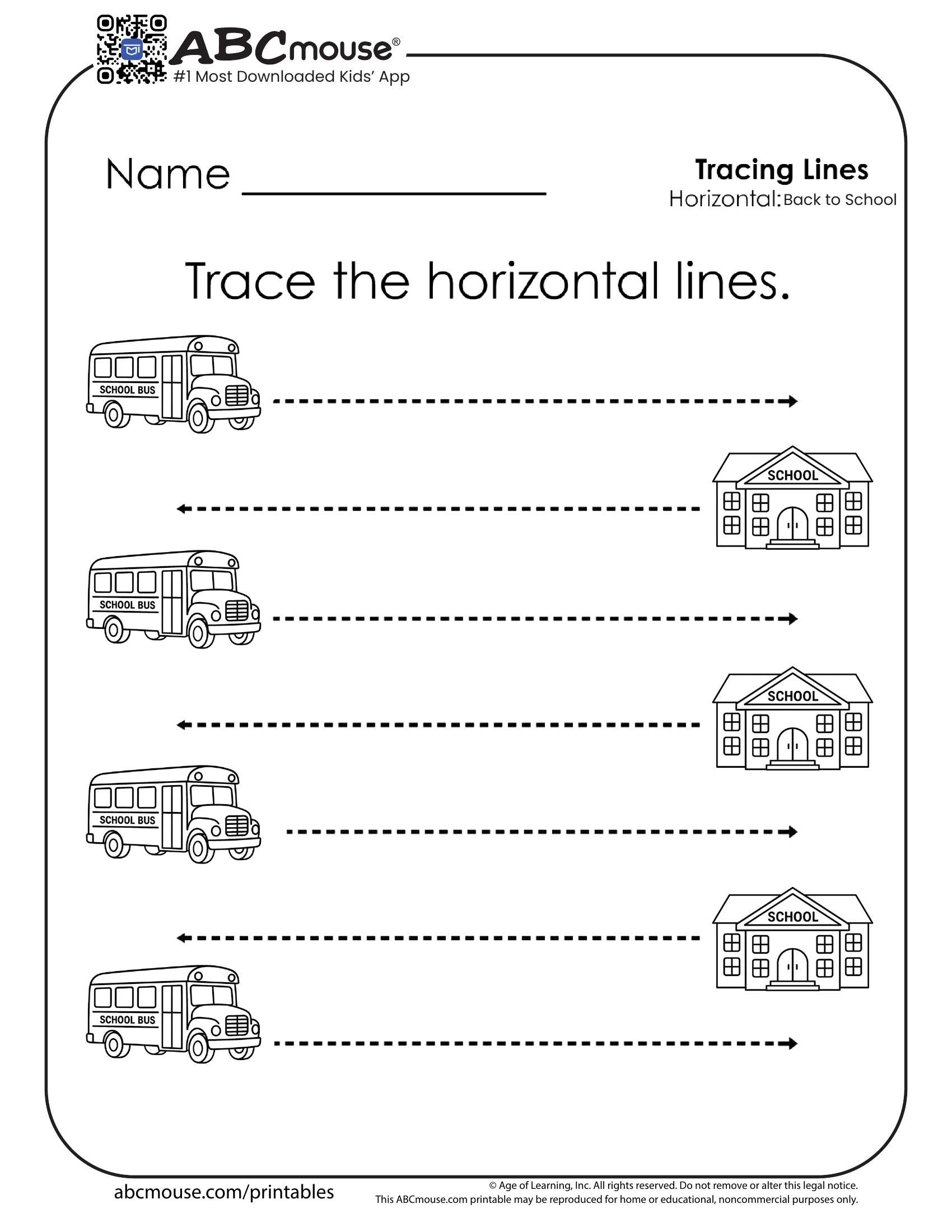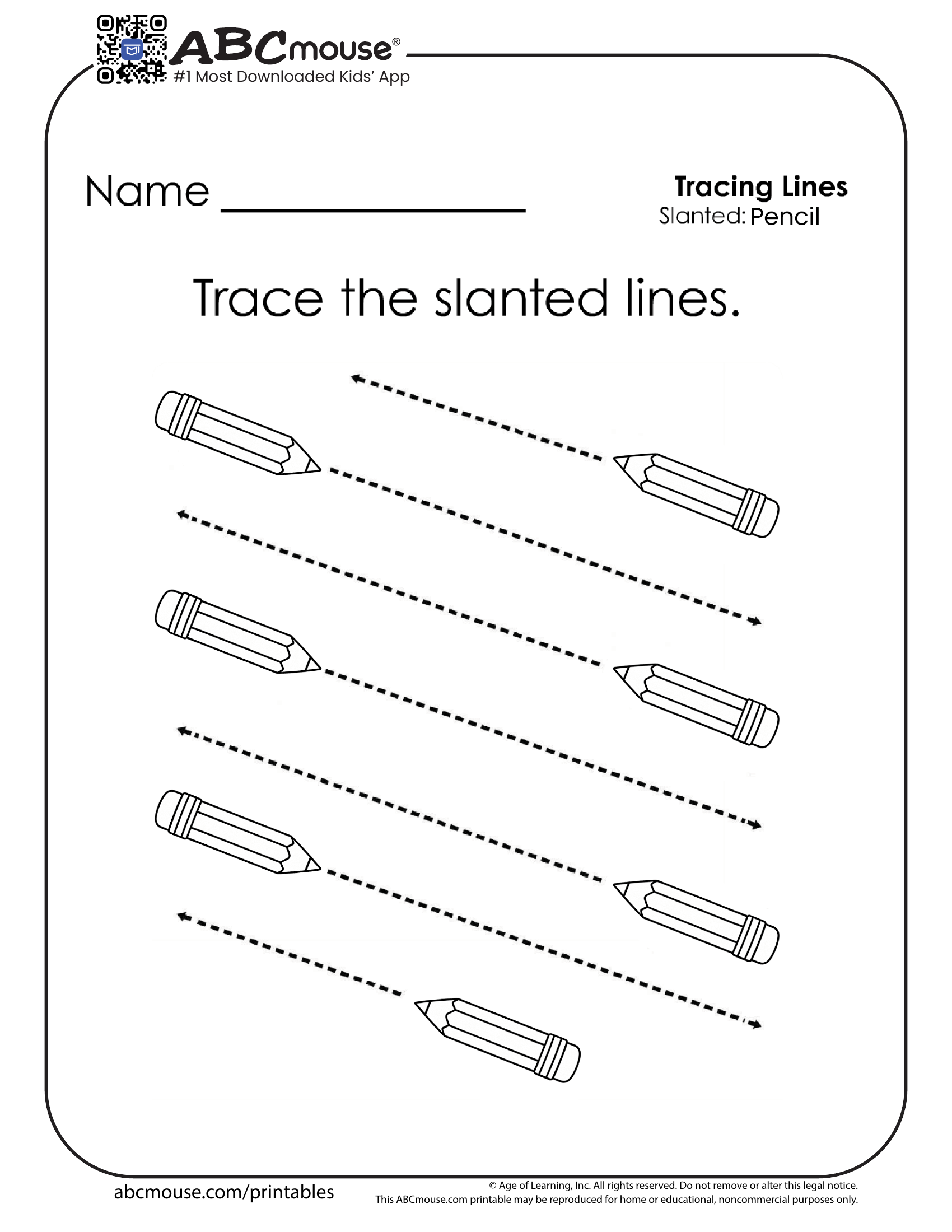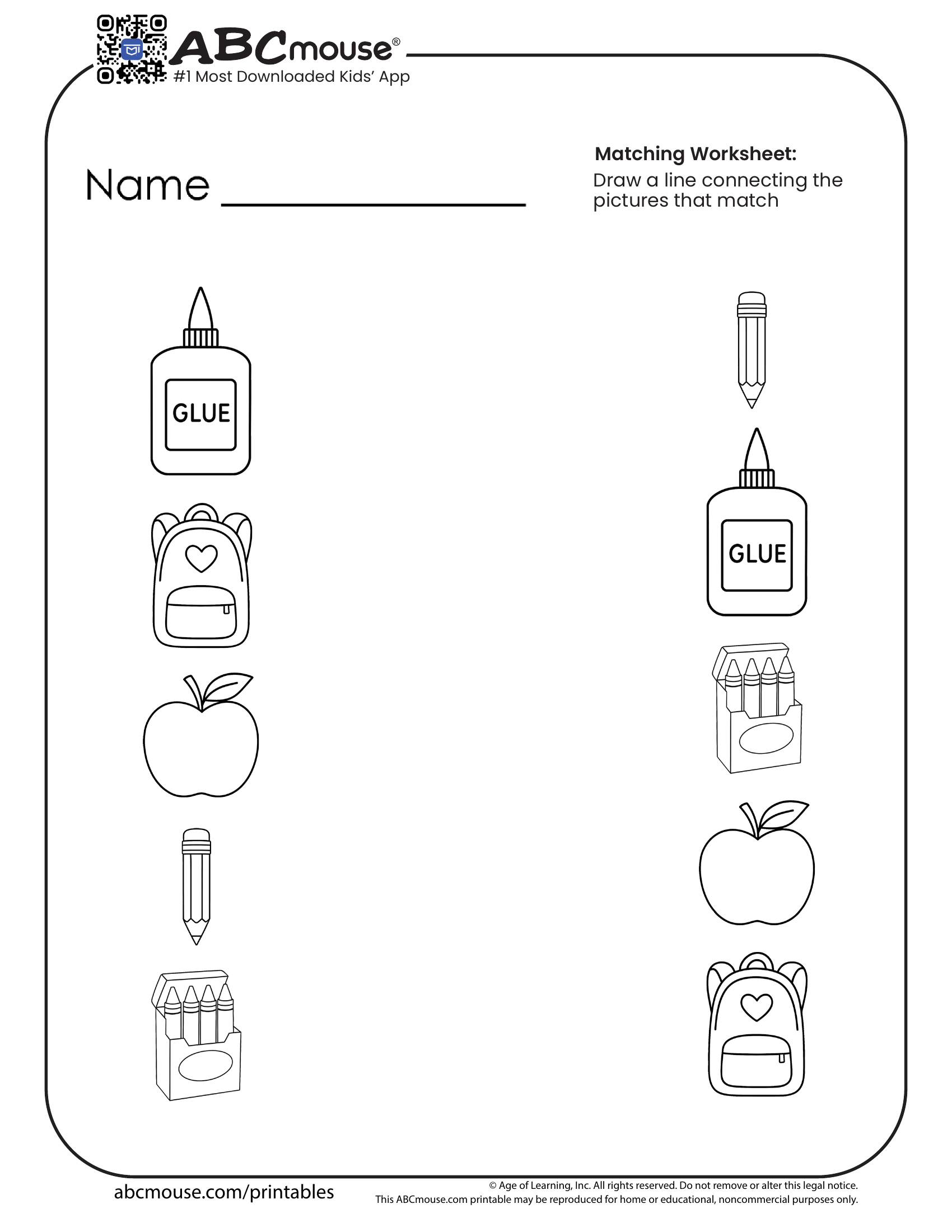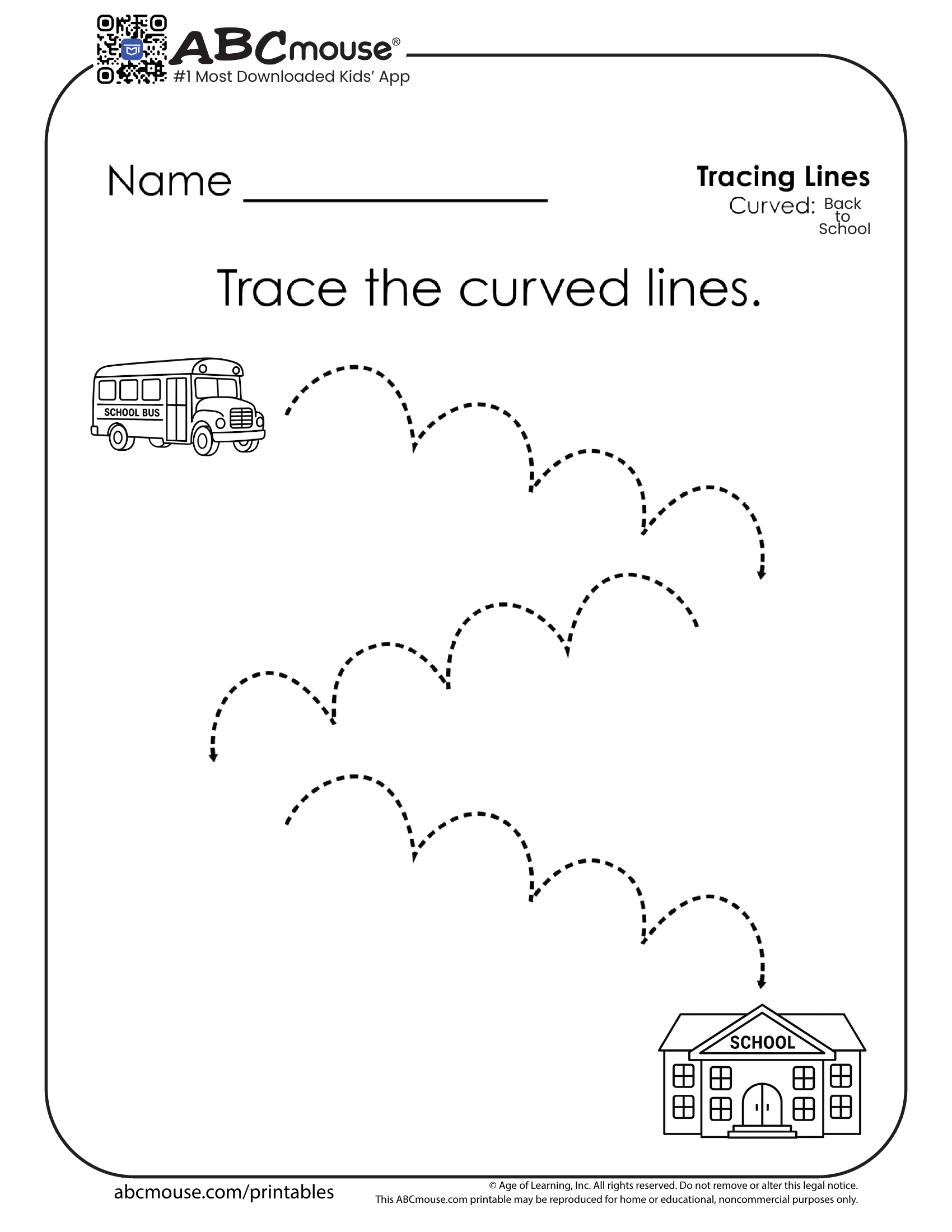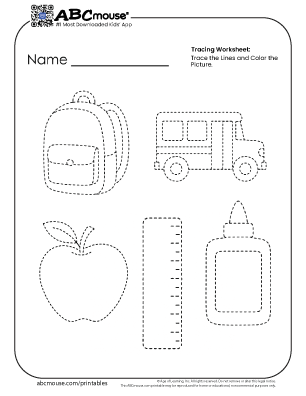ABCmouse.com Early Learning Academy Receives Prestigious Editor’s Choice Award from Children’s Technology Review
January 11, 2011 (Glendale, CA) – ABCmouse.com Early Learning Academy–a pioneering full online curriculum preschool through kindergarten educational website launched publicly in November 2010—recently received the prestigious Editor’s Choice Award from Children’s Technology Review (CTR), a monthly publication that features the latest products and trends in children’s interactive media.
CTR’s review process is designed to broadly measure five factors that generally apply to most children’s interactive media experiences: ease of use, educational value, entertainment value, design features, and overall value. Global variables strongly influence the ratings in each of these factors, especially “smart” features (like the ability to adapt to a child’s capabilities or to expand in complexity), respecting a child’s time (for example, by making it easy to save work or progress), and so on. On a scale of 1 to 5, ABCmouse.com received 4.5 stars.
CTR Editor Warren Buckleitner wrote in his review, “This solid, subscription-based curriculum for preschool through kindergarten lets children explore a wide variety of content in a structured way. After you play a few levels you quickly can see that teachers played a hand in all aspects of this service.” Buckleitner also noted, “This type of service is complete enough to supplement an existing school curriculum or provide the backbone of a home-based curriculum.”
Buckleitner, a former preschool and elementary school teacher, founded CTR in 1993 after spending 10 years at the HighScope Educational Research Foundation. He has been an adviser to Consumer Reports WebWatch as well as a judge for the Association of Educational Publishers’ Golden Lamp awards and has taught at Michigan State, along with New York University’s Interactive Telecommunications Program and the Rutgers Graduate School of Education. In addition to serving as editor of CTR, Buckleitner writes for Parents magazine and Scholastic Parent & Child magazine, among other publications.
ABCmouse.com Early Learning Academy provides parents and teachers with a safe, engaging online environment where young children can learn their ABC’s using a computer mouse, thus the name, ABCmouse.com. The goal of this new and unique learning experience is to help children build a strong foundation for future academic success by providing engaging educational content that supplements and supports preschool, pre-k, and kindergarten programs in the subject areas of reading, mathematics, social studies, beginning science, art, and music.
The site’s comprehensive curriculum, developed in collaboration with nationally recognized early childhood education experts, offers a depth and breadth of educational content for early learners never before seen in one location on the web. From ABC’s and 123’s to Thank You and Please, ABCmouse.com is “Bringing Learning to Life®” by offering more than 2,000 individual learning activities—online books, games, songs, puzzles, art activities, and printables—contained within more than 350 custom lesson plans spanning six academic levels.
In addition to being available as a subscription service for parents at home, ABCmouse.com’s extensive curriculum is available at no cost to public schools throughout the United States and Canada, where teachers are finding its rich variety of quality learning activities of tremendous value as an additional resource in the classroom. Dr. Rebecca Palacios, an ABCmouse.com curriculum advisor and a pre-k and kindergarten teacher for more than 25 years who was also a Founding Director of the National Board for Professional Teaching Standards, remarked that..
“ABCmouse.com Early Learning Academy is an extensive curriculum resource that helps teachers of young children provide for the academic needs of individual students in their diverse classrooms, and at the same time is a powerful teaching tool that incorporates best practices in early childhood education. It is a resource that I enthusiastically recommend to preschool, pre-k, and kindergarten teachers across America.”
ABCmouse.com recently announced the release of a new collection of highly innovative educational apps for the iPad, iPhone, and iPod touch, with engaging features to enhance early learning. These apps, which introduce three of ABCmouse.com’s new children’s books series beginning with six beautifully illustrated interactive books as well as an interactive zoo environment, are the first of ABCmouse.com’s ongoing series of releases of educational apps for young learners, extending its online curriculum to the mobile platform and providing opportunities for children to learn from ABCmouse.com no matter where they are. Direct links to these apps are provided below.
Doug Dohring, Founder and CEO of Age of Learning, Inc., which owns and operates ABCmouse.com commented, ”We’re very pleased to receive the Children’s Technology Review Editor’s Choice Award because it recognizes that ABCmouse.com is an extremely rich resource for parents and educators that goes well beyond educational games and interactive children’s books.”
“Our goal in creating the site has been to develop a complete online supplementary curriculum in which every learning activity is very engaging, fun, and highly educational for young children whether it’s about phonics, word families, counting, colors, shapes, animals, weather, or any of the dozens of other topics in our curriculum. And even though there are already thousands of learning activities at ABCmouse.com, we will continuously be adding more content to keep the site fresh and new for our young learners. It has been and continues to be a major development effort and the CTR review, as well as the very positive feedback we are getting from our members, helps us to know that we’re on the right track.”
Mr. Dohring further noted, “I would like to acknowledge our many curriculum advisors, including Kim Oliver Burnim, Dr. Rebecca Palacios, Dave Hendry, Dr. John Bollard, Phyllis Baecker, Kevin O’Donnell, and others, for their valuable contributions in making ABCmouse.com the high quality children’s educational resource it is today, capable of earning the site this recognition.”
About ABCmouse.com Early Learning Academy and Age of Learning, Inc.
ABCmouse.com Early Learning Academy is a global education initiative of Age of Learning, Inc., whose goal is to help children build a strong foundation for future academic success by providing a comprehensive and engaging online curriculum to greatly assist early learners to succeed in pre-k, kindergarten, and early elementary school programs. The site is named ABCmouse.com because it’s a place where children can learn important educational basics (often referred to as “the ABC’s”) through the use of a computer mouse, thus ABCmouse.com. At ABCmouse.com, the computer mouse comes to life as ABC Mouse, who serves as the site ambassador and guide to early learners everywhere.
Age of Learning, Inc. has filed multiple patents related to its uniquely designed educational content delivery methods and systems.
ABCmouse.com Early Learning Academy Releases First Original Album, The Letter Songs A to Z Now Available on iTunes
March 29, 2011 (Glendale, CA) – ABCmouse.com Early Learning Academy—a pioneering educational website for children ages 2 through 6 (preschool through kindergarten)—announced today the release of its first music album, The Letter Songs A to Z, which is now available on iTunes. The album features 26 songs, one for each letter of the alphabet.
Samples of all 26 songs, with lyrics, can be accessed at ABCmouse.com/LetterSongs.
ABCmouse.com is a global education initiative of Age of Learning, Inc., whose goal is to help children build a strong foundation for future academic success by providing a comprehensive and engaging online curriculum that greatly helps early learners succeed in pre-k, kindergarten, and early elementary school programs.
In keeping with this overall mission, the 26 original ABCmouse.com letter songs were written to help children learn the names and sounds of the letters of the alphabet, as well as to increase their vocabulary. Additionally, every letter song is produced and arranged in a different musical style to introduce children to a wide variety of musical genres, including folk, pop, R&B, big band, country, rock, tango, disco, hip hop, and more. This wide variety of genres makes The Letter Songs A to Z album uniquely entertaining for parents and children alike.
Music is an important part of the ABCmouse.com Early Learning Academy curriculum. The site’s large and growing music library contains original songs, such as those in The Letter Songs A to Z album, as well as classic traditional children’s songs, like The Itsy Bitsy Spider and Five Little Monkeys. As with all of the content on ABCmouse.com, the music and songs on the website are created and produced in-house by Age of Learning’s own creative team in Glendale, CA. This ever-growing team of professionals is dedicated to providing children, parents, and teachers with the highest quality educational experience possible.
“Learning the alphabet and the letter sounds and developing oral vocabulary are all fundamental to reading,” said Doug Dohring, founder and CEO of Age of Learning, Inc., which owns and operates ABCmouse.com. “We know from the feedback we receive daily that the songs and music offered on ABCmouse.com are among the most popular activities on the site. Now that this album is available on iTunes, children and parents can enjoy and learn from this music no matter where they are.”
Sample Lyrics
From The Letter G Song (music genre: cowboy country)
Gooey, gurgle, goopy, gushy,
Funny words that start with g!
Where would a word like giggle be
Without that goofy letter g?
From The Letter X Song (music genre: hip hop)
Now x sounds like “x” inside of a word!
So every time you see an x, this is how it’s heard—
Excite, exceed, extreme, extent, explore, explode—that’s excellent!
Now x is a crossing, and x marks the spot!
If you want to know some more, this is what I’ve got:
When x starts a word, it’s got the sound of a z.
Will I give you an example? Most definitely!
ABCmouse.com’s curriculum has been designed in close collaboration with nationally recognized early childhood education experts, ensuring that the content aligns with best practices of early education. Recognizing the important role that music can play in the education of young children, ABCmouse.com incorporates songs and instrumental accompaniment in many of the site’s hundreds of online individual learning activities in the subjects of reading, math, beginning science, social studies, and the arts. Additionally, all of ABCmouse.com’s innovative mobile apps feature original instrumental music or songs that are both educational and entertaining.
ABCmouse.com Early Learning Academy’s educational advisors include Dr. Rebecca Palacios, pre-k and kindergarten teacher for more than 25 years and a founding director and past vicechairperson of the National Board for Professional Teaching Standards (NBPTS). Dr. Palacios noted,
“Music can be a very powerful teaching tool for young children. The Letter Songs A to Z album will not only teach children about patterns of music but will also familiarize them with patterns of sounds and words, such as rhyming words and words that start with the same letter. Even children who already know the alphabet can benefit from this as well as from the opportunity to learn many new vocabulary words. I believe this album could have a very significant positive impact on improving basic literacy skills for young learners and even more so for children who live in families in which English is not the first language spoken.”
The Letter Songs A to Z album is available through iTunes, along with other ABCmouse.com’s mobile apps including interactive books and educational games. The complete The Letter Songs A to Z album is priced at $9.99, while individual songs are available for $.99.
About ABCmouse.com Early Learning Academy and Age of Learning, Inc.
ABCmouse.com Early Learning Academy is a global education initiative of Age of Learning, Inc., whose goal is to help children build a strong foundation for future academic success by providing a comprehensive and engaging online curriculum to greatly assist early learners to succeed in pre-k, kindergarten, and early elementary school programs. The site is named ABCmouse.com because it’s a place where children can learn important educational basics (often referred to as “the ABC’s”) through the use of a computer mouse, thus ABCmouse.com. At ABCmouse.com, the computer mouse comes to life as ABC Mouse™, who serves as the site ambassador and guide to early learners everywhere.
Age of Learning, Inc. has filed multiple patents related to its uniquely designed educational content delivery methods and systems.
ABCmouse.com Early Learning Academy Public Launch
Los Angeles, CA (November 16, 2010)—The ABCmouse.com Early Learning Academy, a pioneering, full online curriculum, preschool through kindergarten educational website developed especially for children ages 2 through 6, was publicly launched today. ABCmouse.com provides parents and teachers with a safe, engaging online environment where young children can learn their “ABC’s” using a computer mouse, thus the name ABCmouse.com.
The goal of this new and unique learning experience is to help children build a strong foundation for future academic success by providing engaging educational content that supplements and supports preschool, pre-k and kindergarten programs. The site’s comprehensive curriculum, developed with leading education experts, includes all generally accepted subjects of early childhood education—with each subject taught through a wide range of learning activities. ABCmouse.com also offers a unique rewards system that recognizes children’s educational accomplishments and encourages them to continue progressing through the site’s many academic lessons and levels. (The company has filed multiple patents related to their uniquely designed educational content delivery methods and systems.)
ABCmouse.com is developed specifically to help young children thoroughly learn educational basics in reading, math, beginning science, social studies, art and music. The website offers a depth and breadth of educational content for early learners never before seen in one location on the web.
From ABC’s and 123’s to Thank You and Please, ABCmouse.com is “Bringing Learning to Life” by offering more than 2,000 individual learning activities, including online books, games, songs, puzzles, art activities and printables contained within more than 350 custom lesson plans spanning six academic levels—all tailored for preschool-, pre-k- and kindergarten-aged children.
The website and its content have undergone extensive testing, registering more than 10,000 families throughout the U.S. and Canada throughout the Alpha and Beta test phases.
You know, we watch a lot of educational programming on TV but ABCmouse.com is so much better because she’s actually working with the computer, learning skills, putting together puzzles, turning pages in a book on the computer, and that’s so much better than her just sitting on the couch and staring at a screen.
ABCmouse.com is definitely getting my daughter ready for school. I would absolutely recommend ABCmouse.com to other people. I’ve already recommended it to my friends. It truly is a revolutionary new website. I’ve never seen anything like it. We’re really enjoying it as a whole family, and I can’t recommend it more highly.
—Cate M., librarian (two masters degrees), mother of 4-year old daughter
Unlike most other children’s websites, ABCmouse.com has no advertising, pop-up ads, or links to other websites, so children can learn and explore with their parents or teachers or on their own, depending on their age and experience, in a safe and secure online environment.
ABCmouse.com also helps bring families together by enabling parents to invite extended family members (grandparents, aunts, uncles and cousins) and friends to participate in their children’s education. Features that support this interaction include the site’s easy-to-use, safe and secure, proprietary messaging system through which the child can share completed educational lessons and artwork, as well as send and receive audio, video, and text messages. Family members can also record and save the readings of books and stories for the child—a feature especially embraced by grandparents who may live far away from their grandchildren.
The ABCmouse.com Early Learning Academy is available to families on a low-cost subscription basis (see monthly and yearly subscription rates cited below) and allows up to three children per household for one low fee. In addition, the company has announced that at launch, the ABCmouse.com. Early Learning Academy will be available free of charge to all public schools throughout the United States and Canada that apply for the program.
Owned and operated by Age of Learning, Inc., located in Glendale, CA, the ABCmouse.com Early Learning Academy is the latest venture from the founding management team of the enormously popular youth entertainment website, Neopets.com, led by Founder and CEO Doug Dohring. Under this founding management team’s direction, Neopets.com grew to become one of the most popular sites for children on the Internet from 2000 to 2005. With more than 12 million unique monthly visitors and serving more than five billion monthly pageviews, Neopets.com, accessible in 11 languages worldwide, was one of the top-10 “stickiest” websites in the U.S. when it was acquired by Viacom in 2005.
Since the completion of the sale of Neopets, Inc., Age of Learning’s management team has dedicated its resources and more than three years of development time to designing and building ABCmouse.com into the premier educational destination for young children on the web. The talented staff of creative artists, designers, writers, programmers and musicians, guided by the organization’s curriculum advisory team, continues to create new and innovative content, ensuring the site is always fresh and engaging for young learners. The company’s commitment to quality, coupled with the unparalleled breadth and depth of its early childhood curriculum, make each visit to ABCmouse.com an opportunity for a stimulating and rewarding learning experience for every young child.
“After more than three years in development and extensive website testing with more than 10,000 families, we have been extremely pleased with the positive response from parents and educators to our site content and delivery systems,”said Mr. Dohring. “The rate at which children are learning as reported by our members, has exceeded our own expectations.”
To ensure the highest level of educational value of ABCmouse.com throughout the content development process, Age of Learning has closely collaborated with leading childhood educational professionals, including careful review of every activity on the site.
Educational advisors include Kimberly Oliver Burnim, a National Teacher of the Year Award recipient; Dr. Rebecca Palacios, pre-k/kindergarten teacher for more than 25 years and a founding director and past vice-chairperson of the National Board for Professional Teaching Standards (NBPTS), an organization that has certified more than 80,000 teachers in the United States over the past 20 years; Phyllis Baecker, a highly experienced professional editor with more than two decades of experience with several leading children’s educational publishers, including Scholastic, Inc.; and Dr. John Bollard, a professional lexicographer with more than 25 years of experience, Editor of The Scholastic Student Thesaurus (2002) and Children’s Thesaurus (1998); Contributing Editor of The New Oxford American Dictionary (2001); and Consulting Editor for Webster’s New World Thesaurus (1996). Dr. Bollard advises on children’s literature content and guides the development of the extensive ABCmouse.com glossary.
“Research has shown that children learn more from birth to age five than at any other time in their lives,” said Ms. Burnim. “It would be my dream to have all children come to kindergarten prepared. Unfortunately, that is not the case at this time. I strongly believe that children who complete the curriculum of ABCmouse.com during these all-important formative years will be very well prepared. I highly recommend it.”
Added Dr. Palacios, “As educators, we know that parents want to help their young children learn, but often times don’t know where to turn for the right educational resources. I have never seen a single educational resource as comprehensive as the curriculum on ABCmouse.com. If I could recommend only one online resource to parents of young learners, it would be ABCmouse.com, without a doubt.”

Harnessing Education Technology to Meet Diverse Learning Needs in the Classroom
Case study shows ABCmouse increases students’ foundational skills and confidence.
Table of Contents – Jump to Each Section
ABCmouse: Engaging Diverse Learners
ABCmouse: Differentiation by Student Level
“I implemented ABCmouse in every lesson . . . My students started picking up their letters faster. They were applying phonics faster. They were recognizing sight words faster. When testing came around, I had 78 percent of my class test advanced in foundational skills. That’s never happened before. But to me, ABCmouse is more than just high test scores, because the results that you will see in your students not only benefit them academically, but also give them self-confidence to love school, to love learning.”
—Laura Bryant, Las Cruces, New Mexico
ABCmouse Case Study Overview
Laura Bryant is a kindergarten teacher in a low-income community in New Mexico. Her students all qualify for the free breakfast program, and 90 percent qualify for free or reduced lunch. She knows they are at high risk for school failure when they first come into her classroom. However, Laura sees an opportunity to help them build the skills necessary for academic success. The challenge lies in meeting the diverse learning needs of her students, including a range of English Language Learning (ELL) needs. “I have students who already know [how to spell] their name and their letters, but then I have ones who don’t know their letters or their sounds.”
Research Insights:
Research has found that the earlier a student acquires English proficiency as a second language, the more likely it is that they will develop academically at a similar rate to their native English speaking peers. For example, a child who achieves English proficiency by kindergarten entry earns similar reading and math scores to native English speakers; however, a child who is not proficient until first grade experiences a gap in scores as compared to native speakers.1
Laura began using ABCmouse.com Early Learning Academy, a supplementary curriculum available online and as an app, during the 2012–13 school year. “ABCmouse is the one website I integrate into all my lessons on a daily basis,” she notes. Laura employed a three-pronged, differentiated teaching strategy to 1) engage students with fun and diverse learning activities; 2) provide individualized lessons for below-, at-, and above-grade-level students; and 3) vary the delivery and mode of instruction for students to learn individually, in small groups, and with the entire class. Additionally, she discovered that ABCmouse was a valuable ELL resource for the students in her class who primarily spoke Spanish.
ABCmouse: Engaging Diverse Learners
Regardless of how educational content is delivered, in order for children to acquire new information and skills, they must engage with the content being taught. Laura found that with ABCmouse she no longer struggled to gain and retain the attention of her students on academic subjects. They consistently asked to “play” on ABCmouse and were excited when Laura would let them choose areas of the program in which to spend time after they had completed their assigned lessons:
“ABCmouse captivates a child’s attention in such a wonderful, marvelous way. It’s not just them memorizing stuff. They have the concept; they have the skill, and they’re making those connections across the content areas. [With ABCmouse] we have literacy, we have numeracy, we have science, social studies; there’s even music and art. I can integrate it into my lessons, into the curriculum, and reinforce and review everything that’s being applied and learned in class. ABCmouse is one of those tools that can fit so easily into lessons and activities for both students and teachers.”
The wide range of ABCmouse learning activities provided each student with something to engage them in learning, based on their individual interests. Laura discovered thousands of activities to reinforce the important skills and concepts that she teaches, through books, games, puzzles, art, and music videos that appeal to different types of learners. As a result, she increased student engagement and focus, which led to important gains in academic skills:
“One hundred percent of my class made significant improvement beyond expectations after using ABCmouse. I’ve never seen a group of kids that are all reading, writing, adding, and subtracting by the end of kindergarten. They know what the sounds are. They know what their letters are. They know what their numbers are; they can count forwards and backwards all the way to 100.”
Laura’s experience with ABCmouse is not unique. In a survey of more than 1,000 teachers using ABCmouse in their classrooms, more than 90 percent reported that ABCmouse had a high or medium impact on their students’ learning.
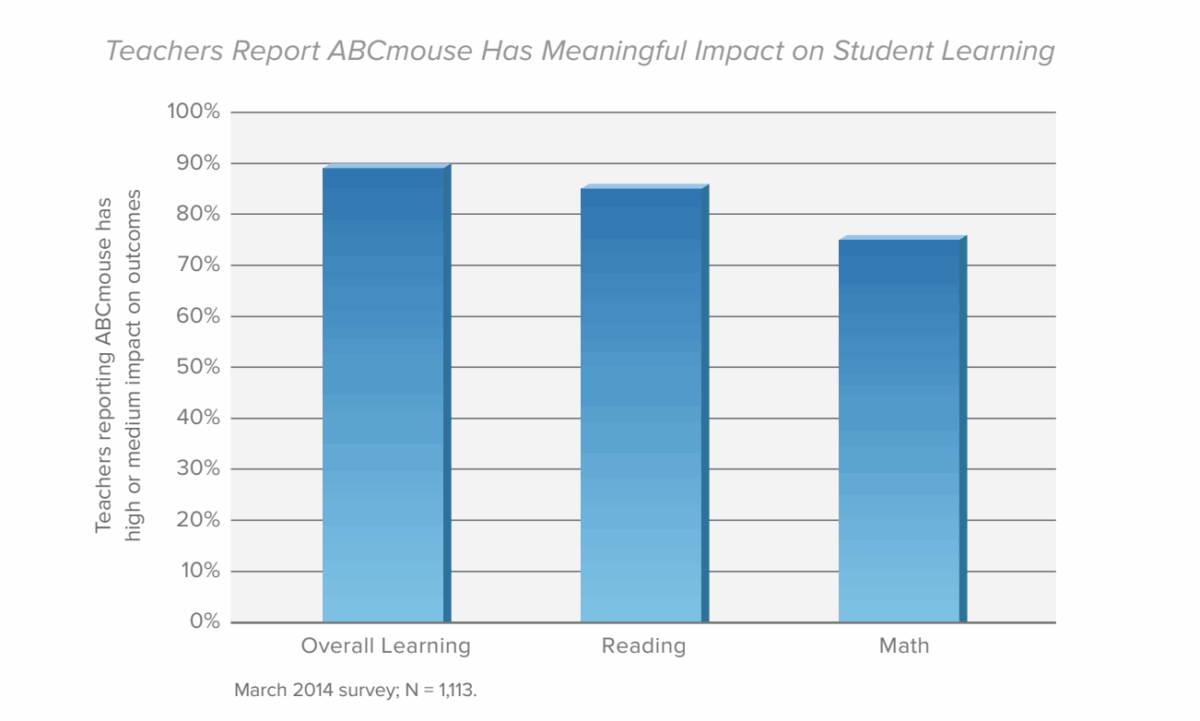
ABCmouse: Differentiation by Student Level
Each year, Laura finds that she has students who need a highly individualized approach to learning. One such student was a boy who had witnessed domestic violence and was placed in foster care. This student had an Individualized Education Plan (IEP) to help him learn while coping with attention deficit hyperactivity disorder (ADHD) and behavioral challenges. He was introduced to ABCmouse with the rest of the class:
“He loved it! I was able to get a good 30 minutes of attention from him, with him working, staying on task, and focusing. He knew that if he listened, learned, and behaved for at least the first 10–15 minutes of the whole group lesson, that he would be able to use ABCmouse. At the end of the year, he was near proficiency and missed the benchmark for reading by only one or two words. He could sound and blend, and he could count. He had his one-to-one correspondence.”
Another struggling student in Laura’s classroom benefited from a highly individualized curriculum using ABCmouse; it helped her learn to speak and read English, which was not her first language:
“When school first started, I had a student who had no reading skills whatsoever. When I finished testing at the end of the year, not only did she know all her letters in order and out of order, but she was reading 169 words per minute. In order for her to go to first grade, she had to read a minimum of 25 words per minute with fluency.”
Research Insights:
Research confirms the value of differentiating instruction, particularly for those children who are at the highest risk for educational failure.2 Current school realities challenge teachers to provide quality instruction for all learners: students with special needs, students learning English, and students who are gifted. Changing demographics, an emphasis on inclusion, a reduction in gifted and talented programs, and an effort to reduce the segregation of struggling learners has changed the role of teachers in meeting the diverse needs in their classrooms with their own lesson planning.3
In addition to using ABCmouse as a supplementary resource for children below grade level, Laura found it had a positive impact on advanced students, too. She describes how one gifted child was able to use ABCmouse for more challenging reading while remaining in the classroom with his same-aged peers:
He would say, “I’m gonna go to the challenging part.” He would like to go to the folk and fairy tale section because he could practice his reading. My kids, once they take of on it, they figure out how to change and adjust things. The website is so kid-friendly and so user-friendly that all of them (doesn’t matter if they’re high or low) can figure out how to change the settings to where they can actually challenge themselves. In this case, he was reading at a second-grade level, and in the middle of the year he figured out how to turn of the speaker and the highlighting because he wanted to try and read it by himself.”
Within her classroom, Laura successfully met the needs of her most at-risk students and her most advanced students with the same educational resource. “When they’re on the low end, I can assign lessons and activities that will help them; if I have a higher student who already knows sounds and letters, I can assign a completely different lesson for a challenge.”
ABCmouse: Differentiation by Instruction Mode
Laura often used ABCmouse learning activities to demonstrate a concept or skill to her students during whole-class instruction. Then, as they worked in centers, students had the opportunity to reinforce those skills individually or in small groups through more ABCmouse activities:
“I do my whole group lesson for about 15 to 20 minutes. After that are centers where I can teach in small groups. One of those centers is always ABCmouse for 15- to 18-minute rotations. So they have 18 minutes in the morning, 18 minutes at lunchtime, and 18 minutes in the afternoon. Mondays, Wednesdays, and Thursdays they have assigned, specific activities to complete. On Fridays, they complete one activity and then can explore.”
Research Insights:
Researchers highlight the need for teachers to vary the mode of instruction as part of a differentiated approach and support the use of technology in that effort.4 A meta-analysis of 122 studies on the use of technology in differentiating modes of instruction concluded that small group learning had more positive effects on achievement than individual learning; however, both types are necessary to meet the needs of all students.5
Laura found that the diverse activities in ABCmouse enable an engaging and interactive experience that can be delivered to her students in various groupings to teach key concepts. For example, she introduced the letter “A” with a music video on ABCmouse to the entire class:
“On ABCmouse, I would click on the letter ‘A,’ and then the visual learners have an example of the ‘A.’ And some kids like to dance, so I let them dance to the music. Some of them use the hand movement that we learned in class for the ‘A’ sound.”
After the whole-group instruction, students sat at the computers during center time and reinforced their understanding by completing ABCmouse games, puzzles, books, and art related to the letter “A” and the sounds that it stands for. And for any student that needed additional assistance, Laura assigned specific activities at the student’s appropriate level to be completed individually in class or at home.
ABCmouse Case Study Summary
Laura found effective new ways to differentiate instruction by incorporating high-quality education technology into the everyday routines of her classroom. Her inclusion of ABCmouse supplemented her curriculum with diverse activities, targeted the individual needs of each student, and facilitated different modes of teaching. By taking differentiated instruction to the next level, Laura helped her students make strong academic gains, and it has become a valued learning resource in her classroom ever since:
“I am a strong believer in ABCmouse and have continued to use this curriculum in my class for four years now, and it’s not going away! During my structured teaching time, I always implement ABCmouse into my whole-group and small group instruction, and even as a free choice center. This year, our school offcially became a Dual Language Magnet public school, and ABCmouse has again proven to benefit not only my native English speakers, but my English Language Learners alike.”
Notes:
1. Director of Research and Educational Partnerships, Age of Learning, Inc.; formerly Assistant Professor and Director of Early Childhood Education Master’s Program, Loyola Marymount University Halle, Hair, Wandner, McNamara, & Chien (2012)
2. Darling-Hammond, Wise, & Klein (1999) 3 Sapon-Shevin (2001)
3. Sapon-Shevin (2001)
4. Stanford, Crowe, & Flice (2010) 5 Lou, Abrami, & d’Apollonia (2001)
5. Lou, Abrami, & d’Apollonia (2001)
References:
Darling-Hammond, L., Wise, A., & Klein, S. (1999). A license to teach: Raising standards for teaching. San Francisco: Jossey-Bass.
Halle, T., Hair, E., Wandner, L., McNamara, M., & Chien, N. (2012). Predictors and outcomes of early versus later English language proficiency among English language learners. Early Childhood Research Quarterly, 27(1), 1-20.
Lou, Y, Abrami, P. C., & d’Apollonia, S. (2001). Small group and individual learning with technology: A meta-analysis. Review
of Educational Research, 71(3), 449-521.
Sapon-Shevin, M. (2001). Schools fit for all. Educational Leadership, 58(4), 34-39.
Stanford, P., Crowe, M. W., & Flice, H. (2010). Differentiating with technology. Teaching Exceptional Children Plus, 6(4),
2-9.
TM & © 2016 Age of Learning, Inc. All rights reserved. The names of other companies, products, and services are the property of their respective owners.
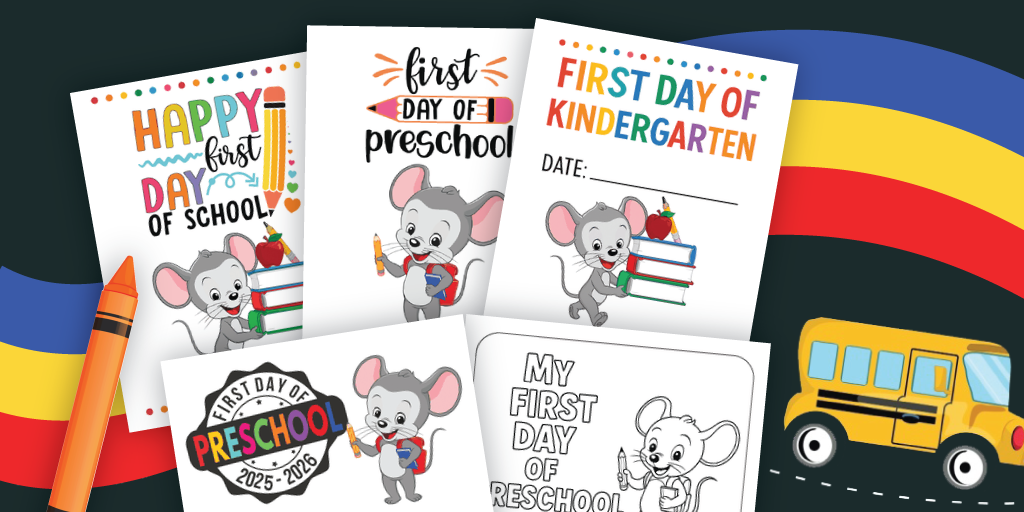
First Day of School Signs (Free Printable Posters!)
These free printable back-to-school posters make it fun and easy to capture that special first day of school moment! Designed for kids to hold in photos, these signs are perfect for parents snapping pictures at home or teachers documenting the big day in the classroom.
Whether your child is beginning preschool, their first day of fifth grade, or any grade in between, these first day of school signs add a festive touch to capturing the start of a new school year. Simply print the poster, have your child hold it up, and snap a photo you’ll treasure for years to come.
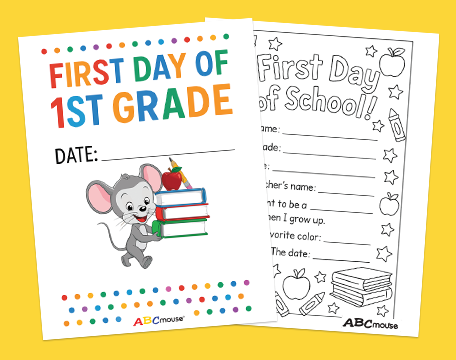
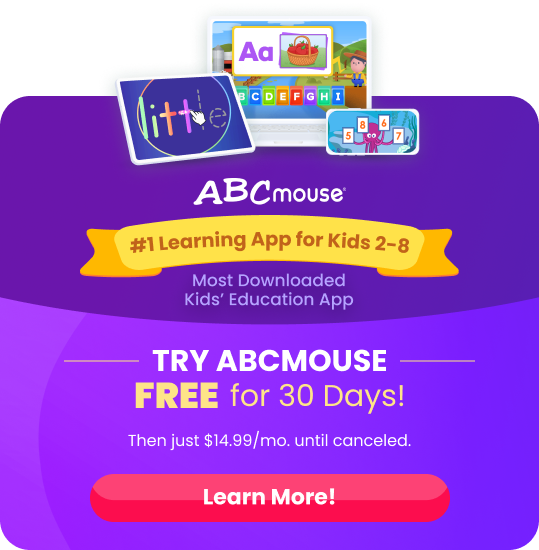
Print the Free Printable First Day of School Posters
From “Welcome to Kindergarten!” to “First Day of 3rd Grade!” and more, you’ll find over 20 different poster options to help celebrate back-to-school season for children in preschool through fifth grade. Choose from full-color versions that just need to be printed or black and white images your child can personalize and color.
More Free Printable Back-to-School Activities!
⭐ Back to School Worksheets & Printables
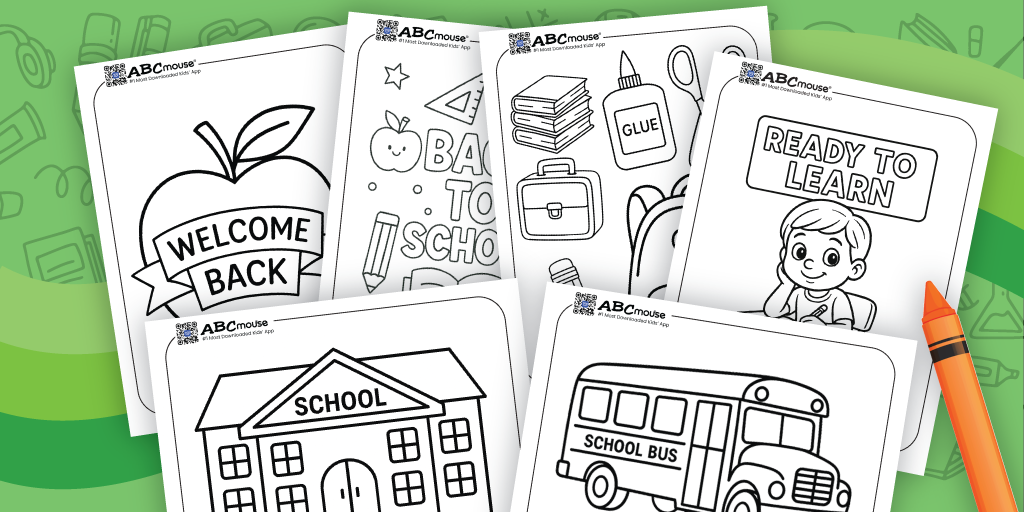
From coloring pages, word searches, and Bingo to classroom scavenger hunts and ice breaker activities, this collection of back to school printables helps make those first days of school even more exciting!
More Free Printable Coloring Pages
-
Peacock Coloring Coloring Pages
Download and print our free peacock coloring pages for kids and adults! Choose from a variety of cute and fancy designs, perfect for all ages. Enjoy…
-
Flamingo Coloring Coloring Pages
Discover a variety of free printable flamingo coloring pages for kids of all ages. From easy and cute baby flamingo designs for younger children to detailed…
-
Parrot Coloring Coloring Pages
Download free printable parrot coloring pages! From realistic to cute designs, enjoy a variety of parrot scenes and fun activities for kids of all ages.
-
Eagle Coloring Coloring Pages
Download free printable eagle coloring pages for kids! From realistic to cute designs, enjoy a variety of eagle scenes and fun activities to enhance learning.
-
Chicken Coloring Coloring Pages
Explore our free printable chicken coloring pages, featuring a range of cute and realistic designs for kids. Enjoy fun activities like creating a farmyard scene, puppet…
-
Owl Coloring Coloring Pages
Discover a delightful collection of free printable owl coloring pages for kids, featuring playful and detailed scenes. From cute baby owls to intricate designs for adults,…

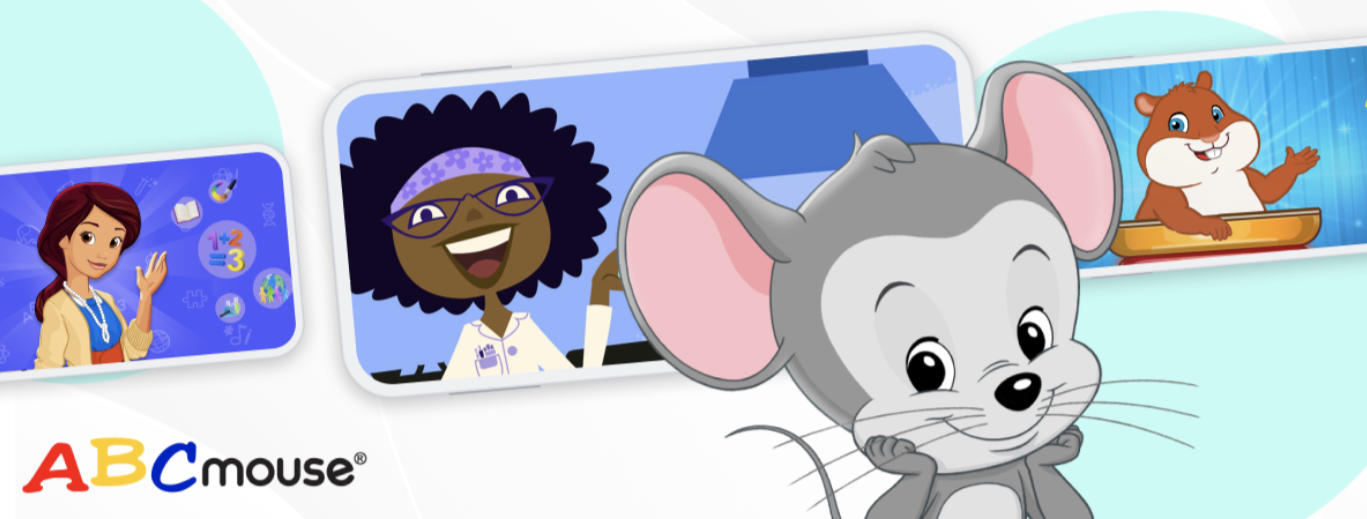
Using Early Learning Technology to Prepare Head Start Families for Kindergarten
See ABCmouse’s positive impact on an Oregon Head Start program.
Key Findings
- Data from a comprehensive assessment of school readiness showed that the more ABCmouse was used in a classroom over the course of the 2014–2015 school year, the better prepared students in that classroom were for kindergarten.
- Students in classrooms with higher than average ABCmouse usage saw significantly greater gains in school readiness than those in lower-usage classrooms.
- Teachers also found that ABCmouse was helpful in engaging families and fostering a meaningful classroom-to-home connection.
ABCmouse Research Brief Background
Access to high-quality preschool programs is a challenge for many families in the U.S. As a result, children often enter kindergarten unprepared and struggle to perform at grade level, which affects them for years to come. To aid in kindergarten readiness, the Head Start program provides comprehensive early childhood education, health, nutrition, and parent support services to low-income children and their families. But more than one million children who qualify for Head Start and Early Head Start are unable to enroll due to the high demand for limited spaces.1 These children often spend months or years on a wait list for a Head Start program, with limited or no options for affordable high-quality preschool while they wait.
Even when a family is able to enroll their child in a Head Start program, they may have few educational resources at home. Head Start teachers often struggle to find high-quality resources to engage parents in their child’s education and extend learning into the home—a key element of Head Start’s Parent, Family, and Community Engagement Framework.2
The Albina Head Start program (Albina) in Portland, Oregon, illustrates these challenges. Serving hundreds of low-income families every school year since 1965, Albina Head Start is a nationally recognized, award-winning organization. But like most Head Start programs, Albina does not have enough available spaces to meet the early learning needs of all eligible families in its community. Albina’s teachers also report unmet needs for educational resources to engage parents in their children’s development and education.
To help address these challenges, Albina partnered with Age of Learning, Inc., to provide enrolled and waitlisted children with free access to ABCmouse.com Early Learning Academy, a comprehensive supplemental digital learning resource for young children.
Using ABCmouse to Drive Student Achievement
In September 2014, Albina teachers began using ABCmouse as a supplemental curriculum in 25 classrooms with almost 500 students. A naturalistic study design was used in order to give all Albina students access to the ABCmouse curriculum: Age of Learning provided ABCmouse accounts to all Albina classrooms. Classrooms were expected to vary in the amount of their ABCmouse usage over the course of the year.3 Teachers recognized the value of ABCmouse immediately, especially in allowing them to differentiate instruction.
Data from a comprehensive assessment of school readiness showed that the more ABCmouse was used in a classroom over the course of the 2014–2015 school year, the better prepared students in that classroom were for kindergarten.4 An analysis of this data indicates that, on average, for every additional 100 ABCmouse learning activities completed by a student, there is a 3.6% boost in school readiness scores from the beginning to the end of the school year.5 Additionally, students in classrooms with higher than average ABCmouse usage saw significantly greater gains in school readiness than those in lower-usage classrooms, a statistically significant finding with a meaningful effect size (d = 0.36, p < .001).6
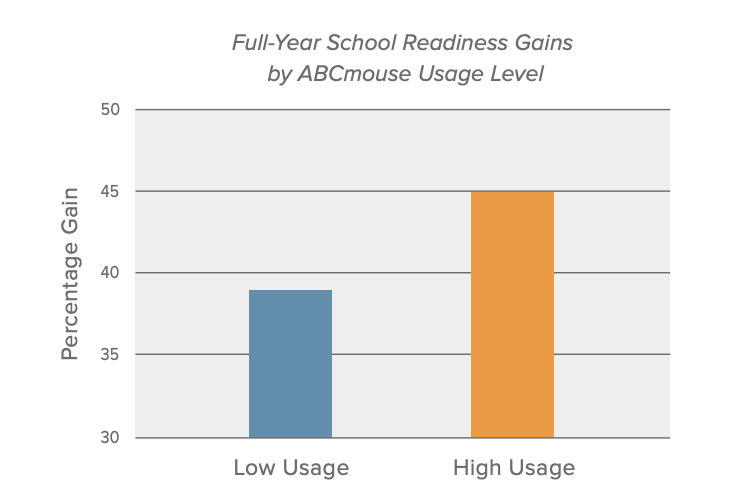
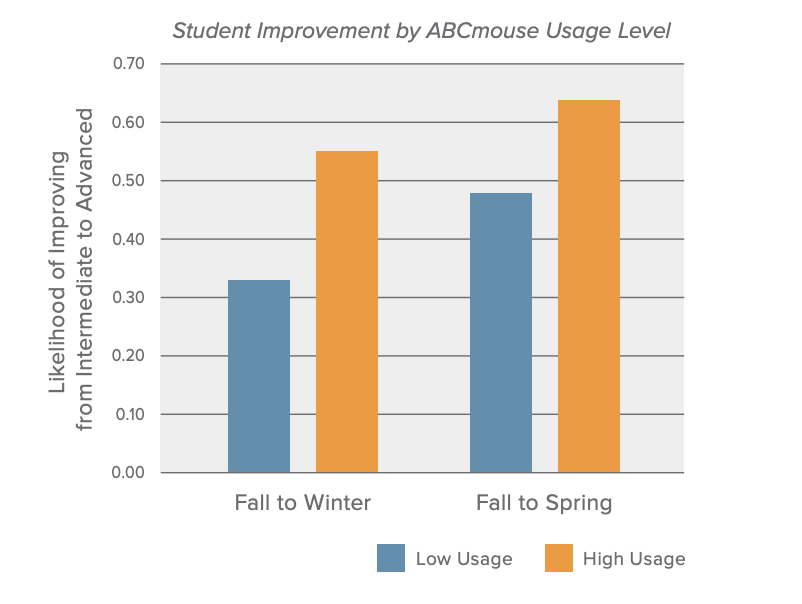
Moreover, students in high ABCmouse usage classrooms were 1.6 times more likely to advance from Intermediate to Advanced levels on School Readiness Goals during the fall than students in low usage classrooms, and they were 1.3 times more likely to make such an improvement over the course of the full school year.7
Strengthening the Head-Start-to-Home Connection
Beyond the benefits experienced in the classroom, Albina teachers also found that ABCmouse was helpful in engaging families and fostering a meaningful classroom-to-home connection.
Parent engagement is typically defined as parent behavior in support of a child’s educational progress at home or in school.8 Three decades of research have demonstrated that parent/family involvement contributes in different ways to improved student outcomes related to learning and school success.9 These findings have remained consistent despite the fact that the makeup of families and schools has changed over time.10
Ms. Araya, who has been teaching at Albina Head Start for seven years, has a classroom of 20 children between three and five years old. Ms. Araya was initially excited by the scope and organization of ABCmouse. She soon came to appreciate that ABCmouse also offered a way for her to connect with parents and engage them in their children’s learning: classroom-linked home accounts that allowed teachers to assign lessons to students to complete at home with their families.
To increase family involvement, Ms. Araya explained the program during parent-teacher conferences and printed free access codes so that students could easily access learning activities at home. Ms. Araya’s classroom had among the highest usage rates of ABCmouse learning activities at home and school. She reported that children who used ABCmouse at home accelerated their learning. “I feel that children who have access to ABCmouse at home are more advanced. For instance, one of my students who worked on ABCmouse at home completed a whole ABCmouse level and received a certificate before the other students.”
Research has shown that family involvement predicts a child’s academic achievement and social development as they progress from early childhood programs through K–12 schools and into higher education.11 A recent meta-analysis found moderate associations between parent involvement and a group of learning-related or academic skills—including achievement, motivation, task-persistence, and receptive vocabulary—during preschool and kindergarten.12 A study of Head Start students evidenced that more parent involvement was associated with fewer classroom behavior problems.13
As a Head Start teacher, Ms. Araya has 160 learning goals to achieve with her students. She discovered that ABCmouse helped her students attain these goals. She tracked the time each student spent on ABCmouse at home and school and tried to give more time at school to those students who lacked access to the ABCmouse learning activities at home.
She also reported that students with limited English-speaking skills accelerated their vocabulary development by using ABCmouse. Furthermore, using ABCmouse in the classroom increased students’ cooperative behavior. Ms. Araya explained that “in using ABCmouse, children have learned how to share the computers and take turns. They know that each student has a limited time to play and they respect that without fighting. They even help each other with the activities!”
Ms. Araya’s experience illustrates that ABCmouse usage helps Head Start students improve their performance on School Readiness Goals and also provides an opportunity to engage parents in their children’s learning experience.
Engaging Wait-listed Head Start Families
In November 2014, Age of Learning also extended full ABCmouse home account access to families who were wait-listed for the Albina program. One of the many Portland parents waiting for a space to open up at Albina was Kenya B. Her daughter, five-year-old Ja’Nyah, had been on the wait list for two years. As soon as ABCmouse became available to wait-listed families, Kenya created an ABCmouse account for her daughter. She reported that after using ABCmouse for just a few months, Ja’Nyah made notable progress in several areas: She was able to self-correct when counting out loud, and improved her ability to identify letters and numbers, as well as learned many letter sounds.
Kenya also reported that ABCmouse helped her to better connect with her daughter’s learning. “ABCmouse is not overwhelming and you can be part of your kid’s learning. As a parent you feel that there are not enough hours in a day to do everything you need to do. ABCmouse makes it easier for you to sit and learn with your child. You are actually learning how your child learns.”
The accelerated learning that Ja’Nyah’s mother witnessed was also seen in Ja’Nyah’s performance on an online assessment of seven early literacy and math skills developed by SRI International, which she completed before using ABCmouse and again four months later. Prior to using ABCmouse, Ja’Nyah was unable to answer questions correctly for four skills: naming lowercase letters, producing consonant sounds, cardinality, and adding two sets. She scored between 25% and 43% on other skills, which included counting up, recognizing numbers 1–20, and counting objects. After using ABCmouse for four months, Ja’Nyah’s performance improved dramatically: She scored between 83% and 100% on most skills, and no lower than 40% on the remaining skills for which she tested.
In addition to Ja’Nyah’s significant academic growth, Kenya also observed positive changes in her daughter’s approach to learning. “When we first started using ABCmouse, she always needed me by her side and asked for my help. Now she can complete the learning activities on her own, and she is more patient, independent, and self-assured. She is also more confident when interacting with other kids.”
According to Kenya, the positive impacts she observed with ABCmouse on Ja’Nyah’s approach to learning was in contrast to unsuccessful experiences with other learning resources. “Before we started ABCmouse, I bought all these educational books. Sometimes she cried because she could not do the learning activities. Now, with ABCmouse, she can understand the learning activities and feels confident.”
Ja’Nyah and Kenya’s experience shows how ABCmouse can help children develop key academic and social-emotional skills needed for success in school and can also engage parents in their children’s learning, which further supports improved student outcomes.
Summary
Parents, teachers, and administrators at Albina were pleased to see how much ABCmouse contributed to children’s academic readiness and how it helped families engage more deeply in their children’s learning. The experiences shared by Ms. Araya and Kenya B. illustrate the positive outcomes that can result when families have access to high-quality digital educational tools during critical early learning years.
These experiences using ABCmouse both in the classroom and at home suggest that high-quality digital educational tools can be more effective when they foster a home-school connection.
Notes:
† Independent Educational Consultant.
†† Senior Analyst, Assessment & Evaluation, Age of Learning, Inc.
††† Director of Research & Educational Partnerships, Age of Learning, Inc.; formerly Assistant Professor and Director of Early Childhood Education Master’s Program, Loyola Marymount University.
1. Investing in Young Children: A Fact Sheet on Early Care and Education Participation, Access, and Quality (2013).
2. The Head Start Parent, Family, and Community Engagement Framework Promoting Family Engagement and School Readiness, from Prenatal to Age 8 (2011).
3. ABCmouse usage varied across classrooms, including whole class, small group, and individual usage; some teachers assigned ABCmouse learning activities for use at home as well as in the classroom.
4. Albina teachers assess 160 School Readiness Goals covering five knowledge areas—Cognition and General Knowledge, Language and Literacy, Approaches to Learning, Social and Emotional Development, and Physical Development and Health—three times during the school year: in November, January, and April. To be deemed school-ready for a goal, the child must demonstrate through direct observation that they are able to accomplish the goal consistently. There are three school readiness performance levels: Beginner (0–52 goals), Intermediate (53–106 goals), and Advanced (107–160 goals).
5. A multiple regression analysis found that the amount of ABCmouse usage was a strong predictor of learning growth, controlling for children’s initial School Readiness Goals assessment in the fall, F(2,421) = 20.98, p < .001, R2 = .09.
6. Students in “high-usage” classrooms completed on average more than the Albina-wide mean of 119 ABCmouse learning activities per student over the course of the school year; students in “low-usage” classrooms completed less than 119 activities on average. Prior to using ABCmouse there was no significant difference in School Readiness scores between students in classrooms that subsequently had high usage versus low usage.
7. High-usage classrooms had significantly higher percentages of students who improved from Intermediate to Advanced on School Readiness Goals than lowusage classrooms, with very large effect sizes (Fall to Winter: 55% vs. 33%, p = .001, d = 1.51; Fall to Spring: 64% vs. 48%, p = .007, d = 1.18).
8. Fantuzzo, Tighe & Childs, 2000; Hara & Burke, 1998.
9. Reynolds, 1992: Marcon, 1999.
10. Drake, 2000; Fan & Chen 2001; Buttery & Anderson, 1999.
11. Weiss, Caspe, & Lopez, 2006: Griffith, 1996.
12. Fan & Chen, 2001; Faires, Nichols & Rickelman, 2000.
13. Fantuzzo et al., 2004; El Nokali, Bachman, & Votruba-Drzal, 2010.
References:
Buttery, T. J. & Anderson, P. J. (1999). Community, school, and parent dynamics: A synthesis of literature and activities. Teacher Education Quarterly, 26(4), 111–22.
Center for Law and Social Policy (CLASP) AND National Center for Children in Poverty (NCCP) Investing in Young Children A Fact Sheet on Early Care and Education Participation, Access, and Quality. http://www.nccp.org/publications/pdf/text_1085.pdf
Drake, D. D. (2000). Parents and families as partners in the education process: Collaboration for the success of students in public schools. ERS Spectrum, 34–35.
El Nokali, N. E., Bachman, H. J. & Votruba-Drzal, E. (2010). Parent involvement and children’s academic and social development in elementary school. Child Development, 81(3), 988–1005.
Fan, X. T. & Chen, M. (2001). Parental involvement and students’ academic achievement: A metaanalysis. Educational Psychology Review, 13, 1–22.
Faires, J., Nichols, W. D. & Rickelman, R. J. (2000). Effects of parental involvement in developing competent readers in first grade. Reading Psychology, 21, 195–215.
Fantuzzo, J., Tighe, E. & Childs, S. (2000). Family Involvement Questionnaire: A multivariate assessment of family participation in early childhood education. Journal of Educational Psychology, 92(2), 367–370.
Fantuzzo J., McWayne C. & Perry M. A. (2004). Multiple dimensions of family involvement and their relations to behavioral and learning competencies for urban, low-income children. School Psychology Review, 33, 467–480.
Griffith, J. (1996). Relation of parental involvement, empowerment, and school traits to student academic performance. Journal of Educational Research, 90, 33–41.
Hara, S. R. & Burke, D. J. (1998). Parent involvement: The key to improved student achievement. School Community Journal, 8(2), 9–19.
Marcon, R. A. (1999). Positive relationships between parent school involvement and public school innercity preschoolers’ development and academic performance. School Psychology Review, 28(3), 395–412.
Reynolds, A. J. (1992). Comparing measures of parental involvement and their effects on academic achievement. Early Childhood Research Quarterly, 7, 441–462.
U.S. Department of Health and Human Services, Administration for Children and Families, Office of Head Start. The Head Start Parent, Family, and Community Engagement Framework Promoting Family Engagement and School Readiness from Prenatal to Age 8 (2011). http://eclkc.ohs.acf.hhs.gov/hslc/standards/im/2011/pfce-framework.pdf
Weiss, B. H., Margaret C. & Elena L. (2006). Family Involvement in Early Childhood Education. Amherst, MA: Harvard Family Research Project.
TM & © 2016 Age of Learning, Inc. All rights reserved. The names of other companies, products, and services are the property of their respective owners.
Letter Z Crafts & Activities for Preschoolers
Share
Fun crafts and activities add some zest to learning the shape and sound of the letter Z!
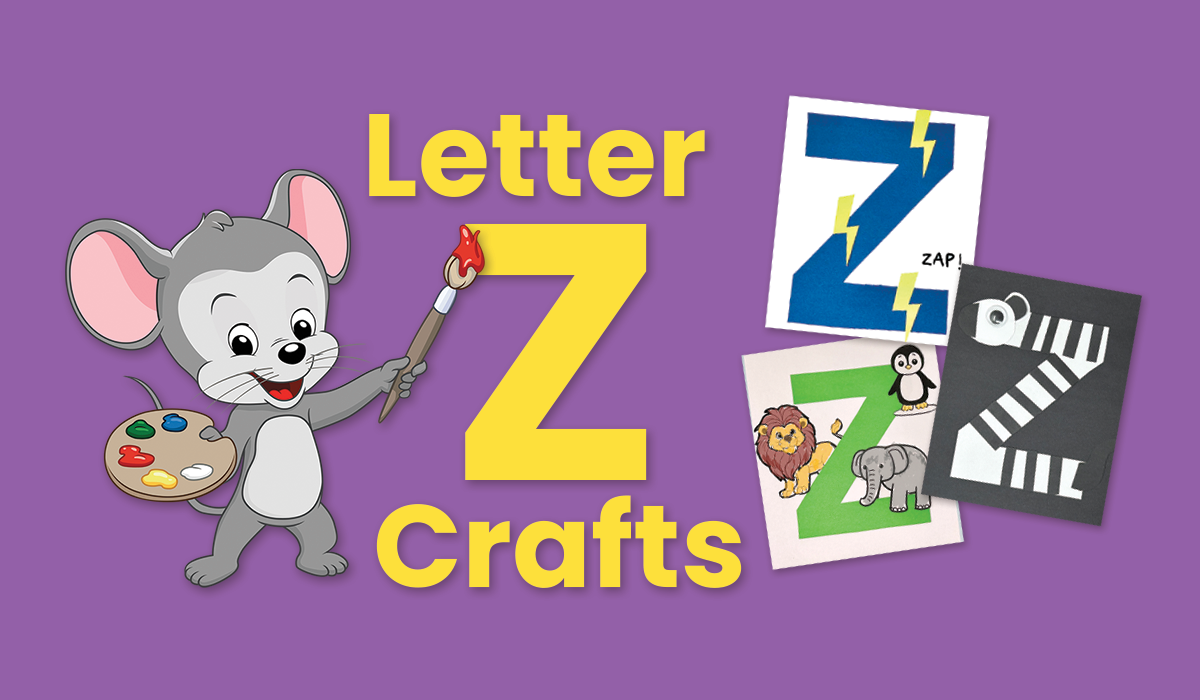
Table of Contents
As the final letter in the alphabet, Z stands out with its unique sound found in words like zebra and zip. These easy, hands-on crafts and activities make it simple to explore the letter Z together using everyday supplies and a little imagination. While these letter Z crafts are designed for young children, we recommend having an adult nearby to help supervise, especially when a scissors is being used.
Some of these letter Z crafts and activities are easier with a big letter Z outline. You can draw one yourself or use a free printable from our collection of letter Z worksheets.
1. Z is for Zigzags
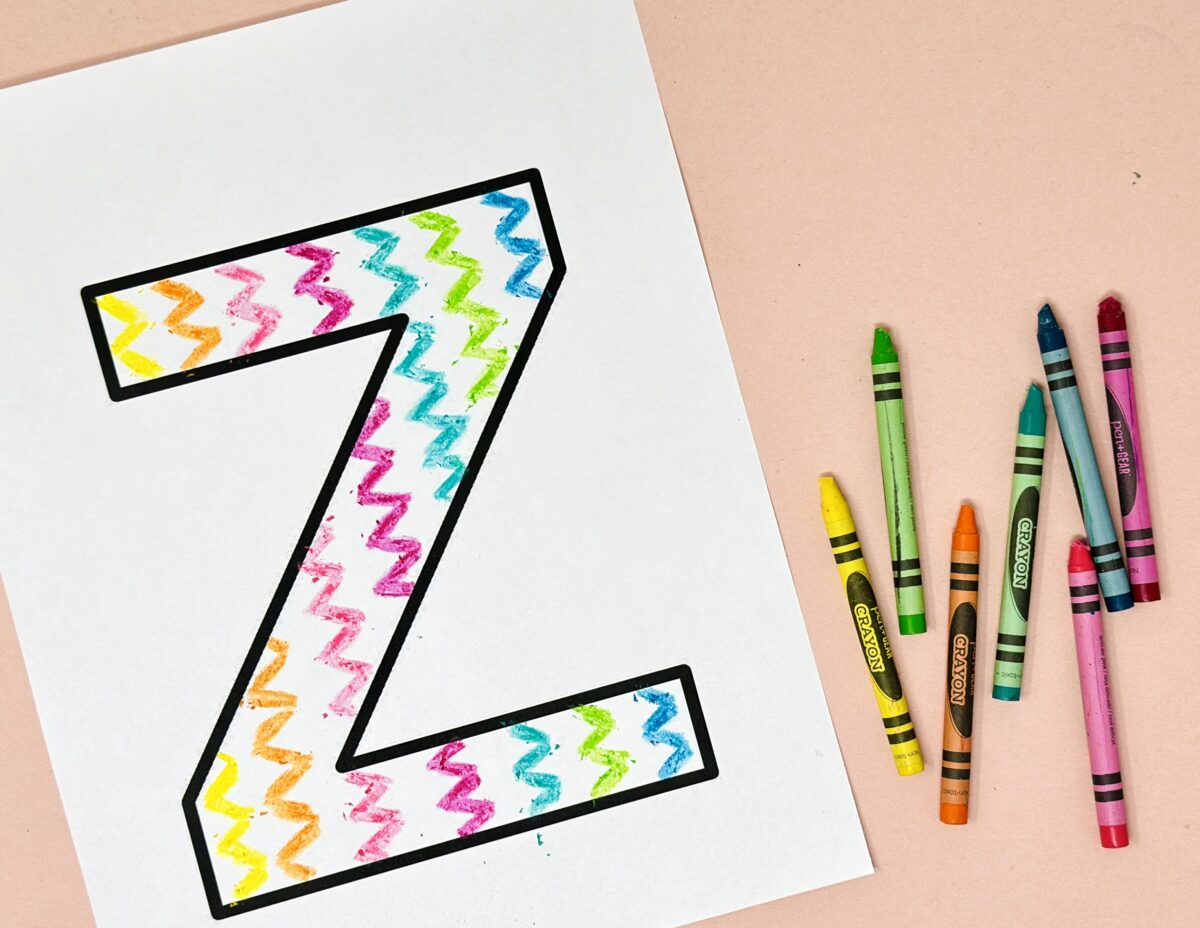
Fill the letter Z with zillions of zigzags in this letter craft!
Required Materials
- colorful crayons
- white paper
- letter Z template
How To
Print out or draw an outline of the letter Z onto a piece of white paper. Have your child pick several colors from their crayons, markers, or colored pencils (glitter glue is also fun here). Show you child what the shape of a zigzag looks like and point out the two letter Zs in the word. Then, have your child fill in their letter Z outline with as many colorful zigzags as possible.
2. Z is for Zebra Craft

Find some zen by cutting and pasting zebra stripes onto the letter Z!
Required Materials
- googly eyes
- black and white paper
- glue
- scissors
How To
Print out or draw the outline of the letter Z onto a piece of white construction paper. Next, cut out a round white face, black nose, white and black ears (make the white ears slightly larger than the black), and a black tail. Then, cut out a strip of black paper that’s the same width as your letter Z. Trim this into skinnier strips to create the zebra’s stripes.
Have your child assemble the zebra’s face and tail, gluing down the googly eye, nose, ears, and tail. Then, move onto the stripes, arranging them in the letter Z and gluing them into place. Add in some math practice by counting the zebra’s stripes when you’re done!
Tip: Have some more fun with zebras by printing out this free zebra coloring page from ABCmouse.
3. Z is for Zinnia
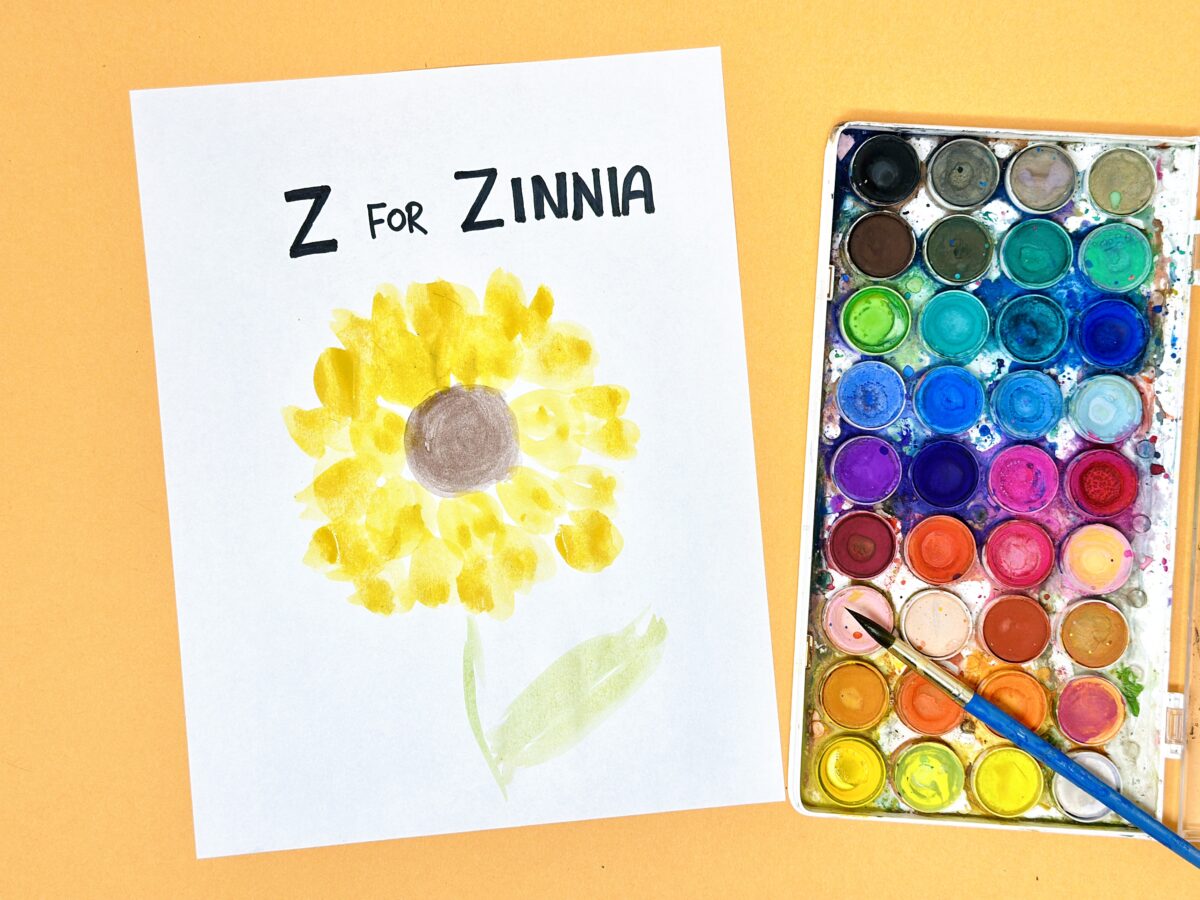
Use watercolors to create a vibrant zinnia!
Required Materials
- thicker white paper
- watercolor paint
- paint brush
- water
How To
To create the zinnia, have your child use brown paint to form a small circle towards the center of the page. Next, add petals around the circle in any color of your child’s choice. Add two or three more layers of petals to make a large zinnia flower. Add a stalk and leaf to finish!
Tip: Keep the flower-themed fun going with our free printable flower coloring pages!
4. Z is for Zap Craft
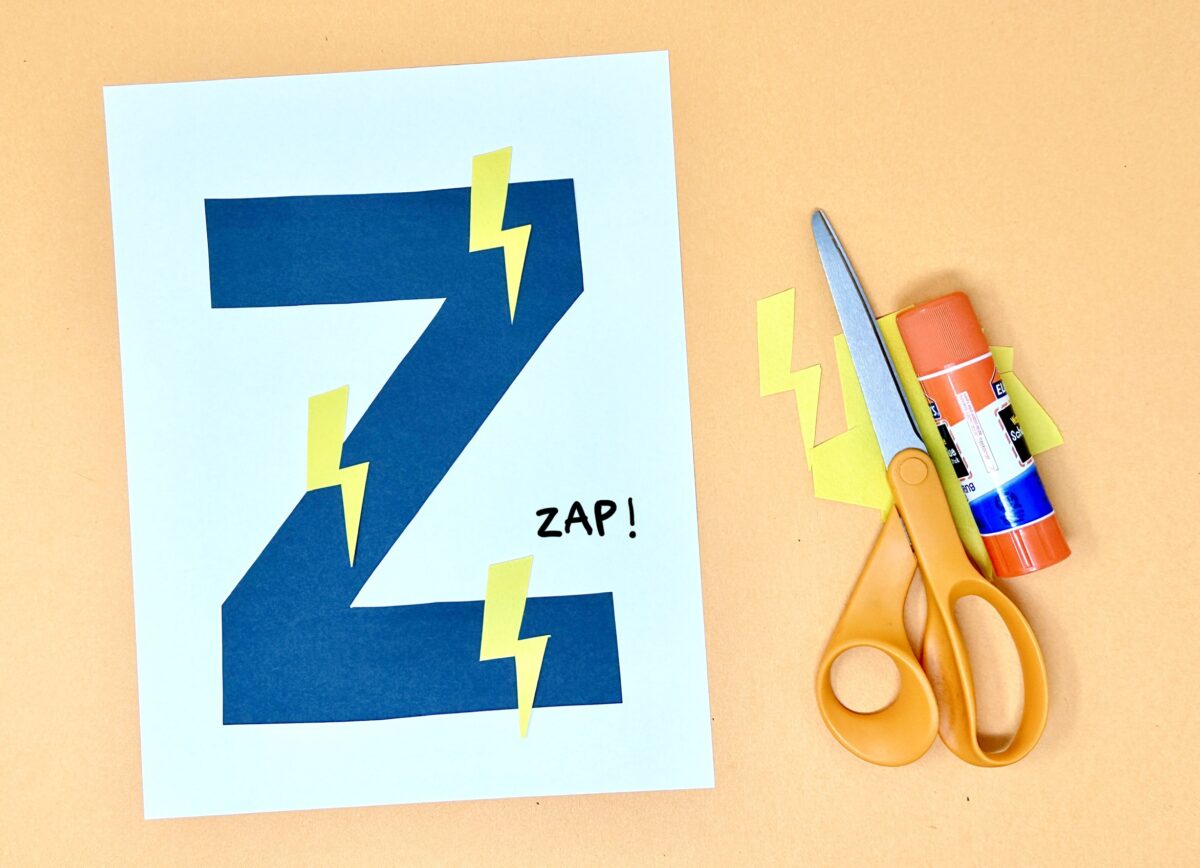
Make learning about the letter Z an electrifying experience with this simple craft!
Required Materials
- white, blue, and yellow construction paper
- scissors
- glue
- markers
How To
Trace the outline of a letter Z onto blue construction paper and cut it out. Then, draw several lightning bolt shapes onto the yellow construction paper and cut those out. Glue down the letter Z and arrange the lightning bolts around it. Then, write it the words zap! around the page to help your child connect the letter Z shape and sound with this word.
5. Z is for Zero Activity
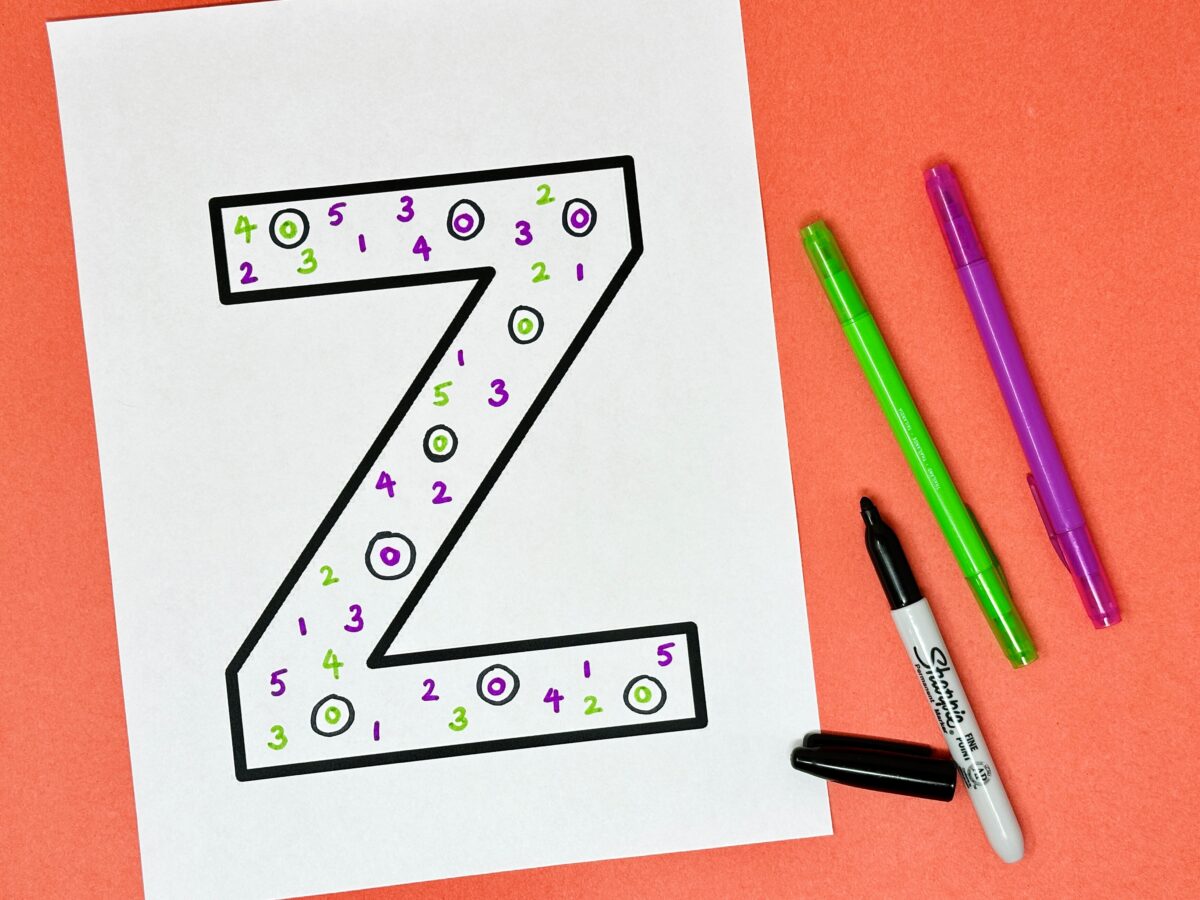
Turn the letter Z into a number hunt as kids search for the number zero! This is a great number recognition activity.
Required Materials
- different colored markers
- white paper
- letter Z template
How To
Draw or print out the outline of a letter Z onto a piece of white paper. Write a variety of numbers between 0 and 5 inside of the letter Z. Ask your child to search for and circle of the zeros they can find!
Tip: If your child is ready for it, continue working on number recognition by asking them to circle other numbers in certain colors. For example, have your child circle the number 1 in yellow, and the number 2 in blue, etc…
6. Letter Z Coloring Activity
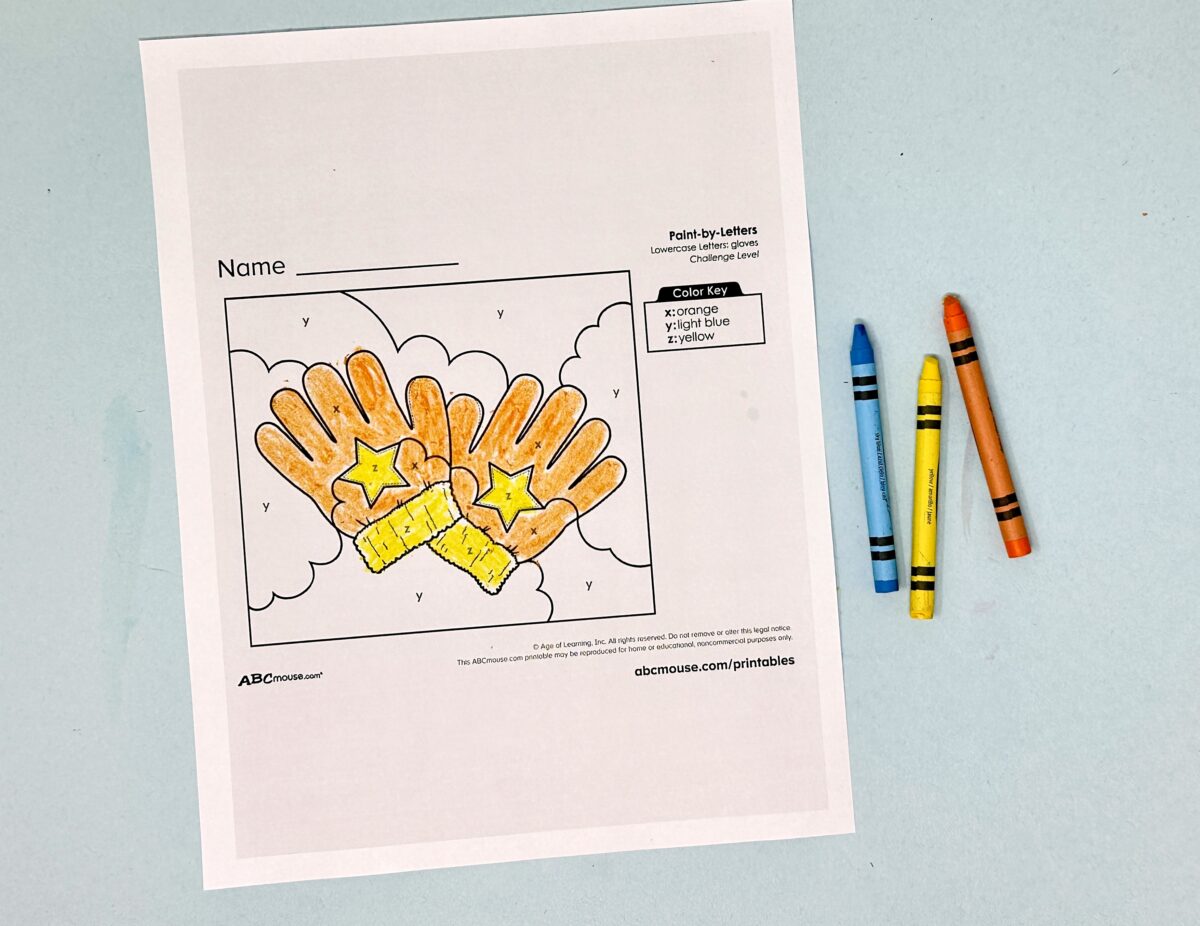
This simple color-by-letter activity encourages children to get creative while identifying the letter Z.
Required Materials
- color-by-letter worksheet
- crayons
How To
For an easy quiet time activity, print out this color-by-letter sheet featuring the letters X, Y, and Z. Children will use the color key to guide them in determining which letter gets which color. By the time they finish, they’ll have created a lovely alphabet illustration.
7. Z is for Zipper Craft
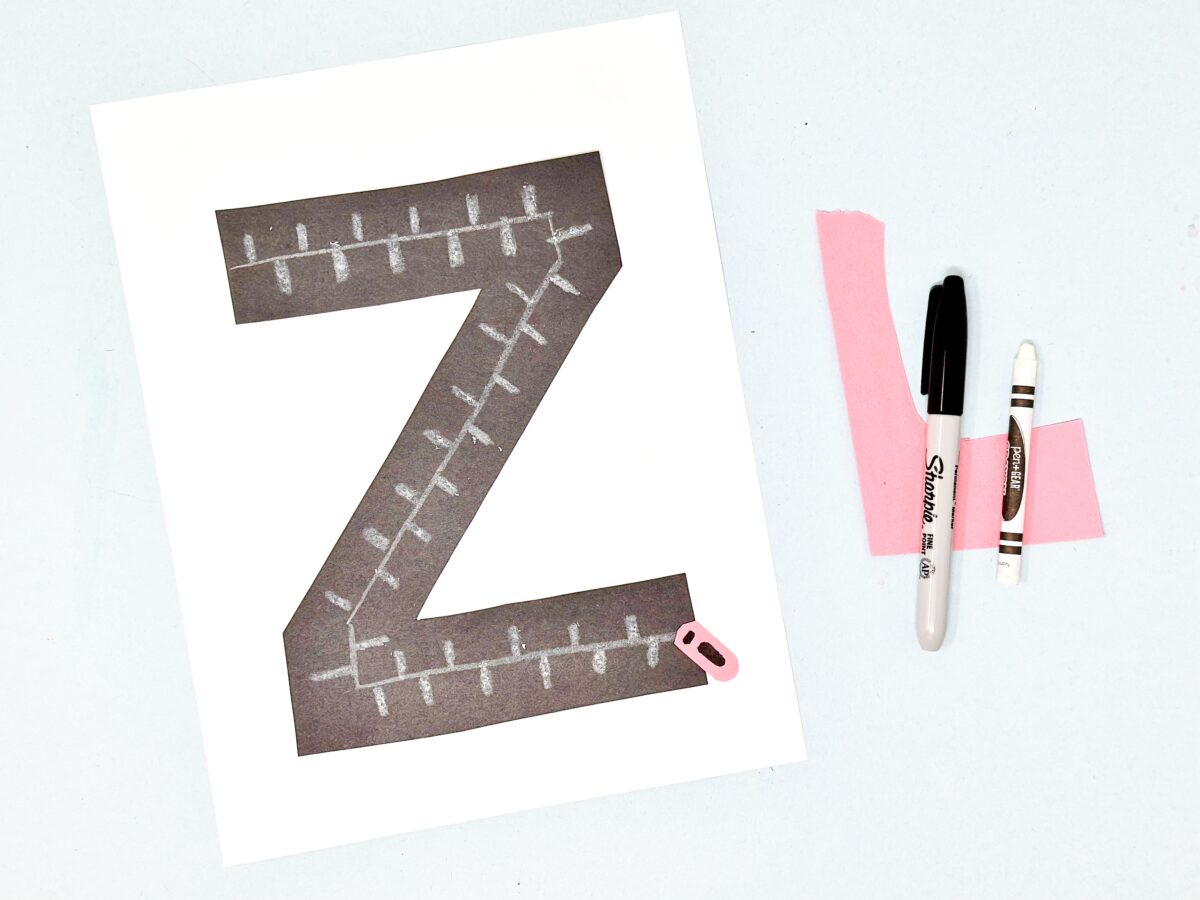
Unzip creativity with this easy letter Z craft!
Required Materials
- construction paper
- marker
- crayons
- glue
How To
For this letter craft, start by tracing and cutting out the outline of a letter Z onto a piece of construction paper (any color is fine). Next, use a crayon that will stand out against your paper to draw a line down the center of the letter Z, going from end to end. Then, create the zipper’s teeth by adding small alternating dashes to either side of the middle line. Make a zipper pull from a small oblong piece of construction paper or by simply drawing it in with your crayon or marker.
8. Z is for Zucchini Craft
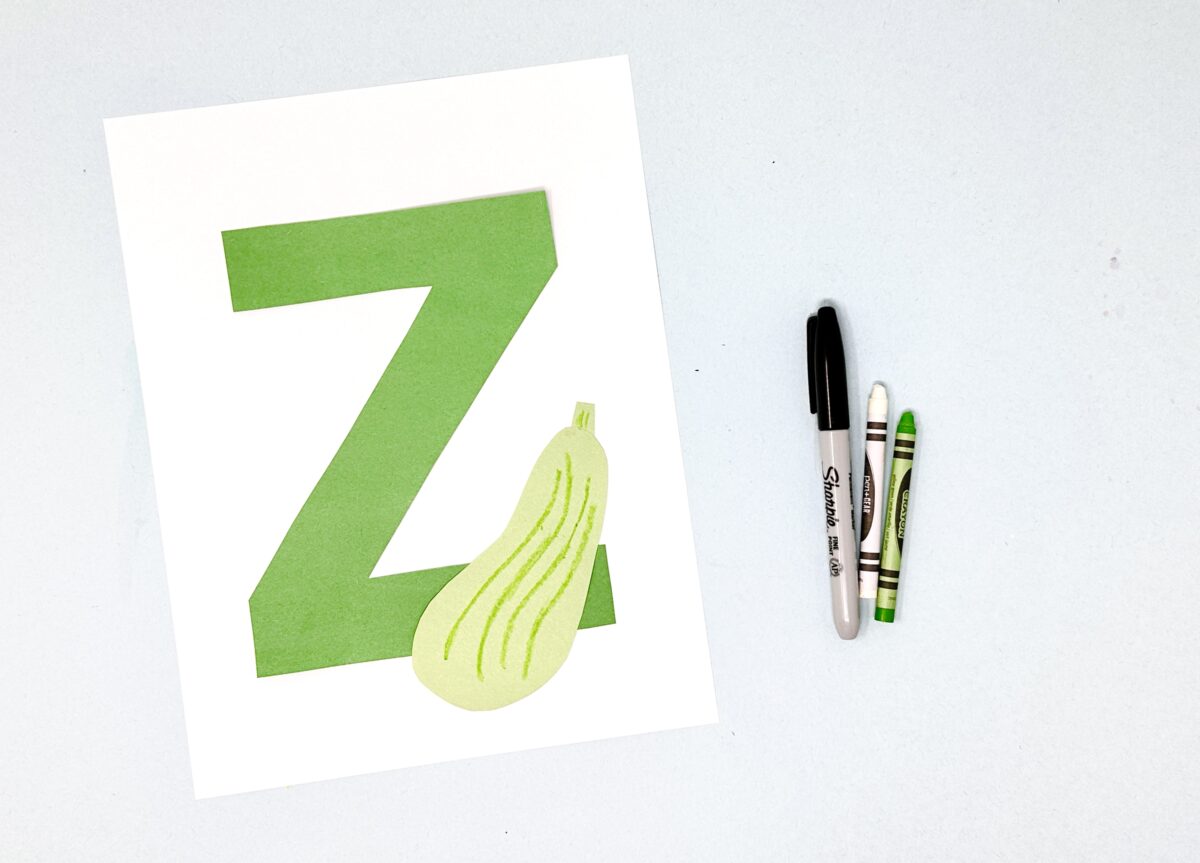
Make this craft a little zany by adding googly eyes and a face to your zucchini. Or, bake up some zucchini bread as another way to explore this letter and veggie that’s technically a fruit!
Required Materials
- green paper
- scissors
- glue
- crayons
How To
Trace and cut out the outline of the letter Z using any color of paper you’d like. Next, study the shape and color of a zucchini by purchasing one from the store or by looking at a picture. Then, draw the shape of a zucchini onto a piece of green paper and cut it out. Use crayons to draw in its lines and colors. Finally, glue the letter Z and the zucchini onto a piece of paper.
9. Z is for Zzz Craft
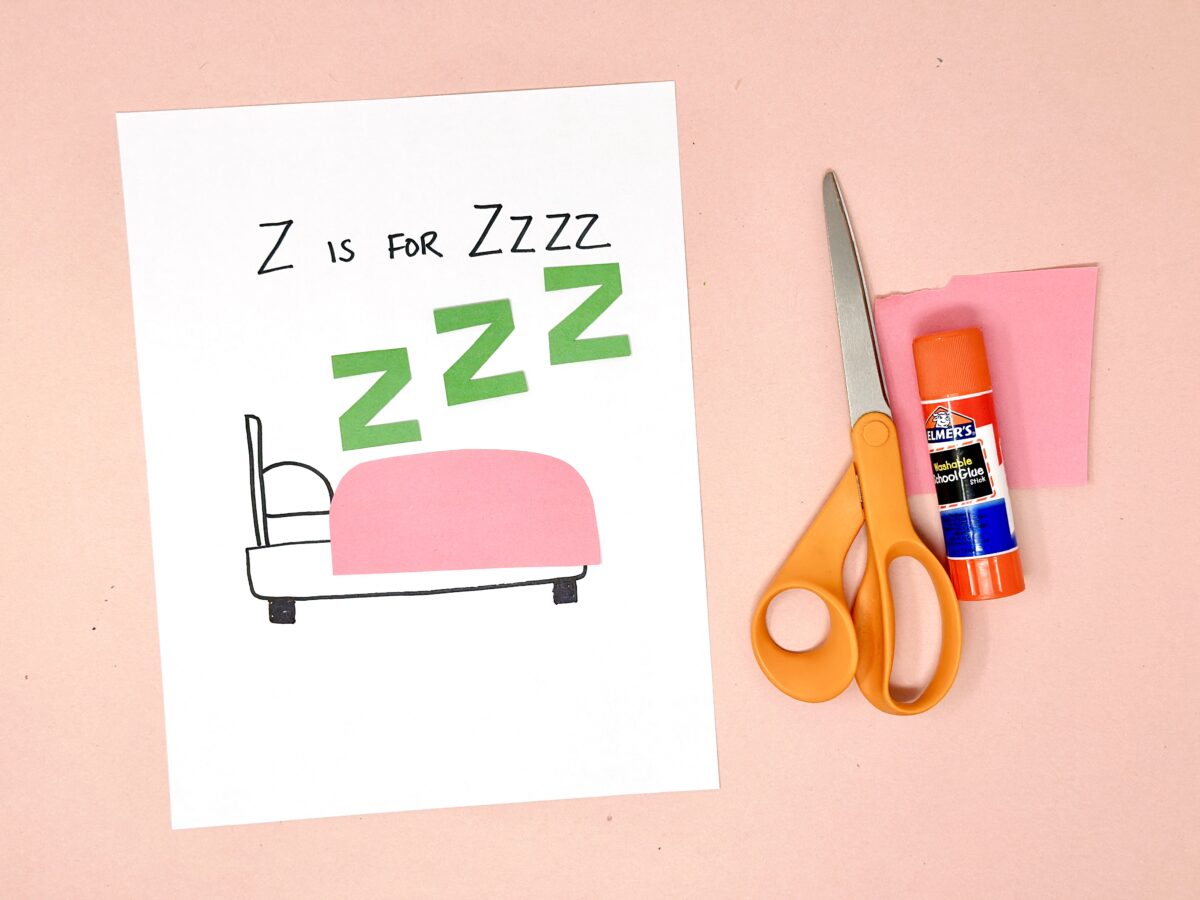
The letter Z is totally zonked out in this craft! Perhaps it will inspire a nap later?
Required Materials
- paper in two different colors
- white paper
- marker
- scissors
- glue
How To
Begin by selecting two pieces of paper in different colors. Choose one for your letter Zs and one for your bed cover. Next, trace and cut out the outline of three letter Zs. Then, use a pencil to draw a bed onto a piece of white paper. When you’re happy with your bed’s appearance, go over the pencil lines with a marker and trace and cut out a bedspread for it from the other piece of colored paper. Finally, glue the letter Zs and the bedspread onto the paper. At the very top, write Z is for Zzzzz.
10. Z is for Zoo Activity
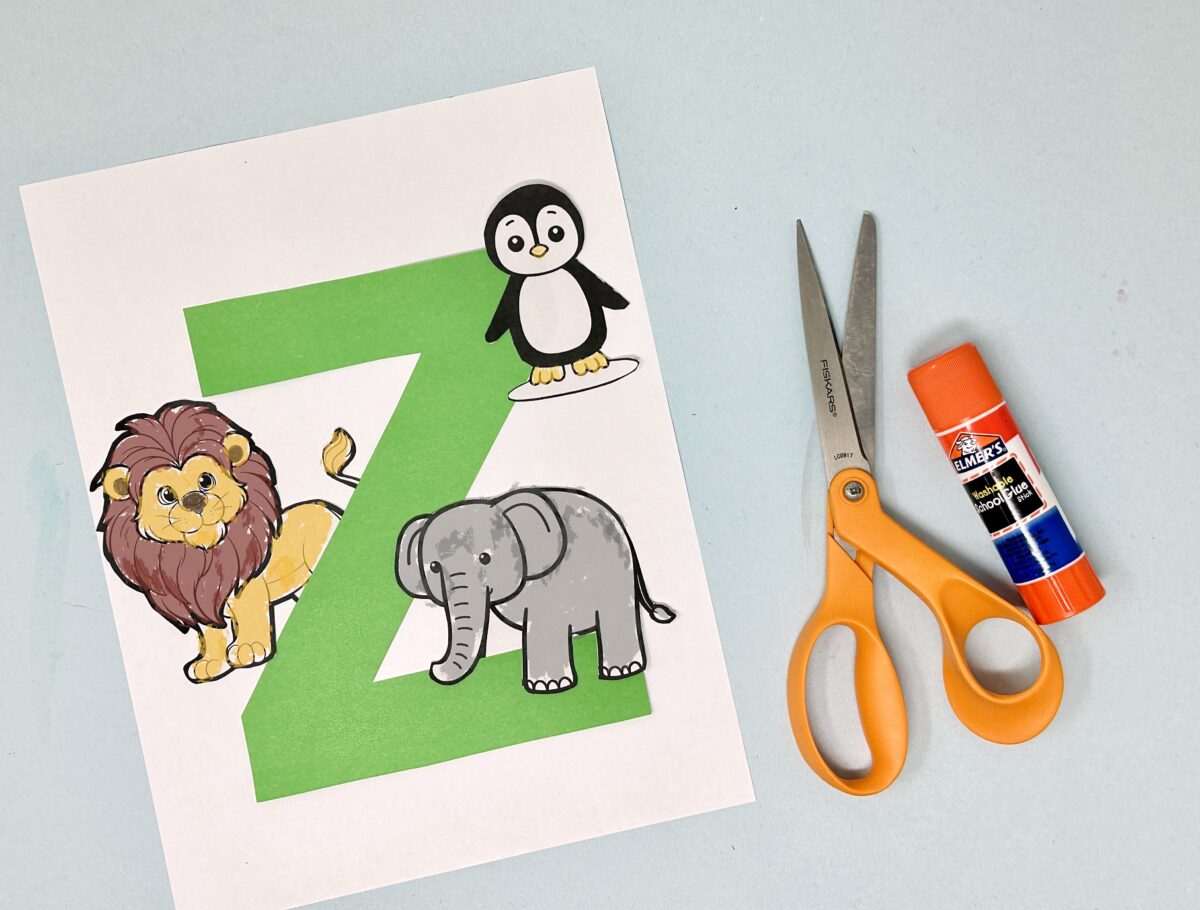
Explore the letter Z and zoo animals in this simple letter Z craft.
Required Materials
- colored paper
- white paper
- zoo animal templates
- scissors
- glue
How To
For this activity, begin by printing and coloring a few zoo animal coloring pages. Then, carefully cut out a few of the zoo animals. Next, draw and cut out the outline of a letter Z from a piece of construction paper. Finally, glue down the letter Z and the zoo animals.
Tip: Keep exploring the zoo from home with our collection of free Zoo Crafts, Coloring Pages, Games, and Activities.
More Letter Z Fun
Delight your child with more fun ways to explore the letter Z, including:
The ideas, pictures, and copy for this post were provided by Smitha Katti from smilingcolors.com
Letter Y Crafts & Activities for Preschoolers
Share
Liven up letter learning with imaginative crafts and activities all about the letter Y!
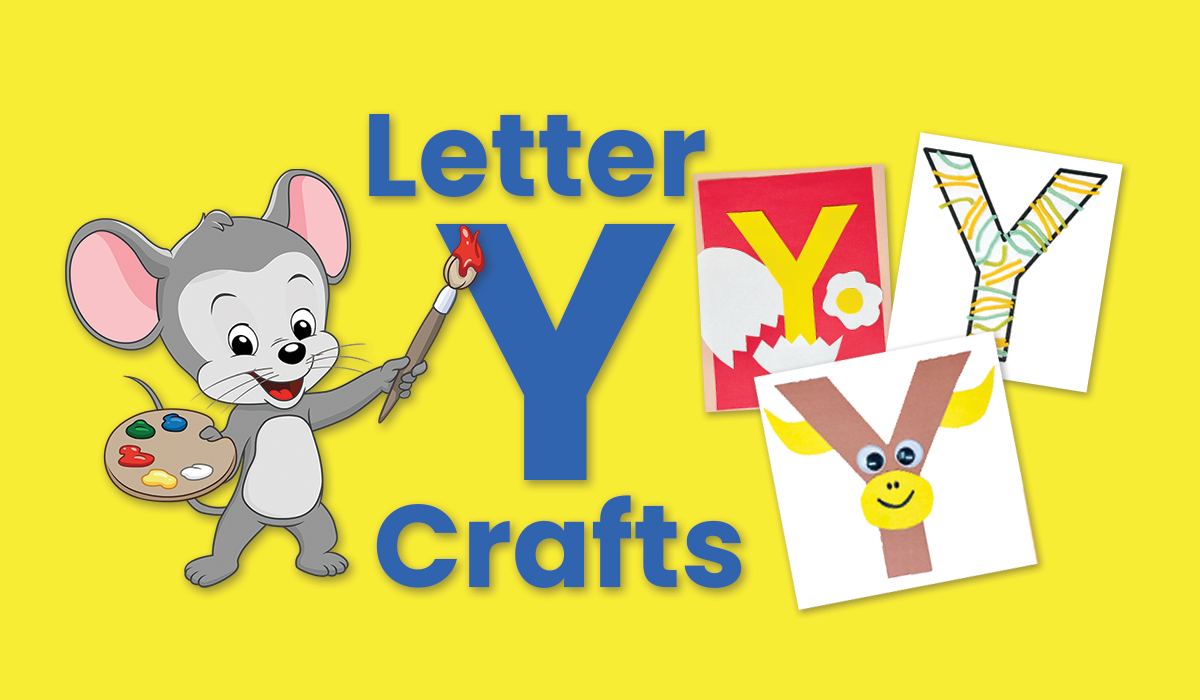
Table of Contents
Make learning the sound and shape of the letter Y a fun adventure with engaging letter Y crafts and activities designed to help kids connect with this consonant that’s sometimes a vowel. Using basic craft supplies and a little help from an adult, children can dive into hands-on projects that bring the letter Y to life.
Some of these letter Y crafts and activities work best with a big letter Y shape. You can sketch one by hand or grab a free printable from our collection of letter Y worksheets.
1. Y is for Yuck Craft

Get in some yuks (as in laughter) while you create this Y is for Yuck face!
Required Materials
- white and pink paper
- scissors
- glue
- marker
How To
Have your child use a black marker to draw a large circle. Draw two squinting eyes and a big upside down smile. Then, color in the frown with a black marker. Next, cut out the tongue for your yuck face by trimming a long rectangle with curved ends from a sheet of pink construction paper. Glue the tongue in place and have your child try writing Y is for Yuck on the page.
2. Y for Yak Craft
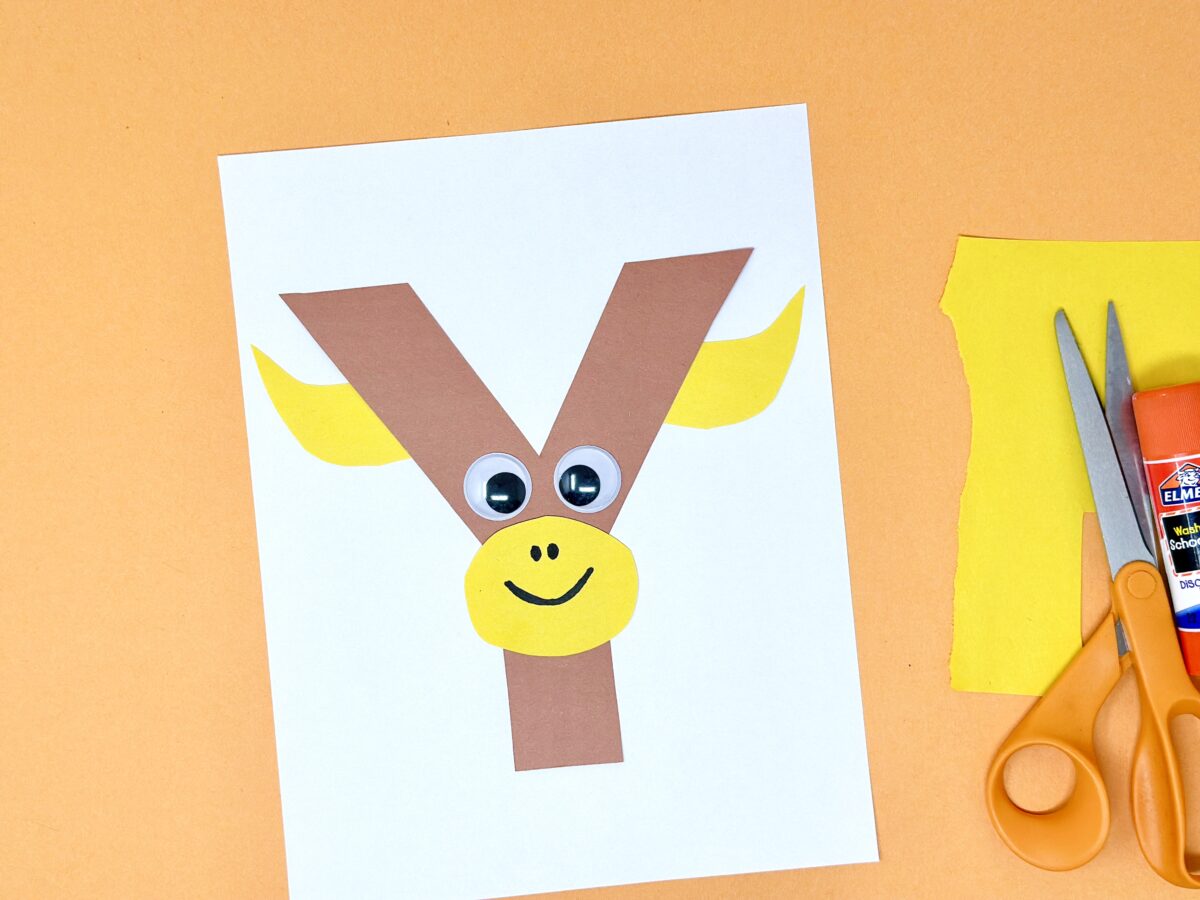
Who knew if could be this easy to transform the letter Y into a yak?!
Required Materials
- googly eyes
- yellow and brown paper
- black marker
- glue
- scissors
How To
Cut out the letter Y from a piece of brown construction paper. Next, cut two horn shapes and a large circular muzzle from yellow construction paper. Have your child arrange the yak’s horns and muzzle onto the letter Y and glue them down. Then, let them draw a nose and a smile onto the muzzle and glue down two goggly eyes to finish the yak!
3. Letter Y Pipe Cleaners Activity
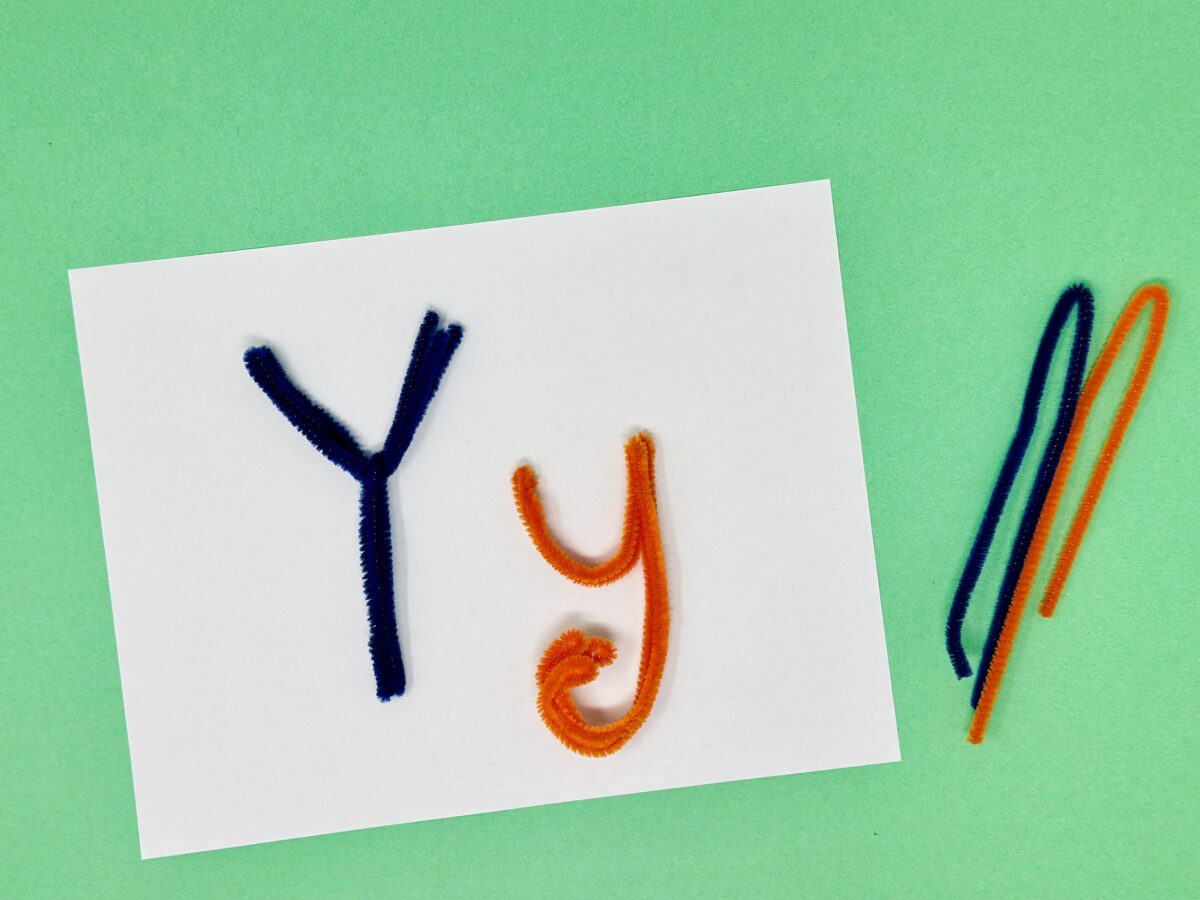
Give pipe cleaners a few little yanks and twists to form them into an uppercase and lowercase letter Y!
Required Materials
- white paper
- pipe cleaners in different colors
How To
This is a fun activity for children to practice creating the shape of the letter Y using pipe cleaners. For a little added stability, use 3 to 4 pipe cleaners twisted together to create each letter Y. Have your child try creating both an uppercase and lowercase Y if they’re up for the challenge! The white paper helps show off the shape and color of the Ys they create, or you can try gluing the letter Ys down.
4. Y is for Yo Yo Craft
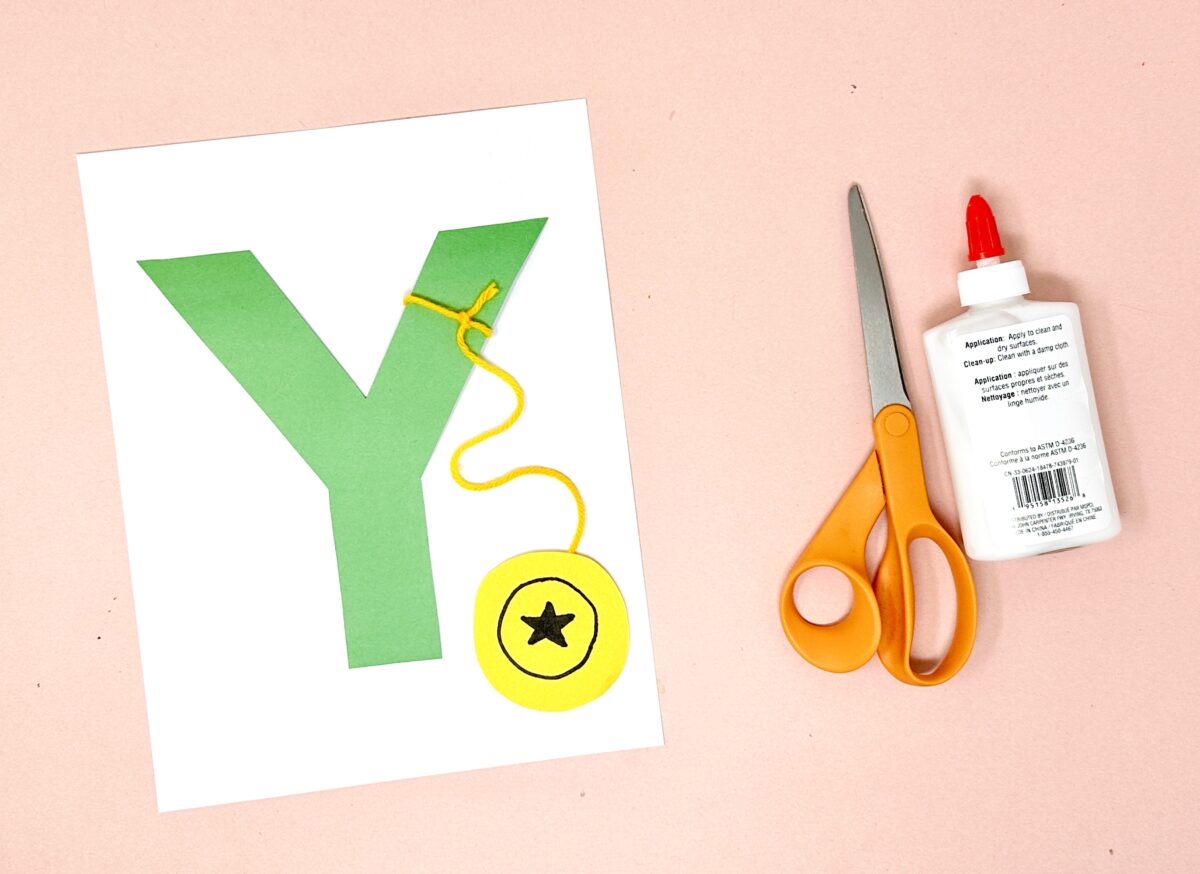
An uppercase letter Y makes a great place to hang a yo-yo!
Required Materials
- colored construction paper
- scissors
- glue
- yarn
- markers
How To
Have your child pick out a piece of construction paper of any color. Trace the shape of an uppercase letter Y onto the paper and cut it out. Then, draw a small circle onto another piece of construction paper and cut it out. Have your child decorate the center of the circle with a star or any design of their choice. Next, snip off a piece of yarn and tie one end of it around the letter Y and glue the other end to the circle, creating a yo-yo that hangs from the letter Y.
5. Letter Y Fingerprint Painting
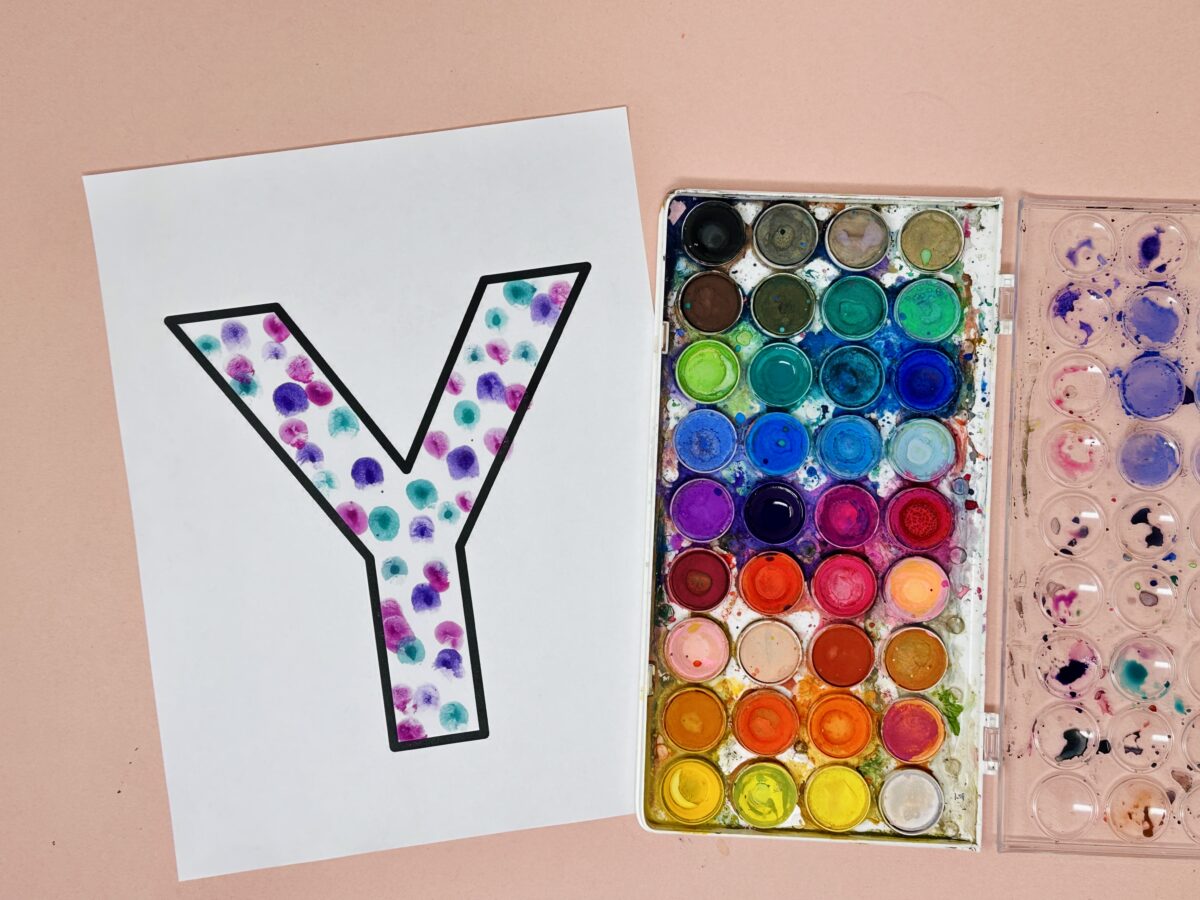
Young children will love getting their fingers dirty in this hands-on letter Y activity.
Required Materials
- watercolors or fingerpaints
- white paper
- letter Y template
How To
Draw or print out the outline of the letter Y onto a sheet of white paper. Get your child’s watercolor paints and wet them lightly with water (a spray bottle works great for this or gently brush water over them). Next, have your child press their fingertip into the paint and then press it down in the letter Y outline. Repeat this process until the letter Y outline is completely filled with colorful fingerprints.
6. Y for Yarn Activity
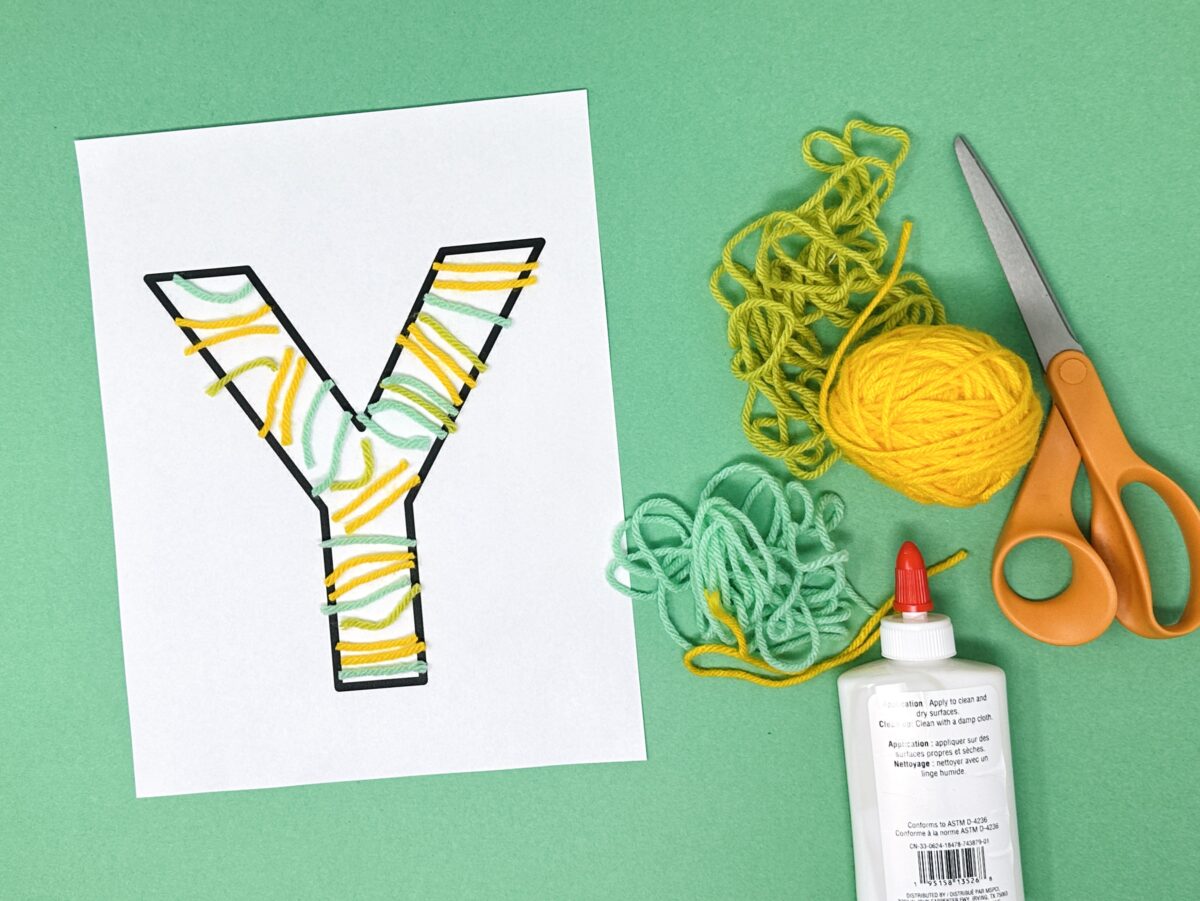
Bits of yarn create a fun, texture-focused letter Y craft that also builds fine motor skills!
Required Materials
- letter Y template
- yarn in different colors
- glue
- scissors
How To
Draw or print out an outline of the letter Y onto a white piece of paper. Work with your child to cut pieces of yarn that are about the same width of the letter Y outline. Have your child fill the outline with strands of yarn and glue them down. Add in some math practice by counting the number of yarn pieces inside the Y!
7. Y for Yes Craft
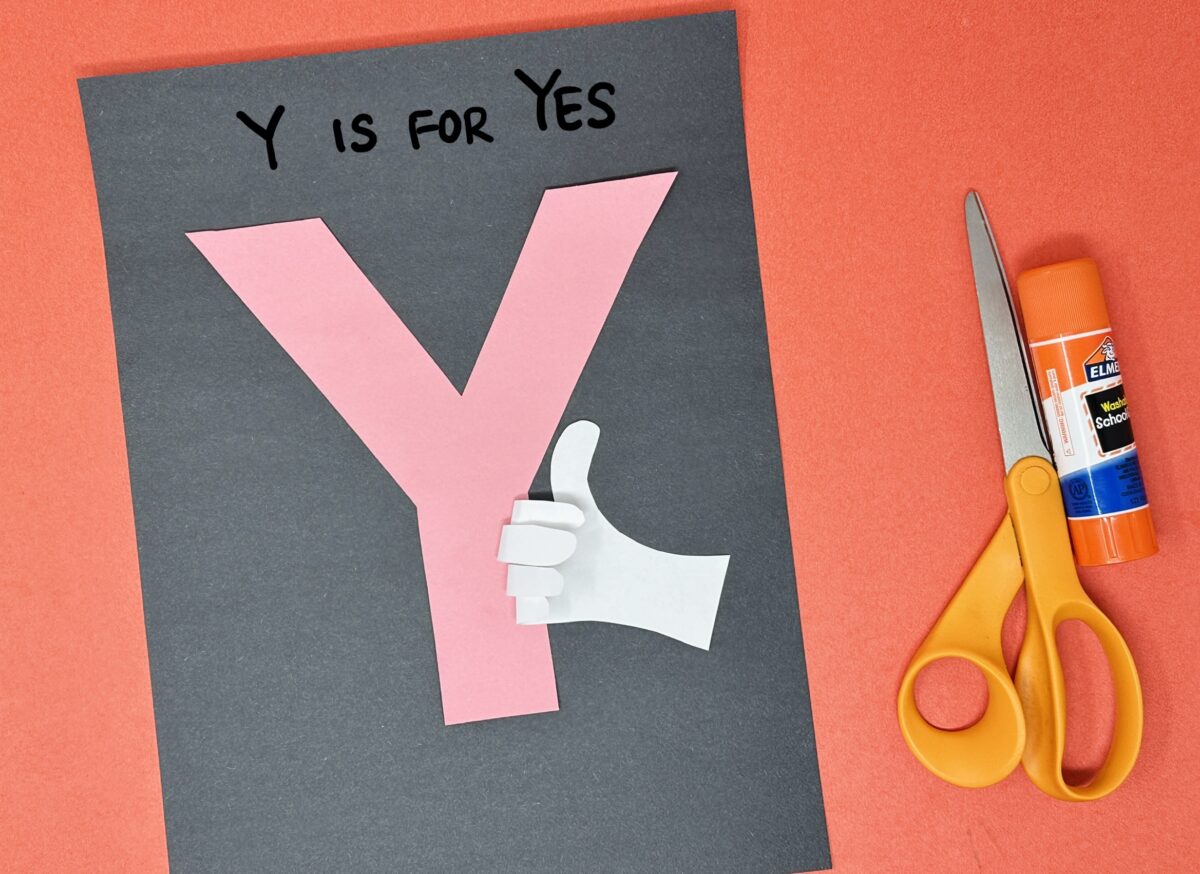
This craft gets a big thumbs up for helping kids practice the sound of the letter Y.
Required Materials
- various colors of construction paper
- marker
- scissors
- glue
How To
Work with your child to trace the outline of the letter Y onto a piece of colored construction paper, cut it out, and glue it down to another piece of paper. Then, take a third color of construction paper and trace the outline of your child’s hand onto it and cut it out, making sure to cut in between the fingers. Next, fold down each finger individually to form the thumbs up sign for Yes. Glue down the thumbs up next to the letter Y!
8. Y for Yellow Craft
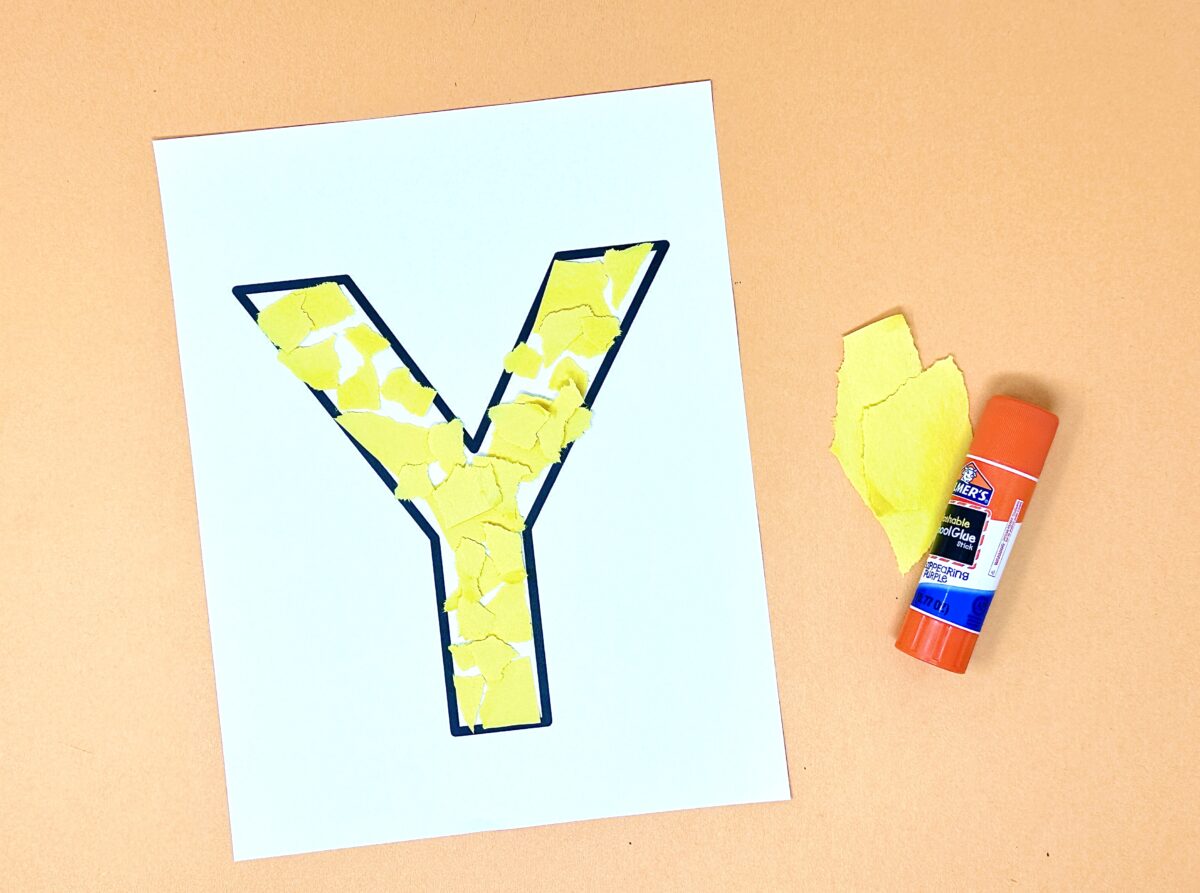
Help kids associated the letter Y with the color yellow (and the Y sounds) in this fun paper craft.
Required Materials
- letter Y template
- yellow paper
- glue
How To
Draw or print out the outline of a letter Y. Then, have your child rip up a piece of yellow construction paper into various sizes. Now for the tricky part – fill in the letter Y with all the bits of construction paper, trimming the edges that may hang too far over the outline of the letter. Then, glue them all down!
9. Y is for Yawn Craft

This letter Y looks ready for a nap!
Required Materials
- paper in two different colors
- white paper
- marker
- scissors
- glue
How To
For this letter craft, have your child pick a piece of colored construction paper and help you draw the outline of the letter Y onto it. Then cut it out. Next, use a
black marker to draw two closed eyes onto each of the arms of the Y. In the center draw a wide open mouth and color it in with black marker to create the look of a big letter Y yawn!
10. Y is for Yolk
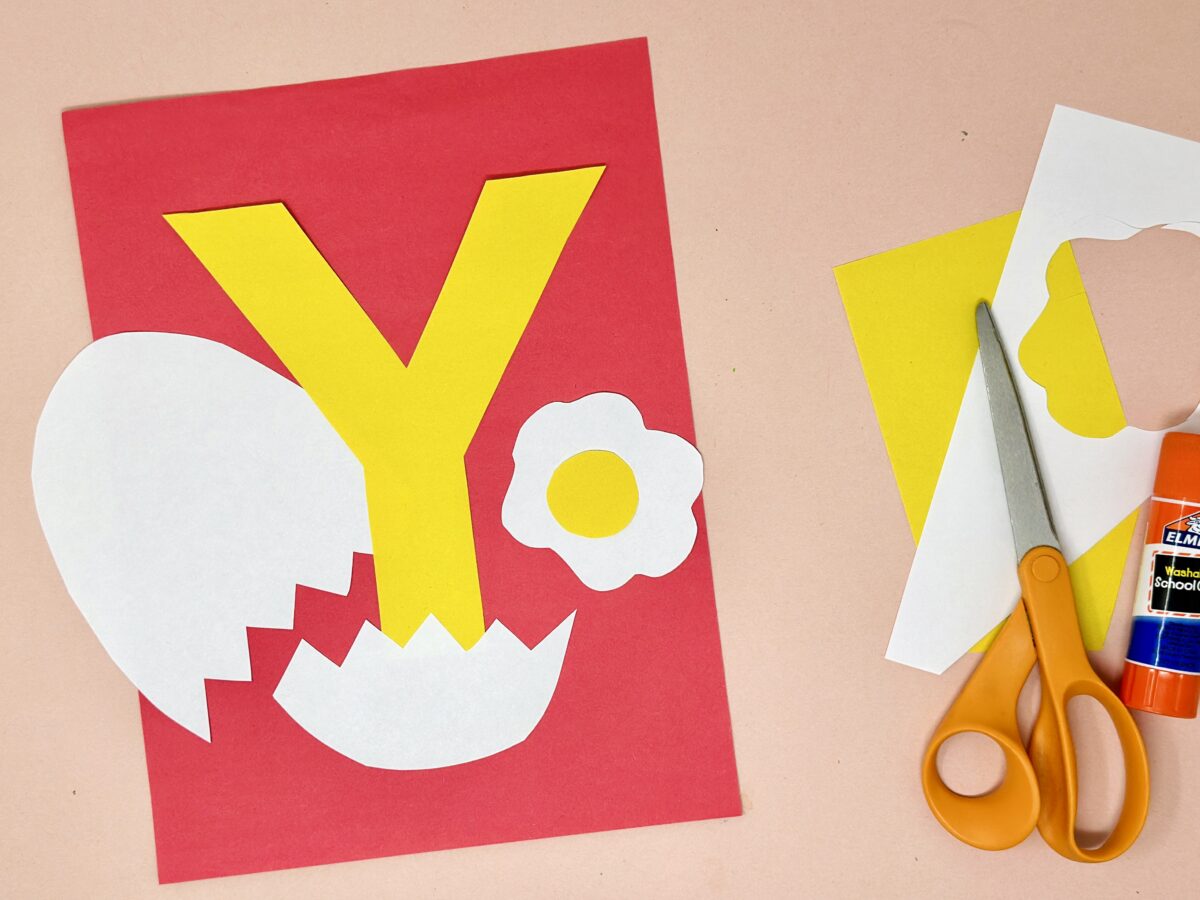
Crack open some creativity with the unique letter Y paper craft!
Required Materials
- white, yellow, and red paper
- scissors
- glue
How To
First, draw and cut out a large egg shape from white construction paper. Then, cut the egg in half with a zig zag line to create the look of an egg breaking open. Next, cut out the shape of a capital letter Y from the yellow construction paper and glue it down to the red piece of paper. Glue the two halves of the egg around the letter Y, making it look as if it’s hatching from the egg. For an added touch, create the shape of an egg with the white and yellow paper.
More Letter Y Fun
Delight your child with more fun ways to explore the letter Y, including:
The ideas, pictures, and copy for this post were provided by Smitha Katti from smilingcolors.com


Regular ABCmouse Usage Prevents Summer Slide and Boosts Literacy for Rising First Graders
Study shows that using ABCmouse leads to gains in literacy, reduced summer learning loss, and parent support of the program.
Key Findings Summary
- ABCmouse helped prevent summer slide in reading for children with regular usage compared to the control group.
- The more children used ABCmouse over the summer, the greater their learning gains.
- ABCmouse’s positive impact on reading scores was sustained through the following winter.
- A large majority of parents reported that ABCmouse had a meaningful impact on their children’s learning and that they support the use of ABCmouse in first grade.
ABCmouse Research Study Abstract
Summer learning loss can have a major and cumulative impact on academic achievement and disproportionately affect children from low-income households, who often have less access to learning resources over the summer. Approximately two-thirds of the ninth-grade reading achievement gap between children from high- and low-income backgrounds could be attributed to summer learning loss in the first five years of school.1
The purpose of this study was to test the impact of an online curriculum, ABCmouse.com Early Learning Academy, on “summer slide”: the loss of previously learned skills in reading and mathematics.††† A diverse sample of 999 rising first graders enrolled in Miami-Dade County Public Schools (M-DCPS) participated in the study. Children who were randomly assigned to the treatment group were given free home access to ABCmouse over the summer with a weekly minimum usage requirement of 45–60 minutes and 15 ABCmouse Learning Activities. Children who were randomly assigned to the control group were not given ABCmouse. To examine summer slide, we compared district-provided i-Ready assessment data in reading and math from spring 2016 and fall 2016, and we evaluated subgroups based on spring 2016 Stanford Achievement Test-10 (SAT-10) scores in reading and math.
ABCmouse helped prevent summer slide and contributed to a net gain in reading for children who completed at least 208 Learning Activities over the 12 weeks of summer (approximately 17 Learning Activities or 70 minutes of ABCmouse use per week), compared to the control group. The subset of treatment group children who met this usage threshold demonstrated significantly greater gains—approximating the benefits of one month of instructional time—during the summer, compared to the control group children (p < .05, Cohen’s d = 0.13). Importantly, these children showed sustained benefits from using ABCmouse, approximating two more months of academic instruction than the control group by winter of the following academic year (p < .01, d = 0.18).
ABCmouse Research Study Participants
In summer 2016, 1,214 children were consented by their parents or guardians to participate in the study from the entire M-DCPS population of 23,490 rising first graders. Eligibility criteria for the study were that participants must be enrolled in an M-DCPS kindergarten class in spring 2016 and have access to the internet and a computer or mobile device for regular weekly use over the summer. This sample (49% girls, 51% boys) was predominantly Hispanic (66%), 23% Black, 8.5% White, 1% Asian, and 1% Mixed or other, and 59% of the sample were enrolled in Title I schools during the spring of kindergarten.2 Across all M-DCPS elementary schools, 78.4% of children were eligible for a free/reduced lunch during the 2015–2016 school year.
Of the consented sample, 789 children were randomly assigned to the treatment group,3 with 608 families redeeming their ABCmouse codes, and 426 were randomly assigned to the control group, with 11 families subsequently deciding not to participate. After a search of the ABCmouse database that was performed at the end of summer, 24 children in the control group were identified as having some summer usage of the online program (completing at least one Learning Activity) and were excluded from the final analytic sample.
There were no statistically significant differences across any demographic variables in the final analytic sample (N = 999), the consented study sample (N = 1,214), and the overall M-DCPS population (N = 23,490). The consented sample’s SAT-10 reading and math scores were slightly but significantly higher than the average M-DCPS kindergarten scores in spring 2016 (p < .05). In the final analytic sample, initial mean spring SAT-10 reading scores (p < .01) and spring SAT-10 math scores (p < .05) were slightly but statistically significantly higher in the treatment group compared to the control group (reading: treatment M = 534.98, SD = 53.75 vs. control M = 522.82, SD = 57.07; math: treatment M = 531.45, SD = 44.87; control M = 524.17, SD = 44.07). However, differences in spring i-Ready scores, the primary outcome measure, were not statistically different among the final analytic sample, the consented sample, and the overall M-DCPS population (p’s > .10).
ABCmouse Research Study Design and Procedures
Children in the treatment group were provided with free home access to ABCmouse over the summer with a weekly minimum usage requirement of 45–60 minutes and 15 Learning Activities, preferably at Level 7 (early first-grade content). Parents received weekly feedback on their children’s usage via email. If usage fell below recommended levels, a reminder to encourage children’s usage was included in the email.
In addition, parents in both the control and treatment groups completed brief online technology diaries each week to report their children’s use of technology. At the end of the summer, all parents were asked to complete a 20-minute online survey regarding their views on the use of educational technology and the impact of technology on their children’s learning over the summer. All parent correspondence and surveys were available in Spanish. Parents received a $20 gift card for their participation in the end-of-summer survey. Control group children received free home access to ABCmouse for three months after fall i-Ready assessments were completed (September 30, 2016).
i-Ready assessment data served as the primary outcome measure for the study, and SAT-10 scores, a
comprehensive and nationally standardized measure, provided descriptive information on the achievement levels of the study samples to create subgroups of children (high scorers and low scorers) for analyses.
Overall, the 608 children who redeemed their ABCmouse codes spent an average of 985 minutes on ABCmouse (range = 0–10,523 minutes; SD = 1,082; M = 82 minutes per week), and completed on average a total of 203 ABCmouse Learning Activities (range = 0–2,472; SD = 246; M = 16.9 per week) from June 1, 2016 through August 22, 2016. Of those activities completed, an average of 158 (78%) were Level 7 activities (range = 0–1,270; SD = 196). Overall, participants completed approximately three times more reading activities during the summer (Mean = 128.8, Median = 74) than math activities (Mean = 44.6, Median = 19).
M-DCPS assessment data for the entire rising first-grade population revealed that a large percentage of children experienced a slide in their fall i-Ready scores; 44% of entering first graders had summer reading loss and 54% had math loss. On average, rising M-DCPS first graders gained 2.26 points on i-Ready reading scores and lost 3.35 points on i-Ready math scores from spring 2016 to fall 2016. For those children who slid in reading, the median loss was 16 points; for those children who slid in math, the median loss was 14 points. A loss of 4–5 points on i-Ready is approximately equivalent to one month of instruction during a 9- or 10-month academic year (30 weeks of instruction). National studies find that, on average, children have a loss of about one month of instruction over the summer.4
Because the spring i-Ready assessment was not given at the very end of the school year and the fall i-Ready assessment was not given at the very beginning of the next school year, these scores provide only a rough measure of summer slide. There could have been meaningful learning gains from school instruction that occurred in the final weeks of the spring semester and/or the first few weeks of the fall semester, “dampening” the measurable effects of summer slide. In addition, it is possible that children in the control group accessed ABCmouse during the prior kindergarten year and/or over the summer in public libraries, through summer learning programs, or at home through ABCmouse accounts that we were not able to identify.
ABCmouse Research Study Results
Finding 1: ABCmouse helped prevent summer slide in reading for children with regular usage compared to the
control group.
ABCmouse helped prevent summer slide in reading for children who completed at least 208 Learning Activities over the 12 weeks of summer (an average of 17 Learning Activities and 70 minutes of ABCmouse usage per week), as compared to the control group. As seen in Figure 1, children who met this usage threshold (“regular usage”) showed significantly greater gains over the summer compared to the control group, an average of 3.8 points more growth, approximating the benefits of one month of academic instruction.5 Multilevel regression models controlling for spring pretest reading scores, age, gender, race, and Spanish language at home confirmed this finding, with predicted score differences between groups of 4.7 points (B = 4.7, p < .05, Cohen’s d = 0.13).6
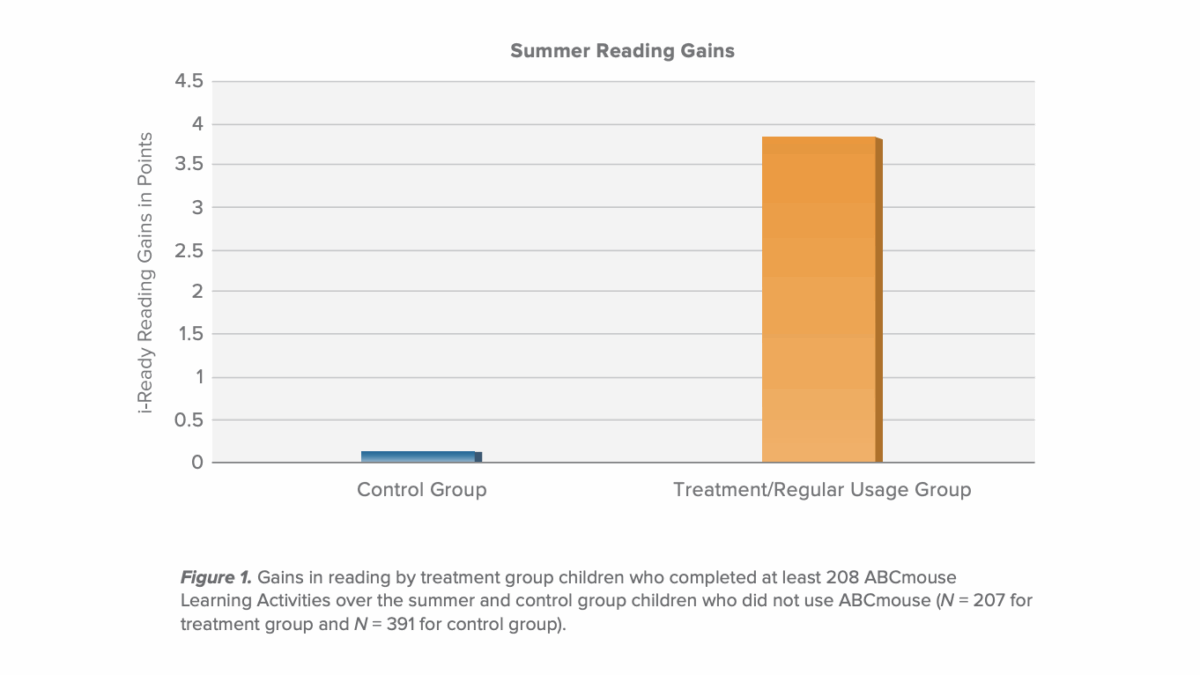
In addition, treatment group children in the higher usage group were less likely to experience a summer slide of one month or more (greater than 5-point loss) in reading (control = 40%, treatment/regular usage = 33%).7
An intent-to-treat analysis was conducted of all children randomly assigned to the treatment group (N = 789) or to the control group (N = 408).8 Overall, treatment group children showed a trend toward higher i-Ready fall reading scores compared to the control group, controlling for spring i-Ready reading scores and demographic variables (M treatment group = 417.10, M control group = 414.91, p = .23, d = 0.05). An analysis including only treatment group children who redeemed their ABCmouse codes (N = 608) and control group children who did not use ABCmouse (N = 391) found that the treatment group children showed a stronger trend toward greater gains in reading compared to the control group (M treatment group = 418.34, M control group = 414.07, p = .08, d = 0.10).
In the regular usage group, a lower percentage of children who scored below the median of the M-DCPS population at the end of kindergarten (M-DCPS population spring 2016 median SAT reading score = 509, median math score = 515) slid in reading than comparable low-scoring children in the control group (40% treatment vs. 48% control). However, this finding was not statistically significant in the regression analyses.
Finding 2: The more children used ABCmouse over the summer, the greater their learning gains.
A multiple regression analysis confirmed that the total number of ABCmouse Learning Activities completed over the summer positively contributed to gains in reading scores, controlling for spring pretest reading scores, age, gender, race, and Spanish language at home. For every 100 ABCmouse Learning Activities completed, we can expect a 1.1 point gain on i-Ready reading, which is approximately equivalent to one week of academic instruction, controlling for the effect of prior knowledge and demographic factors (B = .011, p < .05).
In light of the fact that children completed relatively few math activities on ABCmouse (less than 20% of the total number of Learning Activities completed), it was not surprising that no differences were found in math outcomes between the treatment and control groups. However, within the treatment group, a higher level of usage was associated with positive trends in math gains.
Despite significantly fewer completed math activities than reading activities, the difference in math scores between treatment group children who used ABCmouse the most and treatment group children who used ABCmouse the least indicated a meaningful positive trend associating ABCmouse usage with math learning, and approached significance: 3.2 points higher or approximating the benefit of several weeks of academic instruction (p = .08, d = 0.16; N = 124 for higher math users and 379 for lower math users). On average, children in the top quartile of usage over the summer completed 44 total math activities. This positive trend in math might have reached statistical significance had children completed more math activities during the study; there was also a steeper “slide” in math overall.
Finding 3: ABCmouse’s positive impact on reading scores was sustained through the following winter.
The benefits of regular ABCmouse usage over the summer were sustained through at least the first half of the following academic year. Using similar multiple regression models, controlling for spring 2016 i-Ready reading scores and demographic variables, children who completed a total of at least 208 activities over the summer continued to show higher scores, on average 8.03 points in i-Ready reading at the second assessment period (November 28–December 23, 2016), a benefit of approximately two months of academic instruction relative to the control group (B = 8.03, p < .01, d = 0.18; M regular user group = 451.80, N = 165; M control group = 443.54, N = 323).
Those children who met a threshold of 168 activities completed over the course of the summer months (averaging 14 Learning Activities per week over 12 weeks) also showed sustained gains, scoring on average 6.36 points higher in i-Ready reading in winter, an approximate benefit of 1.3–1.6 months of academic instruction relative to the control group (B = 6.36, p = .02, d = 0.20; M regular user group = 449.90, N = 209; M control group = 443.54, N = 323). Spring 2017 i-Ready data was not provided by the district.
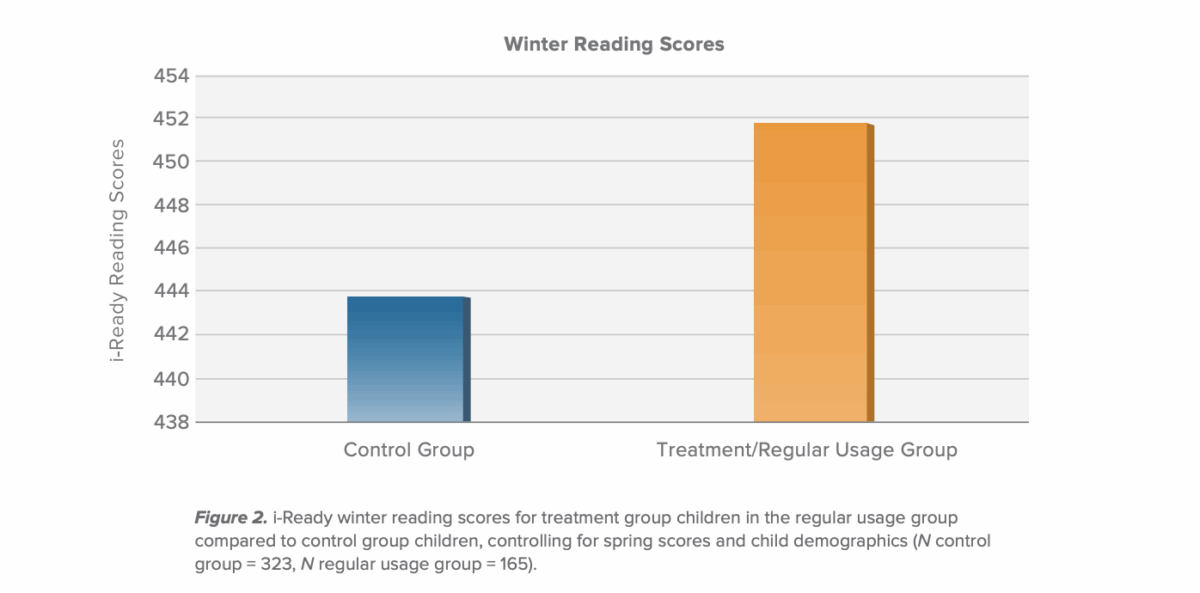
Finding 4: A large majority of parents reported that ABCmouse had a meaningful impact on their children’s learning and that they support the use of ABCmouse in first grade.
In a survey completed at the end of the summer, 82% of the treatment group parents reported that ABCmouse had a meaningful impact on their children’s overall learning, and 89% said they would support the use of ABCmouse during first grade. The majority (81%) were very likely or likely to recommend ABCmouse to parents of other children to help them prepare for first grade.
ABCmouse Research Study Conclusion
Overall, rising first-grade children in M-DCPS experienced a moderate amount of summer loss in reading and math during the summer of 2016. However, children in the treatment group with regular usage of ABCmouse experienced less summer slide and a significant net gain in reading as compared to the control group. These gains approximated the benefits of one month of instructional time. Gains were sustained through at least the first half of the following academic year. Children in the treatment group benefited more, approximating two more months of academic instruction by winter, from their regular use of ABCmouse during the summer months. The survey results indicate that the majority of treatment group parents support the use of ABCmouse for their first-grade children, and treatment group parents specifically recommend the use of ABCmouse to other parents.
References:
† Associate Professor of Psychology, University of Miami.
†† M.S. in Developmental Psychology, University of Miami; Ph.D. candidate, expected 2019.
†††This research was funded by Age of Learning, Inc. The authors were responsible for and had full control over study design, research findings, and this report.
1. Alexander, K. L., Entwisle, D. R., & Olson, L. S. (2007). Lasting consequences of the summer learning gap. American Sociological Review, 72(2), 167–180.
2. More than 50% of parents who completed the end-of-study survey reported household annual income of $50,000 or less, and another 15% reported $50,000–75,000.
3. Two-thirds of the children were assigned to the treatment group and one-third were assigned to the control group. In light of projected attrition, over-enrollment into the treatment group was done to ensure a sufficient sample size in the treatment group for analysis at the end of the study.
4. RAND (2011). Making summer count: How summer programs can boost children’s learning. RAND, Inc., http://www.rand.org.
5. There were no significant differences in spring scores between this smaller, higher-usage group and the overall treatment group.
6. Not all children completed both spring and fall assessments. Any missing data points were dealt with in the multilevel models through the use of Full Information Maximum Likelihood (FIML) estimation, a preferred method for handling missing data that uses all available data for each case when estimating parameters and is appropriate for handling the level of missing data in this study (Enders, C. K., & Bandalos, D. L. (2001). The relative performance of full information maximum likelihood estimation for missing data in structural equation models. Structural equation modeling, 8(3), 430–457; McCartney, K., Burchinal, M. R., & Bub, K. L. (2006). Introduction to the monograph. Monographs of the Society for Research in Child Development, 71(3), 1–8).
7. 50% of the control group children experienced some “slide” in reading compared to 44% of the treatment group children.
8. An additional seven children in the control group were excluded from this analysis because they were either no longer enrolled in M-DCPS or they were not yet enrolled in M-DCPS and were therefore without assessment data.
TM & © 2017 Age of Learning, Inc. All rights reserved. The names of other companies, products, and services are the property of their respective owners.
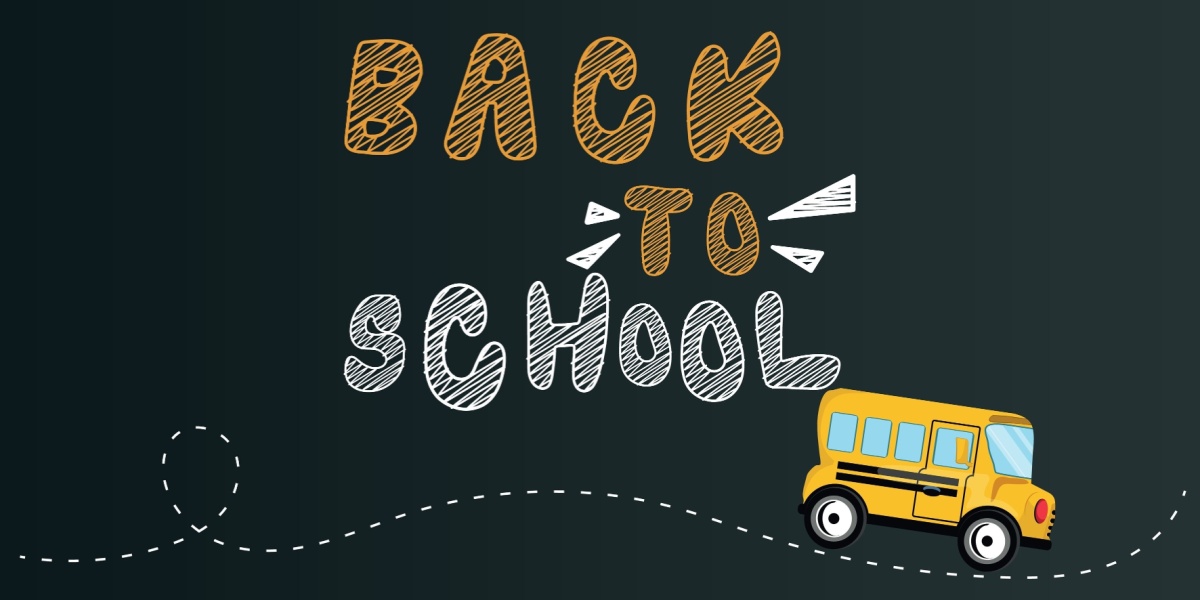
Free Printable Back to School Worksheets for Kids
Get ready for the new school year with free printable back-to-school worksheets designed to ease first-day jitters, build classroom community, and celebrate the start of new learning adventures. From icebreaker activities, All About Me printables, and classroom scavenger hunts to back-to-school word searches, Bingo, and coloring pages, these worksheets are designed to provide a variety of ways to welcome students and help kids get to know each other.
All About Me Worksheets
Make it easier for kids to introduce themselves with these free printable All About Me and All About My Friend worksheets. Print them out for the first day of school or anytime you want to spotlight a student. With space to fill in their favorite things and interests, classmates can quickly learn a few fun facts about each other.
Back to School Word Searches
Designed for kids of different ages, these word searches vary in difficulty and include themed vocabulary related to school supplies, subjects, and more. Print them out to have on hand in the classroom during the first week of school or anytime you need a quick or quiet activity.
Back to School Worksheets for Preschool and Kindergarten
Welcome preschoolers and kindergarteners to the classroom or help get them excited for their first day of school with printable worksheets featuring a back-to-school theme. From tracing to mazes and matching activities, these worksheets aim to boost critical thinking and fine motor skills.
Classroom Scavenger Hunt
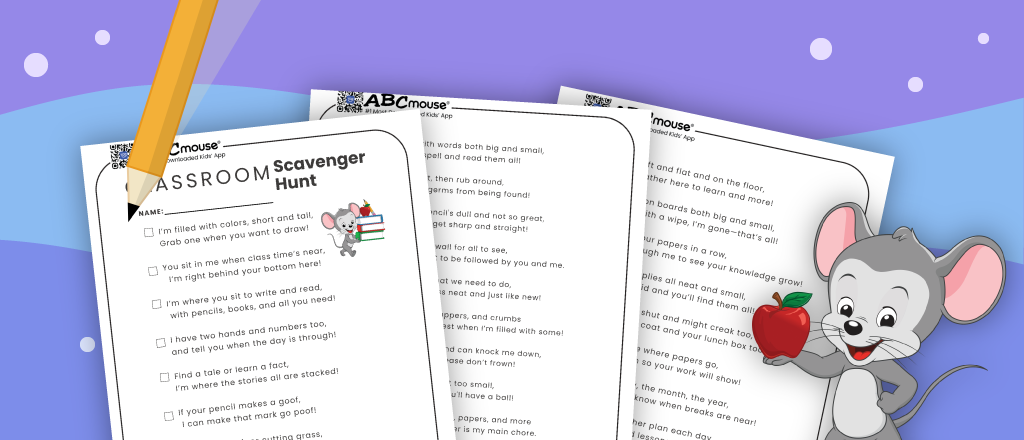
This free printable back to school scavenger hunt is a great way to help young students learn where important items are located in the classroom. It’s perfect for the first week of school, and if students work in pairs, it also gives them a chance to meet new friends and practice teamwork from day one!
Back to School Coloring Pages

Use these free printables to build excitement for the first day of school or as a peaceful classroom activity during the start of the school year.
Classmate Bingo Icebreaker Game
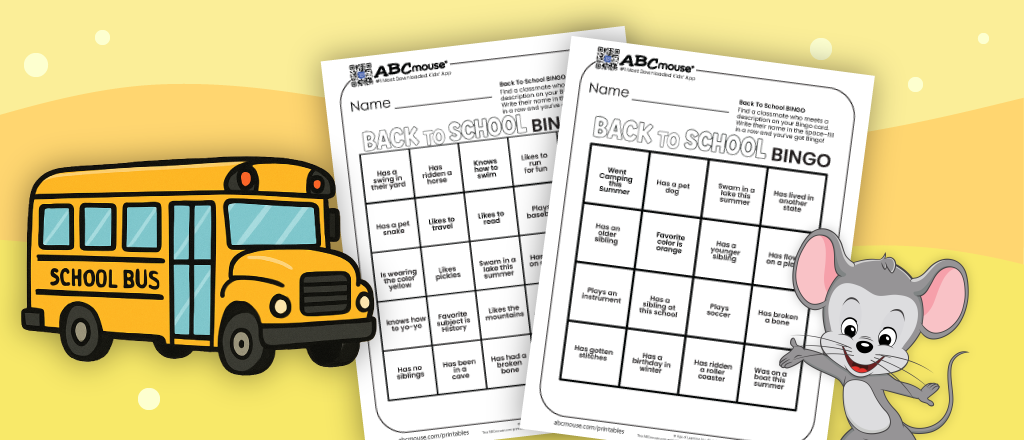
This version of Bingo provides a fun way for students to get to know each other. Print them out, then invite students to wander the room and chat with their classmates to see how many Bingo squares they can fill in.
Would You Rather Icebreaker Questions
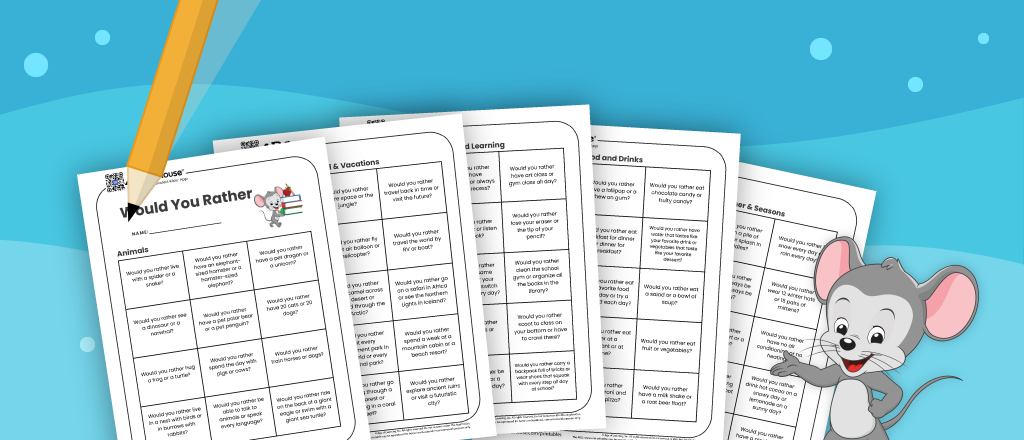
Would You Rather… questions are a great icebreaker to help kids get to know each other and their teacher on the first day of school.
Catchy Back-to-School Song & Video
Get kids pumped up for their first day of school with this engaging song that’s sure to have you singing along!

